

GOLF COURSE MAINTENANCE
10 | PUBLISHER’S PERSPECTIVE
GROOMING YOUR GREEN COMMITTEE
34 | EXECUTIVE COMMITTEE IRRIGATION FAILING? DON’T LET IT PARALYZE YOUR CLUB
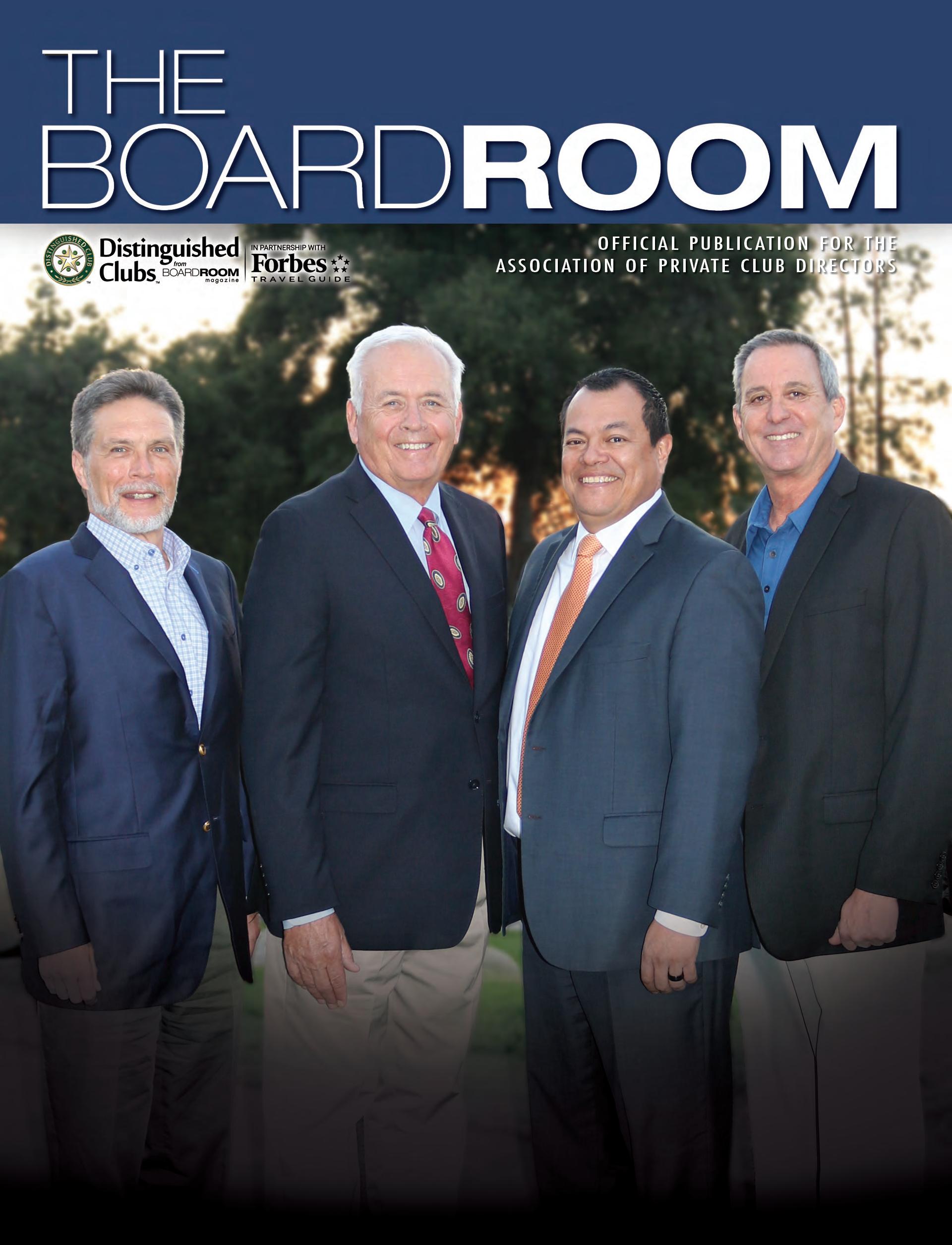
86 | GREEN COMMITTEE
ADAPTIONS TO OVERCOME CHALLENGES OF 2020
90-92 | INNOVATIVE IDEAS
BETHESDA COUNTRY CLUB, ROGUE VALLEY COUNTRY CLUB, SILVER SPRINGS GOLF AND COUNTRY CLUB
COVER PHOTO PICTURED L-R: Greg Pieschala, President BrightView Golf Maintenance; Richard Brumbaugh, President Glendora Country Club; Art Barajas, General Manager Glendora Country Club; and Kevin Neal, Vice President-West BrightView Golf Maintenance

THE MOST AWARDED F&B MANAGEMENT SYSTEM IN THE CLUB INDUSTRY

The world has changed dramatically since March, and the way we do F&B has changed with it. With volumes down, costs need to be carefully monitored. Tight control is essential to survival.
Use the FOOD-TRAK® System to:
u Maximize cash flow using ranked inventory level overstock reports
u Monitor raw material price fluctuations with price history comparison reports
u Find the best pricing with bid comparison reports
u Quickly react to falling menu profit margins with Red Flag reports
u Control waste, spoilage and portioning-related usage variances with ranked Management Summary reports
u Reduce labor costs with multi-function mobile scanning and interfaces to vendors, POS and club accounting systems
Plus many more tools to help vaccinate your organization from the many ripple effects of the virus. Our purpose and passion has been to help foodservice operators get as close to their ideal food and beverage costs as possible. We built the system, the implementation, training processes and the team of career professionals to help our clients do just that.
EDITOR’S NOTE
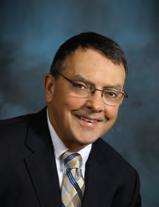
DAVE WHITE
Dave White is the editor of BoardRoom magazine. If you have comments on this article or suggestions for other topics, please send Dave an email to: dave@boardroommag.com.
Changes Abound for Course Superintendents
How are the greens playing? Fast…slow? What’s the Stimpmeter reading? What’s the cut on the fairway roughs?
Common questions often tossed out by golfers as they hit the links and certainly questions top of mind for golf course superintendents, who work hard satisfying golfers’ many demands these days.
That’s the thrust of our cover story – Golf Course Maintenance The Evolution of Best Practices and Outsourcing.
The changes have been significant, particularly over the time that some golf course superintendents, like Ted Horton of Menifee, CA, have spent prepping courses for golfers.
Horton broke into the industry in 1965 and how things are handled today is a far cry from the earlier years.
“A lot of practices have improved immeasurably,” said Horton. He says this evolution has affected not just what’s done on the golf course but also how turf managers and superintendents approach their work. Today, this means invoking best practices, greater environmental awareness and refining the approach for work on the golf course, including outsourcing a club’s course maintenance work.
That’s the bailiwick of BrightView Golf Course Maintenance and more and more courses across the country are using this approach for their course maintenance work.
“We do what our name says. We don’t run pro shops, we don’t set up tee times, we don’t prepare food; we just maintain golf courses,” said Greg Pieschala, president of BrightView Golf Course Maintenance.
As Pieschala points out, outsourcing course maintenance isn’t for every club, many of whom have their own in-house maintenance departments, but for a growing number, it’s today’s answer.
Outsourcing firms bring expertise, economies of scale and specialists to maintenance work that today is far more complex, with tighter regulations and more refined procedures. And all this takes the burden off a club in finding qualified superintendents, labor help and of course, buying expensive equipment.
So, does this takes the decision making away from a club? Not really, but a significant hurdle is making clubs and their members aware of what firms like BrightView do.
“We have to sell people on the concept and then we have to prove that we have the expertise to deliver what we say we can deliver,” Pieschala added. Much of this hinges on a well-developed plan that lets customers feel they’re still in control because there’s a plan. There’s communication and collaboration between the outsourcing firm and the club…and no hidden agendas.
It’s an interesting concept gaining more converts in the golf industry and it just might be a solution for your club.
n n n
Our 2020 BoardRoom “Excellence in Achievement” Awards are the only private club industry awards recognizing the clubs’ business partners. And our BoardRoom “Excellence in Achievement” Award recipients receive their due in this issue, specifically for their most recent achievements.
BoardRoom magazine’s industry peers review and select these outstanding suppliers and consultants, representing various aspects of the course and club operations. Winners each year are selected for overall excellence, achievements, innovation, vision for future growth, and continued impact on private club operations in their respective fields.
n n n
This issue also features introductions to 2019’s final top presidents: Jim Steinmeyer, President, Academy of Magical Arts, Hollywood, CA; Richard E. Straughn, President, Mountain Lake Country Club, Lake Wales, FL, and Steven Sunshine, President, Shady Canyon Golf Club, Irvine, CA.
Of course, this sets the stage for the selection and announcement of BoardRoom’s Top 2020 Private Club Presidents, from a growing list of entrants, in our 2021 January/ February issue.
We’ll have detailed information about BoardRoom’s Distinguished Club President and other presidents selected for their outstanding efforts with their private clubs.
n n n
As we approach 2021 (hopefully a much different year from 2020) we’re also prepping for BoardRoom’s 25th Anniversary of service to the private club industry, and our primary target market, a club’s board of directors.
BoardRoom, founded on the idea of identifying and taking away a pain, has weathered some storms along the way, as have many businesses involved in the private club industry. Today, as the number one publication for the private club industry, we offer the same advice… Replace Emotion with Fact, a message answered every issue with the sound, relevant and insightful articles written by our many contributors.
Cheers to another 25 years! BR
Publisher/CEO
John G. Fornaro
Editor/Co-Publisher
Dave White
Assoc. Editor/VP Creative/Co-Publisher
Heather Arias de Cordoba
Innovative Ideas Editor
Ellery Platts
APCD Executive Director
Bill Thomas
Editorial & Marketing Director
Dee Kaplan
Business Development
Joshua Nuzzi
Accounting/Subscriptions
Ronni Dana
Contact Information www.BoardRoomMagazine.com www.apcd.com (949) 376-8889
Featured Columnists
Rick Coyne
Henry DeLozier
John G. Fornaro
Bonnie J. Knutson
Contributing Writers
Bruce Barilla
Nancy Berkley
Bill Boothe
Shelley Caiazzo
Lisa Carroll
JaeMin Cha
Jarrett Chirico
Ronald F Cichy
Nicole Coughlin
Rita Craig
Michael Crandal
Stowell
Dave Doherty
Boris Fetbroyt
Susan Greene
Angela Hartmann
Larry Hirsh
Julia Kelly
MiRan Kim
SeungHyun “James” Kim
Billy Knight
Robert Krzak
Co-Founder/CEO John G. Fornaro
President
Keith Jarrett
Chief Analyst Frank Gore
Chief Information Officer
Jeff Briggs
Executive Director
Bill Thomas
Executive Assistant/ Director of Support
Joshua Nuzzi
Contact Information www.DistinguishedClubs.com (949) 376-8889

David W. Lacey
Lynne LaFond DeLuca
Melissa Low
Dave Moyer
Peter Nanula
Tom Neill
Mike Phelps
Ellery Platts
Whitney Reid Pennell
Strategic Partners and Allied Associations







Corey Saban
Steve Schendel
Eliza Selig
Michelle Tanzer
Meghan Thibault
Till von Ruexleben
Rich Wade
Kevin Walls
Gordon Welch










PUBLISHER’S
PERSPECTIVE | 10

GROOMING YOUR GREEN COMMITTEE
BY JOHN G. FORNARO
If there’s one thing at a golf club that triggers emotions, it’s the golf course conditions. How fast are the greens? How well are the fairways maintained? Have the greens been aerated? Do the bunkers need work? Are there too many trees? Who’s planning for the future? The evolution continues for golf courses, not only in design and structure but also in how clubs maintain their golf courses.

WHAT LIES AHEAD
BY RICK COYNE
In several recent blogs, I’ve mused on time management, the art of listening, risk management and driving the skills to focus on what is important. As most of you who write for newsletters understand, there’s often a commonality in the composite of your messages. For me, the commonality has been that the future is ours if we know how to find it. Think about that…
FOOD FOR THOUGHT | 64

WHEN F&B COSTS AREN’T “IDEAL”
BY BILL SCHWARTZ
The goal of all foodservice operations is to use only as much food or beverage as is required. This means no waste, no spoilage, no portioning issues, no theft, and perfectly executed recipes. It’s typically expressed as a number or percentage and is alternatively called the “perfect food cost” or the “theoretical food cost” or sometimes the “ideal food cost.” Unfortunately, that number is impossible to calculate accurately.
BOARDROOM BASICS & BEYOND | 12

YOU ARE ALWAYS PAYING FOR TRAINING
BY ANNETTE WHITTLEY
I’ve always had a passion, admiration and desire to be around the best. What I’ve realized is this: None of this is possible without training. Training day in and day out, training not only when it is fun or interesting, but when it is pouring rain, when you’re tired, when you’re stressed out, and you want to give up with every ounce in your body.
GLOBAL PERSPECTIVES | 18

LEADERSHIP COUNTS
BY HENRY DELOZIER
If members in your club seem skeptical, distrustful, frustrated, or angry, look in the mirror and into your club’s board room. Are members taking their cues from their club’s leaders? Certainly, some of today’s angst can be attributed to a global health crisis and delicate economic balance. These are trying times, to be sure. But we suspect that many waning attitudes can be traced to leadership.
MEMBERSHIP MUSINGS | 72

MILLENNIALS ON STEROIDS
BY BONNIE J. KNUTSON
In the early 1990s, two historians, William Strauss and Neil Howe, published the first of their several books on generational history. They determined that a generation lasts about 20 years, which is the length of time of one phase of a person’s life. They also determined that the members of each generation will always be connected because they shared life-defining experiences during their formative years.

IPA KEY TO MAKING GOOD DECISIONS
BY NANCY M. LEVENBURG
IPA is the acronym for India Pale Ale, a hoppy style of beer, and Importance-Performance Analysis, an easily applied technique developed by John Martilla and John James and used for measuring attribute importance and performance. Importance-Performance Analysis is what I’m talking about here.

DISCIPLINE IN THE COVID-19 ERA
BY ROBYN STOWELL
COVID-19 has changed many things in the club environment, but one thing that has not changed: Some members will not follow the rules. Another thing that has not changed is the bottom-line requirement for member discipline. We are making and remaking new rules as the coronavirus situation evolves. To be ready to apply member discipline appropriately, the following steps apply.
TRIBAL MAGIC | 94

RECOGNIZING WONDERFUL
BY GREGG PATTERSON
I’m an old, geeky, retired club manager who learned a great lesson during my operational years –wherever you are, whoever you’re with, whatever you’re doing, however long you’re there, recognize the Wonderful. And be thankful. Let me explain...



What Do Our Members Want That We Are Not Providing?
Lynne LaFond DeLuca


PGA’s Certification Program Vital for Pros and Clubs Special to BoardRoom

SeungHyun “James” Kim, MiRan Kim, JaeMin Cha, and Ronald F Cichy, O.M.,
PUBLISHER’S PERSPECTIVE

John G. Fornaro is the publisher/CEO of BoardRoom magazine, co-founder/CEO of Distinguished Clubs and the CEO of the Association of Private Club Directors (APCD). If you have comments on this article or suggestions for other topics, please contact John Fornaro at (949) 376-8889 or via email: johnf@apcd.com
Grooming Your Green Committee
If there’s one thing at a golf club that triggers emotions, it’s the golf course conditions.
How fast are the greens? What’s the Stimpmeter reading? How well are the fairways maintained? Have the greens been aerated? Do the bunkers need work? Are there too many trees? Who’s planning for the future?
A private club’s members will often confront the golf course superintendent and the club’s green committee members with these questions. But the fact is, the evolution continues for golf courses, not only in design and structure but also in how clubs maintain their golf courses.
Often the Green Committee is hampered because of several factors, including a short tenure for committee members, a penchant for micromanaging the club’s staff, and a perennial issue…committee members pushing a personal agenda or pet project.
So, what are the roles and responsibilities of the Green Committee?
There’s no question, a well-run Green Committee can be of great value to a golf club, so what must the Green Committee do to best serve a club’s members?
One fact is certain: “The Green Committee is not responsible for the daily operation of the golf maintenance operations. That’s the role of the golf course superintendent,” said Kevin Neal, vice-president, West, BrightView Golf Maintenance of Monrovia, CA.
“The committee members should also understand that they are not responsible for acting on the concerns of every individual member. They should not be responsible for making agronomic decisions on the golf course.
“And, they should not be responsible for making decisions surrounding course setup for club tournaments – that is for the PGA Professional, the tournament committee and the golf course superintendent. The Green Committee is not a ‘beautification’ committee. So, do not feel the need to leave a mark with a special flower bed, memorial tree, or bunker that doesn’t fit the master plan,” Neal opined.
David Larrivee, green committee chair at the Manchester Country Club, Bedford NH, in a nutshell, suggested, “The role of the Green Committee is to provide strategic guidance to the director of agronomy (DOA)
and general manager (GM) around BOD directives, and in general, membership feedback.
“The Green Committee should not be responsible for making any changes to the golf course that are not approved by the board of directors, and in our case, not part of the membership-approved LRIP,” Larrivee added.
Troon, the club management company, runs Manchester Country Club’s operations. When the clubs brought in Troon to manage Manchester, there was a transition with the Green Committee’s function.
“During my first stint on the board of directors back in 2005-2008, we were an internally managed club, and the Green Chair had a more managerial role versus a strategic one. When we hired an outside professional service company to run our operations (Troon), the role transitioned to its current (and more appropriate) role of leading a varied group of members in providing strategic oversite and membership feedback and input,” Larrivee explained.
“Our course is still rebounding from decades of Green Chair pet projects (i.e., planting trees, eliminating/moving bunkers) that resulted from well-intentioned, but poorly thought-out projects that didn’t fit inside the construct of a golf course master plan,” he added.
During his initial stint on the board, Larrivee chaired the club’s first long-range planning committee and part of the results from that effort yielded a membership-approved long-range improvement plan for the course.
“It laid out the framework for changes to the course to retain and restore the course to its original Donald Ross architectural heritage while improving it for all types of players (women, seniors and pros). In today’s world, part of the role of the Green Committee is to work with the director of agronomy and GM to recommend to the board course improvement projects, as part of the capital budget planning process, that fit inside the membership approved LRIP.”
WE DEPEND ON EACH OTHER
When founder John Morley established the GCSAA in 1926, he marked the occasion by saying, “No life is, or can be, self-existent. We depend upon each other.”
“While that statement has certainly held true for our association, it’s also true of every golf operation,” expounded Rhett Evans, CEO of the Golf Course Superintendents of America. “Superintendents can’t be successful without a support team and neither can the green committee. We depend on each other to make a golf club the best it can be.
“Anyone who chooses to be on a green committee has shown their passion for the golf course and should be applauded for taking on this challenging and rewarding role. The committee works closely with the superintendent, and the club benefits when that


BOARDROOM BASICS AND BEYOND
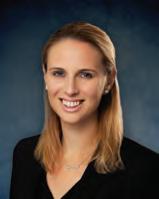
Annette Whittley is a consultant and search executive for Kopplin Kuebler & Wallace. She can be reached at annette@kkandw.com or (561) 827-1945.
You Are Always Paying for Training
“Whether we realize it or not, we are paying for training,” Jeffrey Kreafle, general manager/CEO at Congressional Country Club, wrote on my office whiteboard early on in my time as food and beverage director at the club. It has since become a mantra of mine.
I’ve always had a passion, admiration and desire to be around the best. My entire life, I have been fascinated with people who are at the top of their game, the best and the brightest who have the skills and confidence to perform to the highest levels. Additionally, I have always been drawn to hard work. Early in my career, this manifested by showing up for every extra task offered, every class, project, my hand was up.
I only applied to work for the best; a career with Four Seasons Hotels and Resorts working all over the United States led me to several amazing years at Congressional Country Club and now with the team at Kopplin Kuebler & Wallace.

In other parts of my life, the “training gene” has shown up in my drive for physical ability, running marathons, climbing mountains and hiking long distances.
What I’ve realized throughout is this: None of this is possible without training. Training day in and day out, training not only when it is fun or interesting, but when it is pouring rain, when you’re tired, when you’re stressed out, and you want to give up with every ounce in your body.
The fact is, no one becomes good at anything without training, without going out and trying to be better every single day. In fact, if you never train, you will never amount to much at all.
During my years as a food and beverage director, I was in environments where daily pre-shift briefings that were planned included tastings, handouts, quizzes and team interaction that were non-negotiable. We were held accountable for training themes daily, weekly, monthly, following a schedule, focusing on our weak areas, strengthening the things at which we were great and everything in between.
Like an NFL team watching their plays over and over after the game, we obsessed about things that went wrong. The sin was not making a mistake. The sin was repeating it over again. The good news is that within food and beverage, there are millions of mistakes to make; therefore, millions of ways we can obsessively get better a little each day.
The goal has never been to have zero mistakes. That’s impossible if you ever want to achieve excellence. You have to get very comfortable with failing. The goal was creating a learning environment where we celebrated both successes and failure, therefore learning and growing from both.
We would bring in subject matter experts, vendors, speakers, trainers, include team members who were passionate about particular topics. When mistakes were made, we talked about them in an open and honest environment. Every year we created a training plan and pushed to increase our budget for these things.
Now in my primary role as a trainer and consultant, I often hear that a team “does not have time or money for training.” I remind them that you can choose to pay for training by budgeting for it, planning it, building programs that fit it into every day and holding the team accountable to that standard, or you will end up paying for it through missed opportunities to deliver service and sell, glitches, waste, lower capture ratios in your restaurants, comp items and team turnover.
You simply do not become the best at anything without training and the choice as a leader is yours because, whether you are intentional about it or not, Jeffrey was right “You are ALWAYS paying for training.” BR
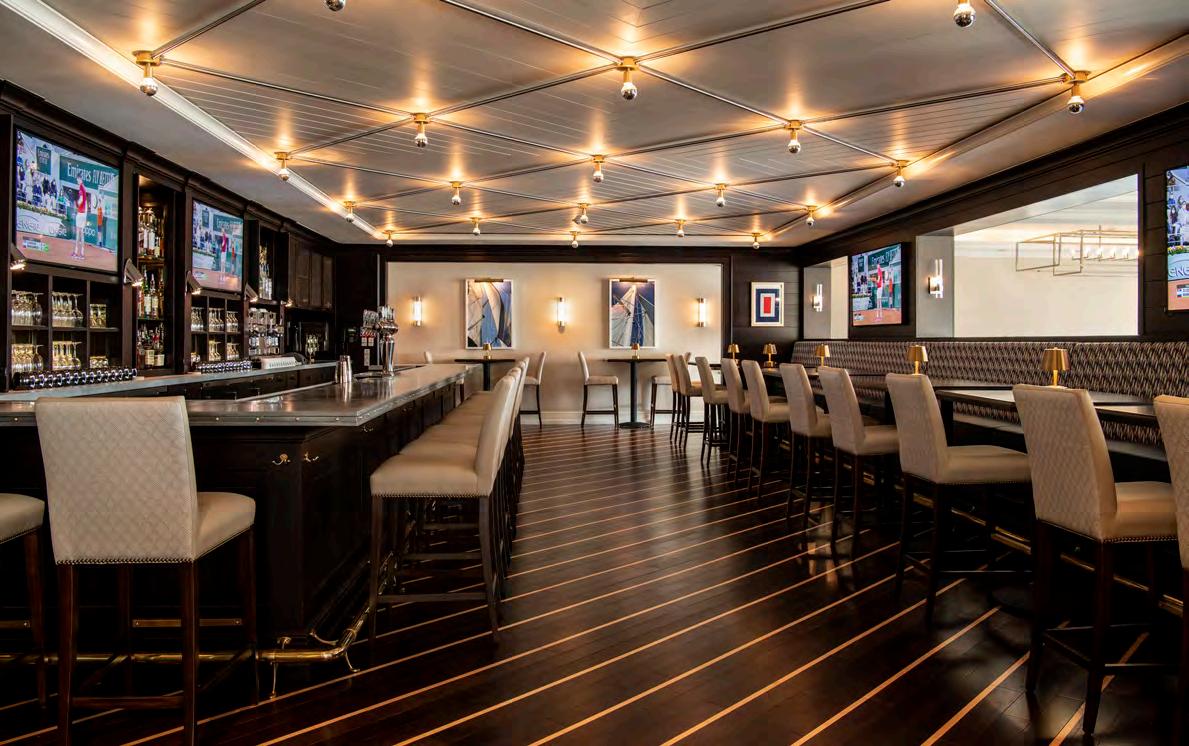




beach point club - mamaroneck, ny
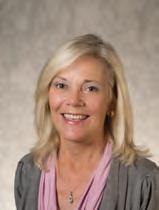
NANCY M. LEVENBURG
Nancy Levenburg, Ph.D., is a recently retired professor in the Seidman College of Business at Grand Valley State University in Grand Rapids, Michigan. She is the president of Edgewater Consulting, and is a member of Spring Lake Country Club in Spring Lake, Michigan. For more information, contact Nancy at: levenbun@gvsu.edu or (616) 821-5678.
IPA Key to Making Good Decisions
IPA is the acronym for India Pale Ale, a hoppy style of beer, and Importance-Performance Analysis, an easily applied technique developed by John Martilla and John James and used for measuring attribute importance and performance.
Importance-Performance Analysis is what I’m talking about here. Originally published in 1977 as a three-page article in the Journal of Marketing, Martilla and James’ IPA framework has been applied in scores of settings and various industries. IPA has been used to analyze hotel selection factors, the success of investments in information systems in the health club industry, and service quality perceptions of online library services.
In previous articles, I’ve argued that it can easily – and very successfully! – be applied in private club settings. IPA is important because making good decisions requires that the two measures (importance and performance) must be analyzed simultaneously. I cannot emphasize this strongly enough.
If the two are not considered together, decision makers (the private club’s board of directors, for example) are only looking at half of the picture – and considering only half (at best) of decision-making input. This can – and likely will – result in suboptimal decisions and a corresponding poor allocation of resources, which means dissatisfied members in the longer term.
Often using only one metric to make decisions while excluding or ignoring the other is an area where private clubs’ boards go astray – or are led astray by well-meaning but not terribly well-informed consultants that advise them.
Time and time again, they think that all they need to do to achieve that Big Hairy Audacious Goal of being the best country club in the region is to pose some satisfaction-related (“performance”) questions on the annual member survey and tally the results. For example, “… using a 1-5 scale where 1 = Very dissatisfied and 5 = Very satisfied, please indicate your SATISFACTION with the following aspects of the golf course… tee boxes, fairways, greens, bunkers…”
Then whatever item has the lowest total score (or lowest mean score) is identified as the one to focus on. Why? Because they’ll argue, it’s the area that members are most dissatisfied with.
So, let’s say that “bunkers” achieved the lowest total score. Does this mean that the board should engage in a major bunker renovation project?
Not necessarily, and here’s why.
First, think about this logically. Will your club ever get a really high satisfaction score associated with bunkers? I don’t know about the folks at your club, but I don’t believe I’ve ever heard the ones I play with whoop with joy when they’ve landed in a bunker. Particularly if it’s a fried egg. It just doesn’t happen.
Instead, they kvetch about the bunkers. In fact, according to Elliott Dowling, in a recent article published by the USGA, “Bunkers are arguably the most dissected and disagreed upon feature of a golf course. The way a bunker should look and play is seemingly always up for debate. Simply put, there is no perfect or ideal bunker.”
So, if bunkers are “always up for debate,” who’s to say if a bunker renovation project will result in any improvement whatsoever in golf members’ satisfaction with the course?
Financing is another issue. Assuming the board decides to engage in bunker renovation, who’s to pay for it? Is it to be financed out of available or “excess” course maintenance funds? (Exactly how many clubs have excess funds sitting around these days?) Or is it to be financed through a special member assessment?
Bunker renovation projects are not cheap. If it’s only satisfaction data that will drive the board’s decision making, should members know cost information when they complete their surveys?
By analogy, I’d say that what I’m least satisfied with at my home is the carpeting on the lower level. It would be nice to have wood floors. But am I interested in spending $10,000 to re-do the floors right now? The answer is no. Although the current flooring is not my “ideal”, I’m content with things as they are. Though I might not be 100% satisfied, I’m also not willing to spend $10,000 on new flooring.
The bottom line. Decisions that are driven strictly by satisfaction data can easily result in a misallocation of resources… all the more reason to measure “importance” at the same time you’re measuring “satisfaction.” BR
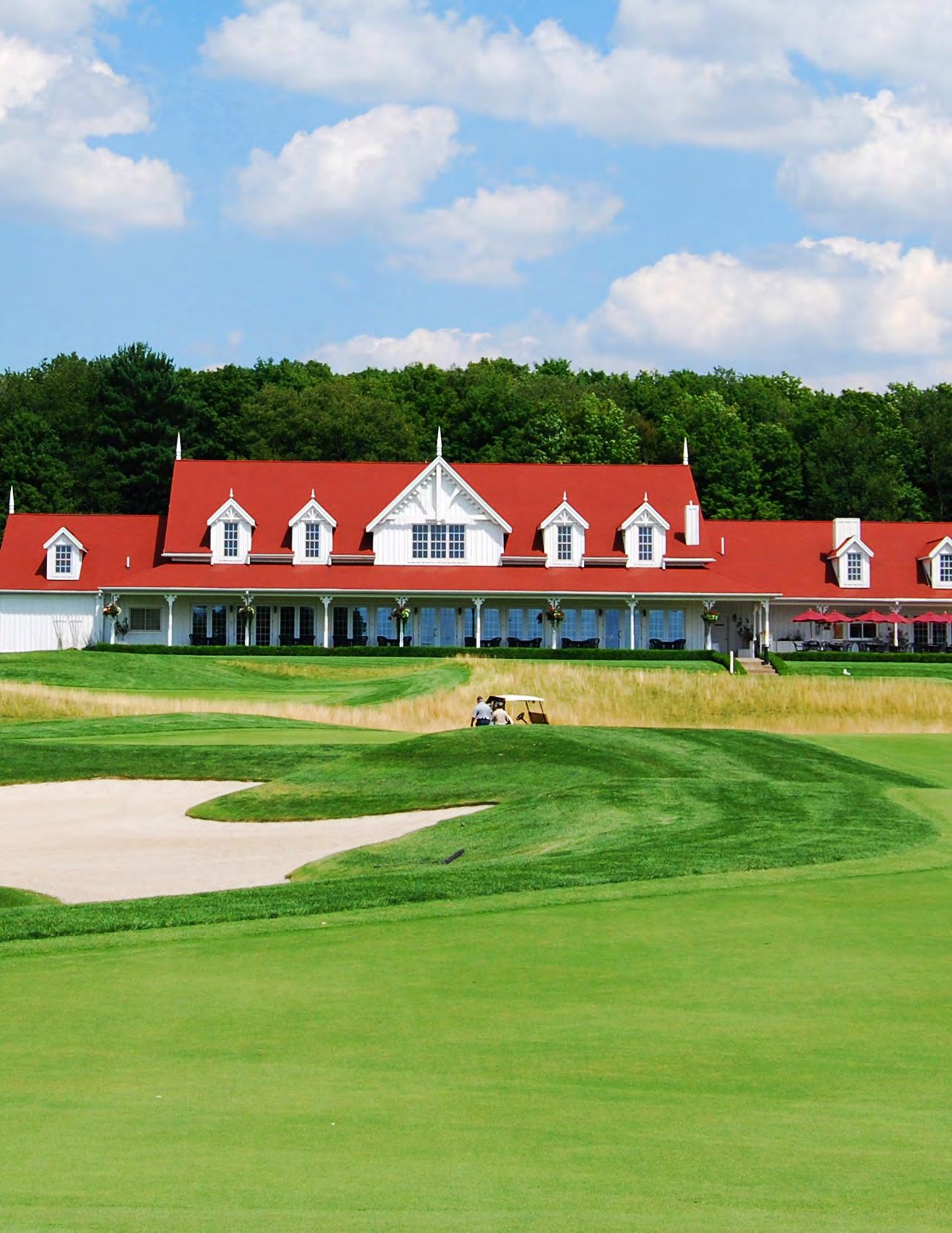
• DIGITAL MARKETING
• LIFESTYLE BRANDING
• MEMBERSHIP MARKETING

• AUTOMATED EMAIL STRATEGIES
• MEMBERSHIP RETENTION
• SOCIAL MEDIA MARKETING
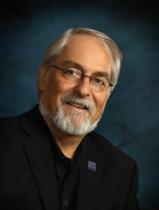
What Lies Ahead
RICK COYNE
Rick Coyne is president, ClubInsights. He can be reached via email: rcoyne@clubinsights.com
In several recent blogs, I’ve mused on time management, the art of listening, risk management and driving the skills to focus on what is important.
As most of you who write for newsletters understand, there’s often a commonality in the composite of your messages. For me, the commonality has been that the future is ours if we know how to find it. Think about that...
Reality number 1 – There are essentially four kinds of factors that can and do affect the private club industry and your club in particular. Global, regional, local and internal issues each influence members’ behaviors, tolerances and even their ability to afford or use the club.
The reality is that while it is incumbent on clubs to create strategies that recognize trends before they can materially or adversely affect operational efficiencies, all you control is what you do internally.
Being better informed, having systems to listen to members constantly provides empirical and overwhelming glimpses into future behaviors. The future is ours if we know how to find it….
Reality number 2 - As COVID-19 has made us painfully aware, the best strategies in the world couldn’t have predicted the devastation it wreaked on our lives. Yet tactically, the club industry, thanks to its ingenious and creative professionals, reacted brilliantly to retain member’s bond and sense of community with the club.
But, here’s the reality. Absorbed into a tactical world, vision and strategy are often displaced by a seemingly overwhelming daily burden. How many colleagues do we know that are overwhelmed with the day-to-day, barely keeping up with a tactically driven necessity?
Move off the tactical process, facilitate a strategy to deal with answering all the questions from members and add this lesson to your strategy workbook. All that you have control over is how you plan or react internally.
Reality number 3 - As we endure the effects of COVID-19, we see uncertainty, danger and even euphoria. Golf seems to have rebounded, memberships seem to have grown, but cash flow in many clubs has weakened.
The question on many minds is, what’s next? Which way will this end? a) We can’t control the global or regional process, and b) we can control our internal environment. The answer is as simple as asking your members. In national surveys we’ve facilitated over the past two months, there’s been an overwhelming response rate from club members – 85 percent was positive, very positive.
However, the other 15 percent demonstrated that there are issues that need to be addressed. These members are potentially at risk, even extreme risk. The reality is to gather empirical evidence internally, you have to ask the members in masse.
Members are starving to be heard. Clubs should be starving to understand what members are thinking. It’s a golden opportunity; their answers to the right questions will provide strategic information to better your operation, create confidence in your leadership, and ascertain risks to usage and retention. The ability to see your future….
Reality number 4 – Thinking positively for a moment, let’s make the assumption, the risks of COVID-19 will be better understood and its effects on people’s lives and businesses mitigated. A universal desire to be sure. Our recent surveys revealed that approximately three percent of members would not feel comfortable coming back to the club, even in a limited capacity, even after coronavirus vaccines have been in use.
Many members have indicated that interest in club membership was increased as a means for the family not traveling to have at least some form of social existence over the summer months. Others, wanting more outdoor opportunities after being sequestered for so long, rekindled their interest in golf.
The most frequently asked question I hear from panel discussions and webinars is. What will this look like after the danger has passed? The reality is that these trends are examples of behavioral patterns, patterns that, when identified, create opportunities.
Members will be eager, yet cautious about returning to normal. Every survey we conducted confirms this hypothesis. Twenty percent of members are ready to come back to full operation right now; the rest are eager but will have to ease into normalcy in stages.
You can’t control how, when, or why the pandemic will be lifted away. But you can control what you do internally. Tactically, you can follow your intuition or strategically you can be more certain of the outcomes by driving ongoing, consistent and valuable communication processes with your members.
IN REALITY
Time management, the art of listening, risk management and focusing on what’s important don’t require a crystal ball. Systematizing your club to frequent opportunities to engage member’s feedback is critical. While 85 percent or more of your responses will be positive, the other 15 percent can be converted to raving fans by simply acknowledging to them that their voice matters. The future is ours if we know how to find it! BR



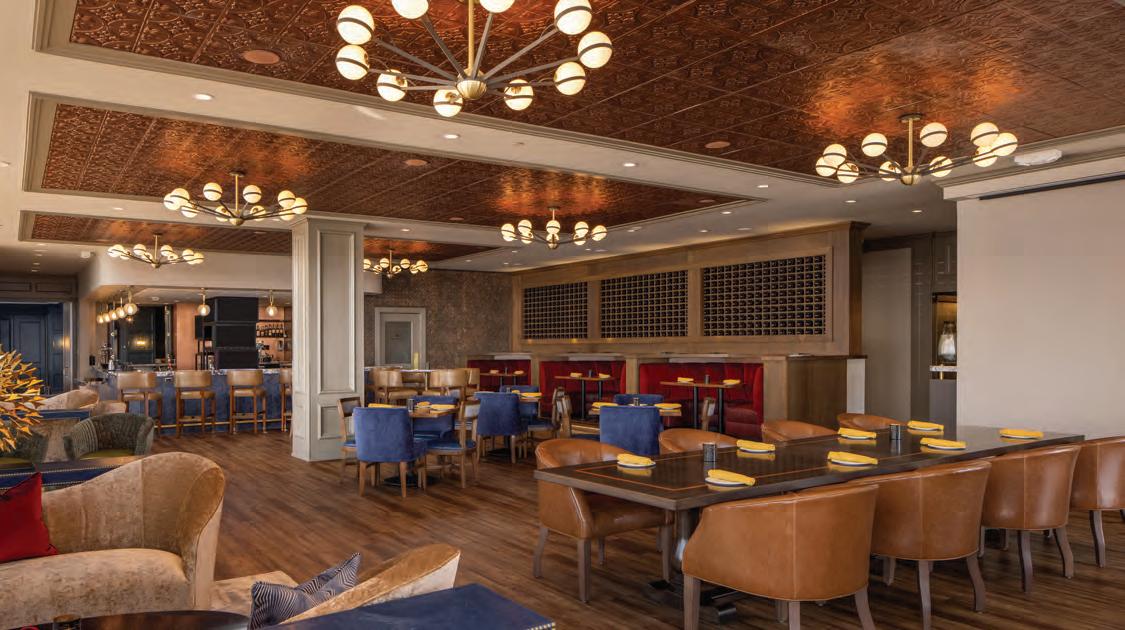

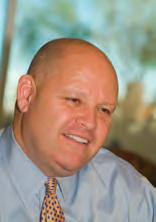
Leadership Counts
Henry DeLozier is a partner at GGA Partners. He can be reached via email: henry.delozier@ggapartners.com. For further information: https://ggapartners.com/2020/06/the-new-urgency-of-strategic-planning/
Attitude reflects leadership. If members in your club seem skeptical, distrustful, frustrated, or angry, look in the mirror and into your club’s board room. Are members taking their cues from their club’s leaders?
Certainly, some of today’s private club angst can be attributed to a global health crisis and delicate economic balance. These are trying times, to be sure. But we suspect that many waning attitudes can be traced to leadership.
If you wish to lead a club that exceeds its members’ expectations, evaluate four pieces of advice Jeff Bezos, the founder and CEO of Amazon, gives in his upcoming book, Invent and Wander: The Collected Writings of Jeff Bezos. The guidance is compiled from more than two decades of annual shareholder letters, speeches and interviews and provides leaders with valuable advice in turbulent times.
1. Focus on the long term. Build a strategic plan that will endure. In the company’s 2000 annual letter, Bezos noted that, “Our shares are down more than 80 percent from when I wrote you last year. Nevertheless, by almost any measure, the company is in a stronger position now than at any time in the past.” In other words, he had a plan and was sticking to it.
Strategic planning in many clubs is more a matter of developing a sources-and-uses-of-funds analysis than it is of developing genuine strategy. Sound strategic planning requires that boards and board members dedicate themselves to intentional planning, integrating evolving market conditions and trends and the club’s culture (mission, vision, and core values) with trustworthy governance and governing practices.
The financial leadership of the club and the board’s transparency in communicating its decisions are interwoven. Few clubs struggle solely on the basis of finance and access to capital. Clubs that struggle to be relevant to members fail in communicating the processes, priorities, and decisions of the board.
See more about the “New Urgency of Strategic Planning” for clubs in this GGA Partners whitepaper.
2. Obsess over customers. Bezos’s long-term strategy for Amazon is built around meeting and exceeding customers’ needs, which don’t include waiting for an Amazon customer service rep to answer the phone. In a meeting
years ago, with some 30 Amazon execs around a table, Bezos dialed the company’s 800 number only to be put on hold for four and a half minutes. While the cheerful music played, Bezos fumed.
In private clubs, where the customer is the member, many board members obsess over selling ideas to members before listening to members’ wants, needs and expectations. Conduct listening sessions as a conduit for members’ priorities into the board room. Members’ ideas must be considered, measured and integrated – when appropriate – into an established strategy.
3. Make bold, not timid choices. Bezos, who started Amazon in his Seattle garage, may have started small, but he never thought small. In an early shareholder letter, he said, “Our vision is to use this platform to build Earth’s most customer-centric company, a place where customers can come to find and discover anything and everything they might want to buy online.”
Is your club setting its goals high? Or, like most clubs, are your goals ones that are easily achieved to appease board members? Here are several goals worthy of most club leaders’ best efforts:
• Achieve and maintain a full membership roster. Membership dues are the financial backbone for most clubs, but roughly 90 percent of North America’s private clubs are not full. Creating a club relevant to its members and efficient in recruiting and retaining members is a top priority.
• Plan your club for a meaningful future. Private clubs are primarily a platform for socialization. Create a club that celebrates family, friendship, fun and fitness.
• Establish club governance that is trusted. Be discreet and accountable. Understand that the members you serve expect excellence of you and disdain mediocrity.
• Expand the brand reach of your club. Your club is a brand and must be managed with the same diligence and discipline as major corporate brands. Successful membership relationships are drawn to and from alert and consistent brand management.
Achieving bold choices is what separates the great clubs from others.
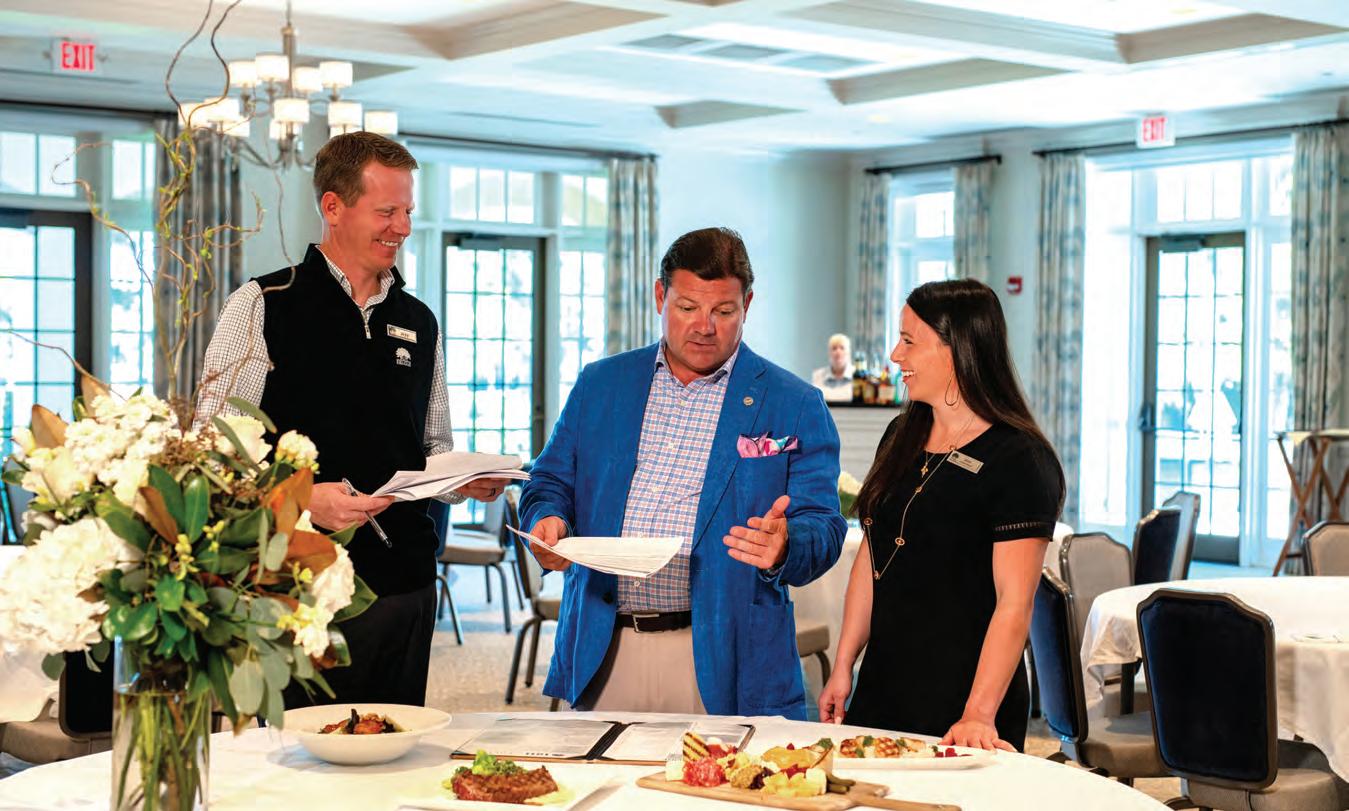


IDENTIFY AND HIRE TOP CANDIDATES
for key executive leadership positions by utilizing the expertise of the PGA of America’s Career Services department and Senior Consultant, Michael Leemhuis, owner of Leemhuis Consult LLC.

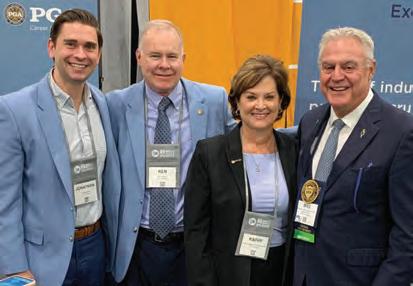
pgacareerservices.org/execusearch

GOLF COURSE MAINTENANCE
THE EVOLUTION OF BEST PRACTICES AND OUTSOURCING
The only constant in life is change – Heraclitus, a Greek philosopher
And that’s certainly true for the maintenance of golf courses around the world where the changes have been many. The evolution continues.
“A lot of practices have improved immeasurably,” said Ted Horton, of Menifee, CA, a retired golf course superintendent and principal of Ted Horton Consulting. Horton, who worked with Wingfoot Golf Club in New York, Westchester Country Club and Pebble Beach, before retiring in 2001, says, “There’s been significant change since I first entered the industry in 1965.
“I went to my first turfgrass conference in Tifton, GA back then, and the superintendents showed up in coveralls with braces and dirty work boots. That was my first exposure to my purported peers down the road. It wasn’t something I aspired to.
“Richard Tuffs, the owner of Pinehurst Resorts, was asked to speak about golf course maintenance. He said they didn’t keep records and could offer no information that made any business sense. With that in mind, I said I want to be different…more professional and talk the language of the people who are members of the club.”
Certainly, there have been significant changes in the intervening years. The evolution has affected not only what’s done on golf courses today but also how turf managers and superintendents approach their work.
“Now we have well-dressed superintendents, well-spoken, well-read, well-informed, up to date with information and who have business skills, “Horton explained.
“Their backgrounds and experiences today have prepared them for virtually anything – financial, computer and business skills. That’s the major change.”
How has this evolution of golf course superintendents affected what’s done on their golf courses?
“A lot of practices have improved immeasurable, for example, green speed, the ability to irrigate courses…to very precisely add water. The grasses have changed over the years with new varieties that are far more adaptable to circumstances and that’s important. And there’s also the improvement in the chemistry of pesticide controls,” Horton added.
“The biggest change has been the sophistication of irrigation, “Horton added. “The process is computerized with absolute precision, including the ability to measure the moisture of the soil before water is dumped on it.
“Most importantly, there’s much more environmental astuteness. This has improved immensely. We know the cause and effect and we know what’s doing within nature and that can make a significant difference.”
Another major change happening in the industry is outsourcing golf course maintenance to specialty companies such as BrightView Golf Course Maintenance, a division of BrightView Holdings.
“We do what our name says. We don’t run pro shops, we don’t set up tee times, we don’t prepare food; we just maintain golf courses,” said Greg Pieschala, president of BrightView Golf Course Maintenance.
The Calabasas, CA-based company handles the course maintenance for more than 80 golf courses across the U.S. “It’s not the usual way in which clubs maintain their courses. The vast majority have an in-house department. In addition to doing their own maintenance work, the clubs also buy or lease equipment,” Pieschala added.
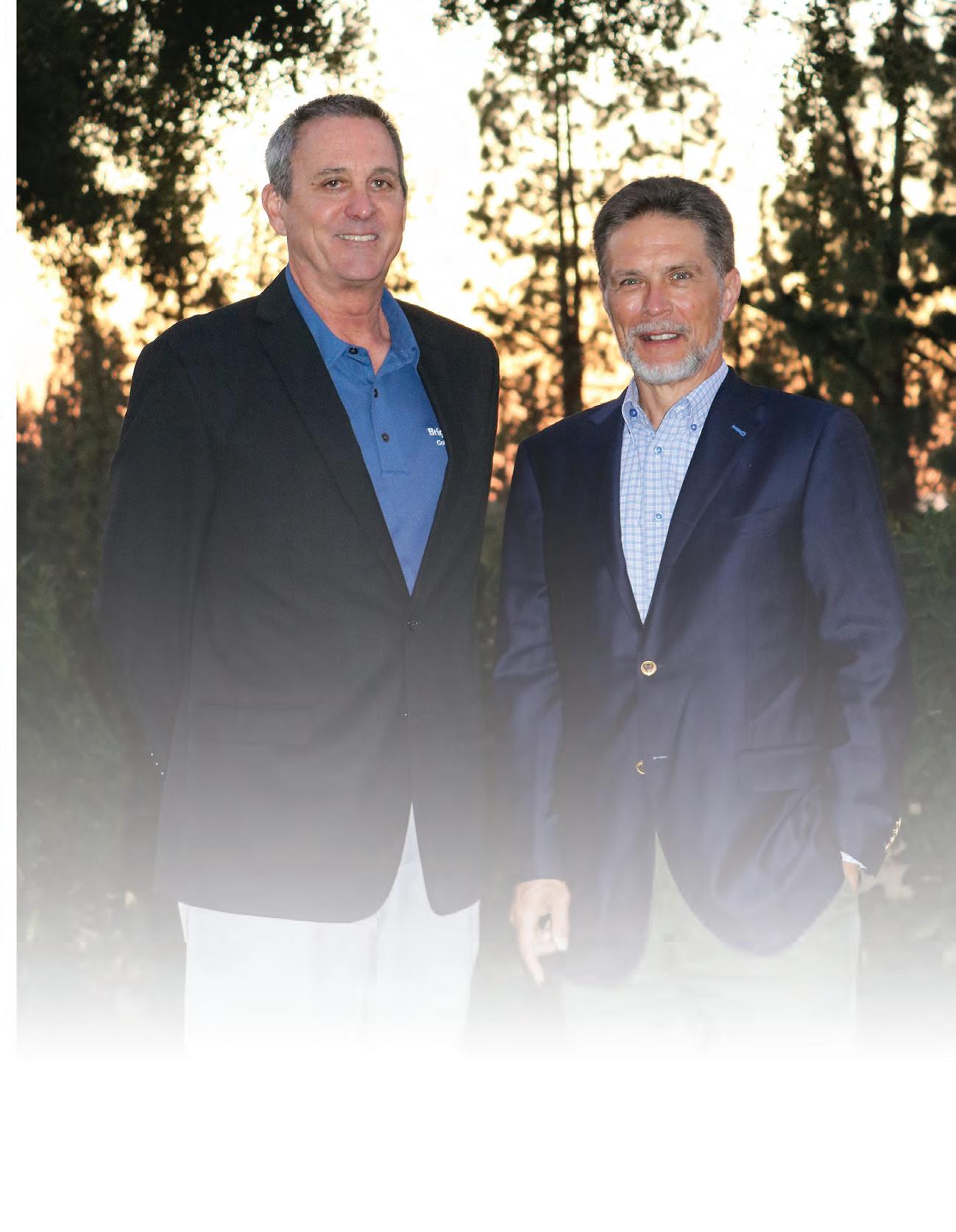
“What we bring to the table is deep expertise and large scale.” he added. “We can invest in being state of the art in all facets of maintaining golf courses from labor productivity to agronomic programs to worker safety. Our size lets us purchase goods, materials and equipment very efficiently.”
“It’s similar to the way club management companies, such a Troon, maintain golf courses. None of these companies operate a one-off business because there’s value in having an infrastructure for economies of scale, economies of expertise and people who specialize. We bring these advantages to clubs who want to control their own membership experience.”
“By our calculation, only three or four companies of any type maintain more courses than we do. We may be the largest company in golf that people are not familiar with or even heard about,” Pieschala opined.
“The course superintendent’s job is more complex as the chemistry and procedures are more refined, and regulations
PICTURED L-R: Kevin Neal, Vice President-West BrightView Golf Maintenance; Greg Pieschala, President BrightView Golf Maintenance
tighter. Labor regulations are higher, more stringent, for example, for safety and workers’ compensation. Superintendents, by themselves, need to be a real expert in half a dozen major disciplines. It can be a challenge. We provide support, systems and expertise to enable them to be the best they can be.”
“Typically, we hire the entire maintenance team when we begin working with a club, including the superintendent while preserving wages and benefits. We have a support team of certified superintendents and a Ph.D. agronomist that works with each superintendent to transition agronomic programs, work practices and systems to put out the dollar-for-dollar best conditions possible. This team also provides ongoing support and ensures that we are delivering the conditions that the club wants.
“Our biggest challenge is that most people in golf are not familiar with, or even aware of, this kind of outsourcing and don’t think of it when considering golf course maintenance. The initial reaction often is: Why would we want to do that? We need to work at increasing awareness and letting people know about the benefits we deliver, “Pieschala said.
SEE COVER STORY | 106
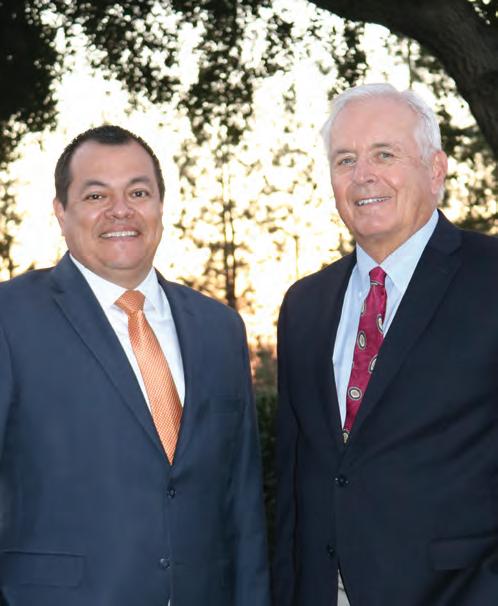
Publisher’s Note
BY JOHN G. FORNARO
Along with being publisher of Boardroom magazine and founder of BoardRoom Distinguished Clubs, I also was partowner of a 27-hole private country club in California.
The club was losing money and the quality of the courses wasn’t great, so I looked at every aspect of the club to see where we could cut costs, increase efficiency and improve our product. Our golf courses presented the biggest challenges and opportunities.
Our water bills were going up 15 percent per year. Staffing issues, wages and liabilities were also an issue. However, efficiency on the golf course happened to be the one issue that hit home.
I hired a company that monitored all the maintenance vehicles and mowers when they left the maintenance yard to maintain the golf courses. And I also was observing the maintenance staff. On almost every hole while the maintenance crew was cutting the grass, members were playing golf. The maintenance crew spent at least four minutes out of every 15 minutes waiting for the members to hit the ball.
What I learned was amazing. Cutting grass at the same time golfers were playing cut our efficiency to about 65 percent… 35 percent of the crew’s time was being wasted.
I then hired ValleyCrest (now BrightView) and their team of agronomists and experienced superintendents visited our club where I presented them with my data. Then they went to work.
After a day and a half, they provided me with more solutions then I could ever have dreamed off. Turf grass management has and will continue to evolve. Unfortunately, many clubs haven’t evolved.
Today, for modern day golf course superintendents, the job is getting harder than ever. Maintaining a golf course is the superintendent’s most important job. But for them, more and more time is being dedicated to administrative duties, managing paperwork and compliance with local and federal regulations.
Less time is available for them to be out on the golf course observing and monitoring efficiency. I believe strongly, golf courses maintenance companies can be a great solution for many clubs.
Brightview saved us over 40 percent on our water bill; we reduced our maintenance crew by 20 percent, and the golf courses looked better and was better maintained than ever. As well, our club no longer had to do payroll for the maintenance crew and no longer had the liability for them. BR


PICTURED L-R: ART BARAJAS, GENERAL MANAGER GLENDORA COUNTRY CLUB; RICHARD BRUMBAUGH, PRESIDENT GLENDORA COUNTRY CLUB


Health Wellness Research in Private Clubs in 2020
Club Involvement
By SeungHyun “James” Kim, MiRan Kim, JaeMin Cha, and Ronald F Cichy, O.M.,
What is the private club’s involvement in health and wellness business practices? That’s the question, we’ve asked in our latest health, wellness research.
In the July/August 2020 article in BoardRoom, we published health wellness research in private clubs, highlighting descriptions of our sample demographics, as well as their clubs’ characteristics. We also explained what we examined from our survey.
Our research, done before COVID-19, was conducted in collaboration with the Club Management Association of America (CMAA) and the Club Fitness and Spa Association (CFSA). This study is one of the first such studies with the two associations, led by Michigan State University researchers.
CLUB INVOLVEMENT
We asked participants to respond to the club’s “involvement in health and wellness business practices.” We were able to categorize the responses by themes, based on mean rankings. The results are:

These amplify a member focus. Healthy members are those who (presumably) stay as members for a longer time. They feel better because they are active. They link primary care physicians to describe the physical activity as part of their own health wellness programs.
They enjoy the club’s culture; it is making members aware of what they desire in health wellness and what the club provides to meet those desires. For example, healthy choices on the menus help promote healthy dining.

In order to build participation in various club programs, it’s essential to promote them, so members know about them. Media selection is based on age and the programs to be promoted. Younger members may be more likely to engage as a result of Instagram messages. Wearable devices, including GPS tracking, heart rate monitors, smart watches and trackers of activity, may appeal to some members.
Operating standards and procedures deliver consistency regardless of when the procedure takes place and who are the members and staff involved. Different age groups may prefer different activities. The board is the ideal set of members to be the role models. Same with committee members and committee chairs.
Role models help engage by demonstrating possibilities. Role models can also include other members, staff members, and board members. For example, if personal training includes a fitness assessment, S.M.A.R.T.E.R. goal setting one-on-one with a personal trainer can help customize the routines. This is the role model club volunteer leader.
The remaining comments in this involvement 2020 category included the communication of the health wellness importance to staff members or better TALENT. Ideally, TALENT should try various health wellness programs and treatments so they can properly explain the experiences and the features and benefits to inquisitive members.
In our responses, the lowest mean was, “Our club has various health wellness programs in place for our staff members.” This points to an opportunity to study this topic and identify best practices.
INNOVATIONS IN HEALTH WELLNESS
A listing in no particular order:
• Wearable devices: walking for health tied to wearable technology




EXECUTIVE COMMITTEE
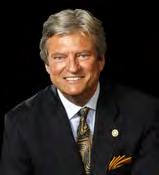
MICHAEL CRANDAL, CNG
The letters after our author’s name Michael Crandal, CNG stand for Certified Nice Guy. Self-certified, by the way. But, a nice guy nonetheless. Michael is co-author with Gabriel Aluisy of the groundbreaking book, The ABC’s of Plutonium Private Club Leadership. www.plutonium.club He can be reached directly at (760) 464-6103.
No Time for Disoriented Leadership
In light of the unprecedented challenges before all private clubs heading into 2021, there is no room for disorientation at any level of leadership.
What is the most important committee at your club?
The potential answers may seem variable from one club to another. Yet, there is a universally correct answer. Let’s follow the decision-making process.
The ultimate authority and responsibility of making meaningful and informed policy decisions rests with the board of directors. But the board is not a committee. A committee only recommends. A board makes decisions
Individuals make up the board. Now we can ask the question, “Where do those individuals come from?”
The most important committee at any club is the nominating committee that recommends individuals that make up the board. A close second is the search committee that recommends to the board who to hire as GM/COO to provide leadership to the entire club operations team.
Ideally, a new GM/COO will serve for many years. As a paid professional club executive - other than a very brief initial learning curve, they can and must very quickly hit the ground running and provide meaningful leadership. On the other hand, board members come and go and serve limited terms. While there is still a learning curve, there must be an accelerated process to bring them up to speed to make informed decisions.
All Plutonium private club leaders have an annual “new board member orientation” program in place. The process includes private meetings, written documents/reports and an in-depth tour of the entire facility before their first official board meeting.
Each club needs a structured process that reflects current times and the culture and traditions of its uniqueness. The important thing is to make sure every new board member can hit the ground running with relevant facts and information, providing them a foundation of knowing their role and contributing right from their first meeting.
A “New Board Member Orientation Handbook” personally presented by the club president and GM/COO during a private luncheon meeting is essential to success. All areas are discussed, followed by a thorough, complete tour of the entire club property that includes all employee areas, back of the house, maintenance facilities - everything!
New board members are always enlightened in ways that otherwise never would have been possible. They come away with a fresh perspective and appreciation of club operations’ many moving parts and complexities.
Here’s a representative of the scope of contents covered by a meaningful New Board Member Orientation Handbook. It can be augmented, customized and updated each year that best reflects every unique club. I’ve seen hard copy three-ring binders as well as new club-owned tablets given to the entire board with the following information.
Table Of Contents
COVID-19 (Overview) Policies in Place. Compliance. Priorities of Member and Staff Safety.
Our Mission Statement And Core Values
Now that you’re a director:
• D&O coverage
• Bylaws & club rules
• BOD policies/responsibilities
• GM/COO responsibilities/authority
• Organization chart
• Committee position descriptions
• Strategic plan
• Long-term financial plan
• Club operations & budget
• Capital reserve study and planning
• Board meeting procedures
• Representing the membership
• Working with management
• Current FY GM/COO executive summaries
• Current FY board minutes and Last FY auditor’s letter etc.
Every board member has a personal hardbound copy of The ABC’s of Plutonium Private Club Leadership. New members hit the ground running as a result of being exposed to the nuances of what it takes to operate and provide meaningful leadership. They will also gain insight into their role as a board member and what to expect from management.
Nobody likes to be disoriented. To make sure this word does not describe your club’s leadership, understand your two most important committees and make sure a meaningful New Board Member Orientation process is in place and updated every year. BR


Whether your club is back to business as usual or operating under temporary
CLUBS THRIVE
EXECUTIVE COMMITTEE

From Firefighting to Future Focus!
Your leadership style is revealed in the midst of a crisis.
Your club will be looking to you for direction, comfort and help in facilitating how to get through the challenge. The coronavirus has caused many, if not all of you, to change your clubhouse operations, develop new work schedules and plans to reposition your most valuable resource – your employees - to work in alternative ways.
No doubt, this is the biggest leadership challenge you have faced and the fact that it is unpredictable has made it particularly challenging. The reality is that for months, chances are you have been firefighting and losing sight of creating plans to ensure a successful future.
If you want to win in this ever-changing world and ready for the new next, be deliberate about planning for the long term. Consider taking the following steps:
Define what recovery means to you. One thing is for sure, we have all learned that pivoting fast has been critical to sustainability. But what does success look like in the future?
Now is the time to dust off your strategic plan and ask some of the tough questions. Is your mission still valid? Do you need a new vision statement? What has been the impact on your members and what feedback do you have from them?
Develop several planning scenarios and think about which ones you feel will most likely become a reality. From there, develop new plans to win in the “new next.” I can’t say the new normal because there will be more changes – that’s a given. Involve your employees. Chances are you employees are feeling a lot of
stress worrying about the long-term impact to their job, among other things. Because new developments happen non-stop, you must keep employees informed about what is going on even if it is to say, “I don’t have an answer.”
Always, always, communicate that you care as it truly is all about them! Your employees are your club…the face of your club…the ones your members come in contact with regularly. Involve them in planning. Who best to ask for input than the very people doing the job?
As a consultant who has helped organizations develop blueprints for success for years, I’m continuously surprised at the number of organizations not involving all levels in the organization in the planning process. Survey them. Ask for their input. Show them that you value their knowledge. It’s not only the right thing to do, but you will also have better ideas and it builds engagement.
Use a decision matrix. To help you systematically evaluate options, a decision matrix is an excellent tool and easy to build. Here are some steps you can follow:
1. On the left column, list the criteria you want to use to evaluate options.
2. Across the top, list the options you are considering.
3. Develop a scoring system. For example, choose the scale of 1 to 5 with 5 being the best option and 1 being a poor option.
4. Work with your team and identify the scores.
5. Add up your scores and the one with the highest score is typically the best option.
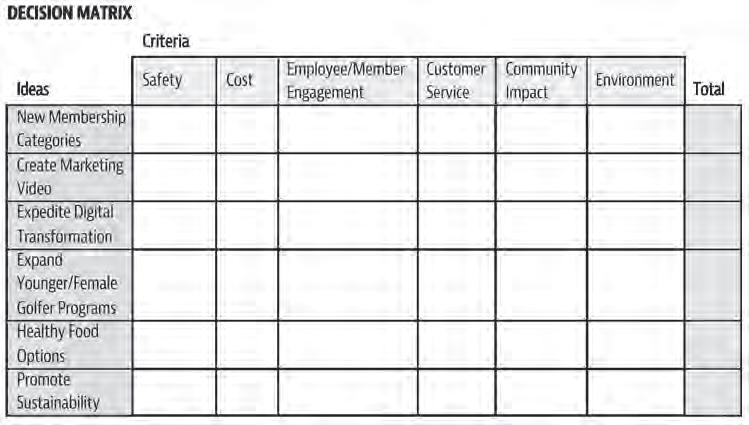
Revitalize your calendar. Over the past months, lots of events just got bypassed. Now is the time to celebrate what was missed! Think about creating new and exciting ways to involve members and employees in celebrating missed anniversaries, key milestones, and holidays. Consider how you can involve your suppliers, community, and others in creating beneficial relationships. What can you do to put your club on the map as the first? Be a class of one.
I challenge you to change the conversation to hope, excitement and demonstrate high energy! You set the tone. In the interim, know that this crisis will pass. I leave you with this challenge – look for the opportunity in it. Stay safe. BR


KOPPLIN
KUEBLER & WALLACE partners with the PROFESSIONAL TENNIS REGISTRY to expand their Member Career Services
“Mentorship has always been the cornerstone of my career. To now have our industry-leading KK&W team work directly with the PTR organization, which we believe has some of the most comprehensive education offerings in the industry for racquets professionals, is the perfect fit. KK&W will offer search and consulting services to PTR members and clubs,” said PTR and USPTA Master Professional Len Simard.
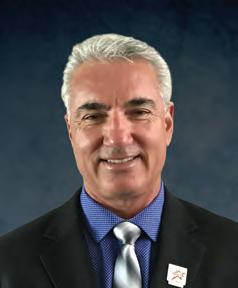
The Partners at KK&W are thrilled to be partnering with the PTR, believing that our union with the top total racquets industry association is a ‘win-win’ for all involved! Our ability to assist PTR professionals to continue to elevate their abilities and competencies, along with assisting clubs and racquets facilities to attract the best and brightest will help the industry to further enhance its delivery of outstanding racquets programs! Dan Santorum and Karl Hale have led this respected association to great heights, and we’re honored to partner with them to continue to elevate the profession and those professionals who make it such!

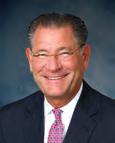
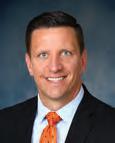
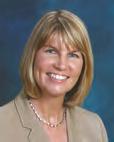

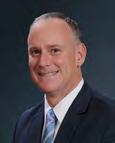

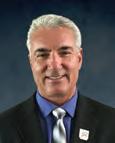
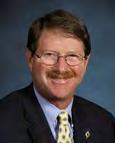


Specializing in GM/COO, CEO, Assistant General Manager/Clubhouse Manager, Director of Food and Beverage, Executive Chef, Director of Golf/Head Golf Professional, Golf Course Superintendent/Director of Agronomy, Director of Tennis/Director of Racquets, Fitness & Wellness Director, Chief Financial Officer, Director of Finance, Controller, Membership and Marketing Director Searches, and Consulting Services for Private, Resort and Developer Owned Properties, Clubs and Communities as well as Senior Living Communities and Property Owners Associations.



RICHARD KOPPLIN KURT KUEBLER THOMAS WALLACE
LISA CARROLL J. G. TED GILLARY
MICHELLE RIKLAN
JACK SULLIVAN
ANNETTE WHITTLEY ARMEN SUNY
LEN SIMARD
SAM LINDSLEY
EXECUTIVE COMMITTEE

What’s in a Name?
LARRY HIRSH
Larry Hirsh, CRE, MAI, SGA, FRICS is the president of Golf Property Analysts (www.golfprop.com), a leading golf and club property consulting, appraisal and brokerage firm based in Philadelphia.
Golf Course and Club Branding and Culture
We are living in extraordinary times. Social stresses from coronavirus, Black Lives Matter and an economic crisis have converged on our society and impacted our culture and social branding like never before.
Many TV commercials now focus on the safety precautions taken by advertisers to prevent community spread. Politicians (as usual) are divided on how to respond.
In recent weeks, we’ve seen the NASCAR auto racing circuit seek to modify its brand by banning confederate flags. The country music band formerly known as Lady Antebellum changed its name to “Lady A” to mitigate association with the era of slavery.
Athletes at The University of Texas have requested discontinuing singing of “The Eyes of Texas” at football games. The US Navy and Marines banned any use of the Confederate Battle Flag, a result of society’s current racial tensions. And recently, it was announced that the Quaker Oats company would be retiring the “Aunt Jemima” brand of pancake mix after 131 years because of social sensitivities.
Should golf courses and clubs consider being proactive?
Golf courses and clubs are similarly branded and often recognized by their names and logos. There are numerous clubs named for states, cities and towns, like Philadelphia CC, Oakmont CC, Boston GC, The Golf Club of Georgia and more.
There are clubs named for geographical features, like Mountain View, Twin Lakes, Bent Creek, Double Oaks, Four Streams and Mount
Snow. Of course, who could ignore Pine Valley, Pebble Beach and Cypress Point. Clubs named for golf course architects or famous golfers include the Jack Nicklaus Golf Center, Pete Dye Golf Club, Donald Ross Memorial, Robert Trent Jones GC and the Palmer Course at PGA West. Many courses are named for the property they occupy or its one-time owner, such as Hamilton Farm GC, MacArthur Club, Gillette Ridge GC and Kemper Lakes GC.
I know of at least one club named for the year (The 1912 Club) it was founded. The branding used in their logos is designed to be recognizable and often to project the club’s culture.
Old Works in Montana is named for the former site of the Anaconda Copper Mines. Furnace Creek in California is situated 214 below sea level and temperatures can reach 130 degrees in the summer. Brickyard Crossing GC is both adjacent to and inside (4 holes) the Indianapolis Motor ➤
At a time when our nation is enduring crisis, clubs with names, logos or worse yet admissions policies that are perceived as offensive to some are risking their brand –and their financial future. Golf clubs, especially private ones are very protective of their names, logos and tradition/history – rightfully so. Most (not all) private clubs have diversified their membership since the more exclusionary times, either from economic necessity or a sense of moral obligation. To some, the idea of political correctness is seen as an infringement on rights and there aren’t laws against socially or morally offending someone. Each has to decide if it’s the right thing for them by weighing the social and economic risks against the rewards.



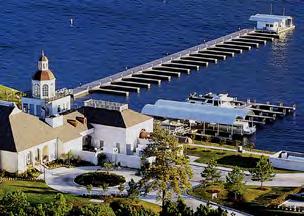

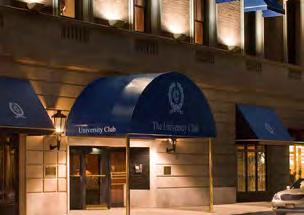










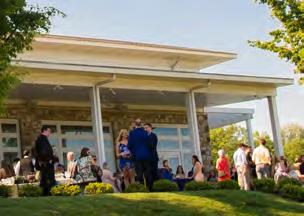



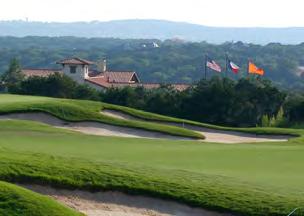
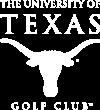


Speedway, commonly known as “The Brickyard.” Prison View in Louisiana overlooks the nearby state penitentiary and requires a background check to book a tee time.
New Jersey has The Architects Club, with each hole inspired by a different golden age course architect. Hideout, an upscale private club in Florida was conceived as a place for its members to seek refuge from the outside world.
Winged Foot is named for and shares its logo with the New York Athletic Club and Augusta National simply says what it is, a club with a national membership situated in Augusta, Georgia. Its logo suggests the same thing.
Other clubs are often named for the history of the property or the surrounding area. There are numerous courses named after Indian tribes that once inhabited the area and or significant historical events that occurred.
There are several golf/country clubs in my home state of Pennsylvania named for Indian tribes and sporting similar Indian head logos.
Native Americans have objected for years about the team names of the Washington Redskins, Cleveland Indians and other professional and college sports teams. This 2011 article in Golf Digest profiled the many clubs with Civil War monikers and connections, most all referring to a specific battle, landmark or event.
Most of these courses and clubs incorporate these characteristics into their logos, which are often used to generate revenues through the sale of merchandise bearing the club logo. As a result of recent events, some clubs are considering name and/or logo modifications in response to the long-held sensitivities that have been brought to the forefront of our national discourse.
At a time when our nation is enduring crisis, clubs with names, logos or worse yet admissions policies that are perceived as offensive to some are risking their brand – and their financial future. Certainly, social progress has occurred since the days when many clubs excluded persons because of race or a certain religious preference. Now, the ante is higher, and few clubs are positioned to absorb the potential social and economic fallout that a tarnished brand could create.
Many recall the National Organization of Women (Martha Burke) targeting Augusta National some years ago. That was about admitting women as members.
Golf clubs, especially private ones are very protective of their names, logos and tradition/history – rightfully so. Most (not all) private clubs have diversified their membership since the more exclusionary times, either from economic necessity or a sense of moral obligation.
To some, the idea of political correctness is seen as an infringement on rights and there aren’t laws against socially or morally offending someone. Each has to decide if it’s the right thing for them by weighing the social and economic risks against the rewards.
These risks are significant. Many private club memberships are populated with captains of industry and pillars of their communities.
In some cases, executives of publicly traded companies, small businessmen or political leaders make up a significant portion of the membership of many private clubs. They often constitute the core of the club’s culture.
Can these members risk the fallout of association with a club using an offensive name or logo? For those clubs who rely on outside functions (often sponsored by corporations, charities or other community groups) for economic vitality, can they risk their outing and function clientele seeking alternative venues because of the name or logo? The value of both membership and the club itself can be impacted.
All clubs should take the proactive step to (at least) sincerely examine whether their name or logo is offensive to anyone. If they wait until there’s another Martha Burke seeking “trouble”, it’s too late.
At that point, the club(s) being targeted risks losing a significant number of those prominent members who need to avoid association with the controversy. That’s an economic risk that few clubs want, and few can absorb.
Whether a club’s name or logo is offensive is a potentially endless debate. For some clubs, it’s a social/moral issue and for others the economic issue. For some it could be both.
For Augusta National in the Martha Burke situation, Augusta could absorb the economic fallout. Most clubs probably can’t if the protest is loud enough. Any club potentially targeted for being perceived as insensitive can mitigate that risk by proactively implementing changes before being targeted. Some food for thought! BR


EXECUTIVE SEARCH
GBN recruits the most accomplished General Managers, Directors of Golf and Head Professionals from across the golf industry. Our search team diligently researches, plans, recruits and coordinates all aspects of the recruitment process, which ensures exceptional results. We have intentionally combined the highest level of industry experience with global expertise in executive search. The result is an unparalleled outcome for our clients.
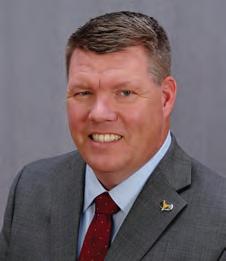
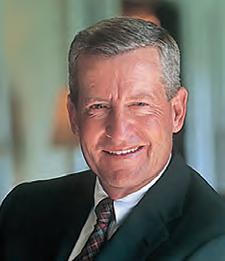
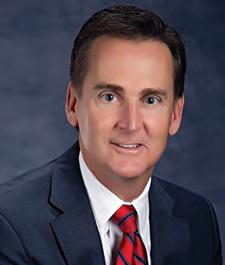
“The executive search process was well-executed with timely updates and coordination. I was very impressed with the communication, updates, and accessibility. Any club would benefit from their contacts, resources, and experience in the business of golf.”
Nick Jacovides, Club President - Bayville Golf Club

For more information, please contact Patrick Seither at 919-372-8220
Patrick Seither PRESIDENT/CEO
Bob Ford PARTNER
Dave Ransom PARTNER

Irrigation Failing?
Don’t Let it
Paralyze Your Club
Never in my wildest dreams did I think I’d have so much to say about irrigation renovations.
Three years ago, I was membership director at Anthem Country Club in Las Vegas, where an old irrigation system – and the club’s inability to effectively develop a replacement/renovation plan – resulted in significant agronomic/operational concerns.
Sound overly dramatic? Well, this is the desert. Without functionally efficient irrigation, the source of all life, our golf course was suffering. Every year it was “hold your breath and try to make it through another round of overseeding.”
Members naturally took notice of the deteriorating course conditions. Some picked up and left. Then the general manager and the course superintendent resigned, simultaneously, which only compounded the chaos — most of it thanks to an old irrigation system whose replacement we couldn’t figure out how to pay for.
I’m here to tell you: Don’t let this happen to you.
The situation is perhaps more acute here. Las Vegas may be the most demanding golf course irrigation market in the country. The soil is terrible for growing grass. It’s even worse when it comes to laying new irrigation pipe — thanks to all the rock.
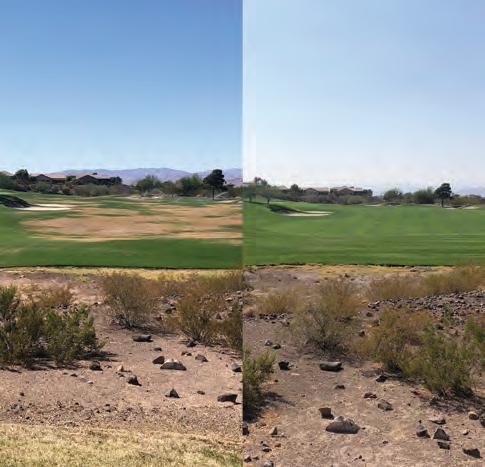
Shelley Caiazzo is general manager of the Anthem Country Club in Henderson, Nevada. She can be reached at: 702-614-5001 or via email:scaiazzo@anthemcc.com
Terrible water quality takes a heavy toll on systems that, because of the arid climate, are running virtually every night, all year long. At the same time, terrifically high water costs put a massive premium on the system’s efficiency.
Our irrigation renovation had been up for discussion since 2014. Financially, we just couldn’t make it work. We had tried to get it done in four phases to mitigate cost. But that led only to delay and ultimately to a very complicated bid process that went poorly.
The turning point happened in spring 2018. A new superintendent, James Symons, arrived from the property across the street. I arrived, as the new GM, from just down the hall. The Anthem CC board also saw fit to retain Arnold Palmer Golf Management/Century Golf Partners to consult on club matters. APGM came in and said, “We need to sell this number of memberships at this price, which will generate the additional capital dollars needed to kickstart this irrigation project, without an assessment.”
And you know what? That’s precisely what happened. They arrived in May 2018, and we began the membership drive that September. Then it just took off. We added 50 new members in the ensuing 12 months.
News of these sales, and the fading specter of a massive irrigation-related assessment, had an immediate effect on the existing membership. The will to move ahead with what needed doing replaced rampant gossip. Every year we were putting Band-Aids on that old system. James and I felt it was critical to go forward with this. Ultimately, the board and membership agreed.
The club broke ground on the new irrigation system in November 2019. We selected The IC System from Rain Bird. Heritage Links, the Houston-based contractor, installed it. And then came COVID-19, but that didn’t stop us either. All 18 holes reopened for play just as the lockdown was lifted on May 1, 2020.
The timing was no accident. Heritage Links had gamed out an ingenious strategy that allowed us to work on one hole at time, keeping the old/existing irrigation system working and never completely closing the golf course. Like so many in America last spring, our club experienced a massive influx of play starting in March. With all these new members and all this COVID play, we had to keep the course open.
We made dozens of decisions that helped make this project a success, but two stand out for me. First, we listened to our irrigation designer Bob Bryant. He worked so hard to make this project feasible from an engineering and staging perspective.
SHELLEY CAIAZZO






EXECUTIVE COMMITTEE
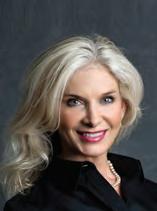
Lessons in a Time of Covid
JULIA KELLY
Julia Kelly is vice president of sales & marketing for Troon. She can be reached at jkelly@troon.com and (480) 477-0515.
“A baby has brains, but it doesn’t know much. Experience is the only thing that brings knowledge, and the longer you are on earth the more experience you are sure to get.”
L. Frank Baum, The Wonderful Wizard of Oz
As the yellow brick road of the pandemic continues to surprise our industry at every bend, it’s imperative that we look back on what we’ve learned and stay present to what we’re still learning so that we can continue to move forward.
The path has been humbling – a twisting and turning journey that has required fast thinking as much as thoughtful contemplation. At its height, no other crisis in our lifetime has ever demanded the collective time and energy as the COVID-19 pandemic has. The most recent extension of the “scary coronavirus” family has forced us to rewrite the rules on how to operate a private club successfully. And at the same time, it has impacted our hearts in a deeply human way that may not likely be matched in our lifetime.
The global pause, initially created by COVID-19, gave us all time to think and establish new routines. To some degree, fear continues to challenge us as human beings. Isolation during the crisis (and the hanging threat of having to do so again) forced us to recognize latent anxieties, which sometimes resulted in feelings of confusion and desperation.
Pre-COVID, spending all of our time looking backward or forward, kept us from being present to building meaningful connections and contributing meaningful work. The pandemic strong-armed us into having real conversations of real consequence in order to make critical decisions in real time – in a situation none of us have ever encountered before. But we learned that consciously choosing a happy and healthy outlook has the potential to make us better individuals for our families, friends, colleagues, and members.
As places of hospitality locked their doors, we used the time to improve internal processes and systems and, in working with our club teams, this translated into a deeper connection for collaboration on new ways to deliver a valuable experience, despite the restrictions. We no longer had to be limited by “the way we’ve always done it” because nobody had ever done it before. Suddenly, there was an opening for creativity on how to refresh, rebuild, and reignite. Technology in the form of online ordering, apps and video conferencing ended up saving the day in many ways. Yet utilization of these same tools had proved challenging before the crisis.
Once we adapted to shifting on the fly, “micro” reforecasting and planning that focused on seven-day intervals quickly became the new norm. Faced with the prospect of financial devastation, we looked for ways to create and maximize revenue that otherwise would have been lost, such as food and beverage delivery models that borrow from services like Door Dash and Uber Eats, and in prioritizing 10 functions at the appropriate margins rather than having 60 events that barely break even.
The pandemic pulled back the curtain that was keeping us from seeing a whole new reality. We learned that culture determines everything, connection doesn’t just happen face to face, food does more than satiate an appetite, every moment matters, and the simple act of playing golf now provides a sense of normalcy in an otherwise challenging time.
While our clubs once delivered value by offering an exclusive estate-bottled wine in the dining room, members may now savor a sip at home, plus make it even better by pairing it with complementary cuisine available for take-out, delivery, or preparation in their own kitchen. Members now enjoy virtual meet ups, fitness classes, cooking demonstrations, wine tastings, and even bingo. The new ability to purchase commissary goods such as hand sanitizer, toilet paper, milk, eggs and butter initially provided a much-needed lifeline and now are delivered as an incredible convenience.
Although we now know we must create and promote safe spaces for stakeholders, no club or organization can fully guarantee a virus-free environment.
As members rightfully expect the sanitized door handles and golf carts that come with enhanced cleaning practices, they’ve developed a new fondness and appreciation for safely distanced human beings in unexpected places, like the staff member whose only job it is to go back and forth between comfort stations to change out bananas and restock cookies.
Because members may sway from the established guidelines for distancing, hand washing and mask wearing, we’ve learned that we cannot ask our club teams to enforce the unenforceable, and that delivering high trust, interdependent messaging that speaks to a collective responsibility for keeping each other safe and well produces a better result in the end.

EXECUTIVE COMMITTEE
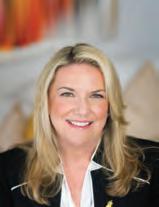
WHITNEY REID PENNELL
Whitney Reid Pennell, president of RCS Hospitality Group, is a celebrated management consultant, educator, and speaker. RCS has been recognized ten times with a BoardRoom Excellence in Achievement Awards. RCS offers innovative solutions through RCSUniversity.com, an online virtual training portal for employees and managers. For more information, phone (623) 322-0773; or visit the RCS website at www.consultingRCS.com.
2020 – Perhaps There Is A Key
Borrowing from Winston Churchill and replacing a few key words describes 2020: “I cannot forecast to you the effects of COVID19. It is a riddle, wrapped in a mystery, inside an enigma; but perhaps there is a key.”
Many remember the first part of the statement as Churchill talked about Russia’s actions, but few remember, “perhaps there is a key.”
When I think about 2020, the key to unwrapping the mysteries is another noteworthy saying, “necessity is the mother of invention.” We are living through a historic time with the pandemic. How are we going to respond and be remembered? How will it change us?
If one ponders these questions in their club, there are a few items of curiosity that will forever change the landscape of clubs and undoubtedly worthy of inclusion in an updated strategic plan.
THE PUZZLE
• Technology needs of the club will continue to change. Online ordering, use of apps, QR codes and embedded video are here to stay. Do you have the staff infrastructure and internet security and bandwidth to keep up?
• Altered work schedules and increased attention to family values have changed society. These can sway several aspects of the club: events, dress code, tech devices, workspace, internet security, private meeting rooms, and childcare or family activities during work hours. How do these changes impact the club’s office space needs, organizational chart, rates of pay, scheduling preferences and remote work expenses?
• As non-traditional school arrangements become more commonplace, how does that change member and employee needs at the club?
• The organizational model of the past may be outdated as we discover the need to reimagine club operations. Do you need:
• a digital communications expert?
• a highly proficient HR manager?
• an administrator for F&B to keep up with technology, events, communication, photos, and videos that are now expected?
THE MYSTERY
Budgets will change; spending will shift. We will spend more on technology, security, agronomy costs and supplies, while continuously upgrading technological equipment and evaluating sanitation and PPE needs. Tools to remain connected to each other (remotely) and the members for 24/7 connectivity are here to stay. Have we been on autopilot with budgets, events, activities, scheduling and traditions? The pandemic forced everyone to take a deeper dive into various revenue streams and expenses. Running the club more like a business has finally caught on mainstream. Yes, updates and new spaces are important, but they must make financial sense and offer a sustainable membership benefit.
The labor market that was constraining managers is now abundant with talent. Hospitality workers, in particular, are flooding the market. Clubs have transitioned and will continue to transform. Now is the time to evaluate roles and responsibilities, skills and abilities. Do not underestimate member familiarity, institutional knowledge and cultural alignment of existing employees. These are difficult to replace. Investment in staff and management development will become more important than ever. We cannot do what we’ve always done because we need different results as we move into 2021.
THE ENIGMA
No one knows how or what lasting changes we’ll see. But we can watch how society is responding. Golf rounds are strong and steady. Casual, outdoor dining has likely not even peaked yet. Many private clubs have seen an increase in membership during this time and because of increased expenses, dues have been raised, seemingly counterintuitive.
Clubs with real estate development or within home communities are enjoying a surge of interest. What will that mean for new member orientation programs? How will spending and usage change? Those changes will impact staffing and technology needs.
Food and beverage and events have been forever transformed. That is a topic for another article, but it will never go back to what it was. With safety in mind, many

EXECUTIVE COMMITTEE

Resiliency Matters
We’ve seen outstanding examples of resiliency in the private club industry in the wake of the COVID-19 Pandemic. This matters because the membership is looking to the club to provide an exceptional experience, even more so in difficult times.
Clubs that have provided services during the Pandemic did build considerable membership loyalty and secured on-going revenues. Besides financial benefits, these clubs did avoid large-scale layoffs or furloughs.
We believe that resiliency tactics applied during a pandemic translate well into resiliency against other disasters, such as fires, storms and grid failures.
So, here are some insights into what clubs did to provide exceptional membership experiences during administrative restrictions and closures, as well as advice on how to prepare your club for future calamities.
Scientifically speaking, key business resiliency factors are:
1. Inventories – continuing operations without deliveries/input.
2. Relocation – while this essentially means to relocate the business (not really an option for a golf club), private clubs applied this tactic to move barbecues/dining outdoors and outdoor events while the clubhouse was closed.
3. Conservation – a club that uses less energy, less water, fewer pesticides, less fertilizer and produces less trash is better suited to operate (both financially and in terms of reduced inventory) during or after a disaster. Yes, a sustainable club is better suited to operate during/after a disaster; sustainability and resiliency go hand-in-hand.
4. Resource isolation – securing the club’s continuous operation despite a missing resource (e.g., operating the club without grid electricity).
5. Input substitution – preparation for replacing a missing input (e.g., seafood) with another vendor not affected/outside the affected area or faster back in business.
6. Excess capacity – bringing stand-by equipment into service, such as a backup-generator or leveraging solar energy through a transfer switch.
Patty Ashbrook, general manager/COO of Forest Highlands Golf Club in Flagstaff, AZ, has found several ways to provide exceptional membership experiences during the current Pandemic, including:
• Drive-up homemade bagels, pastries, muffins and breakfast to go
• Barbeque in the Pines prepared and served outdoors or to go using their own smoker trailer
• Famous “Firehouse Tacos” prepared and served outside or to go
• Online children tutoring (during school closures and for homework assistance)
• Outdoor children recreation activities (paintball, community-wide scavenger hunts, sports camps)
• Video cooking classes and a dedicated YouTube Channel for Forest Highlands Golf Club members
• Online video and outdoor fitness and Yoga classes
• Golf course rain shelters used for pop-up outdoor dining with social distancing
• Online food & drink orders, and
• Full outdoor bar service with beer, wine and cocktails to go (drive-up and poolside)
One of the country’s most sustainable clubs, Broken Sound in Boca Raton, FL, has gone out of its way to secure the membership’s health during the Pandemic. General manager John Crean explains:
• Observing the rapid COVID-19 infection rate in Europe, we acquired essential hygienic items, such as hand disinfectant, face masks, Clorox wipes, toilet paper, rubber gloves and many more and opened a member convenience store for those in the clubhouse
• We installed high-energy UV lamps in public spaces and the kitchen; these do kill any bacteria and airborne viruses instantaneously
• We offered yoga, golf lessons, fitness lessons all online
• We offered over 1,500 Passover traditional meals to go (times drive-up service for members)
7. Management effectiveness – an important and often overseen factor in managing a crisis (or the aftermath). This approach includes flexible operation hours, flexible working hours, moving events, minimizing reporting requirements, etc. Financial preparedness (reserves) for a catastrophic event also falls in this category.
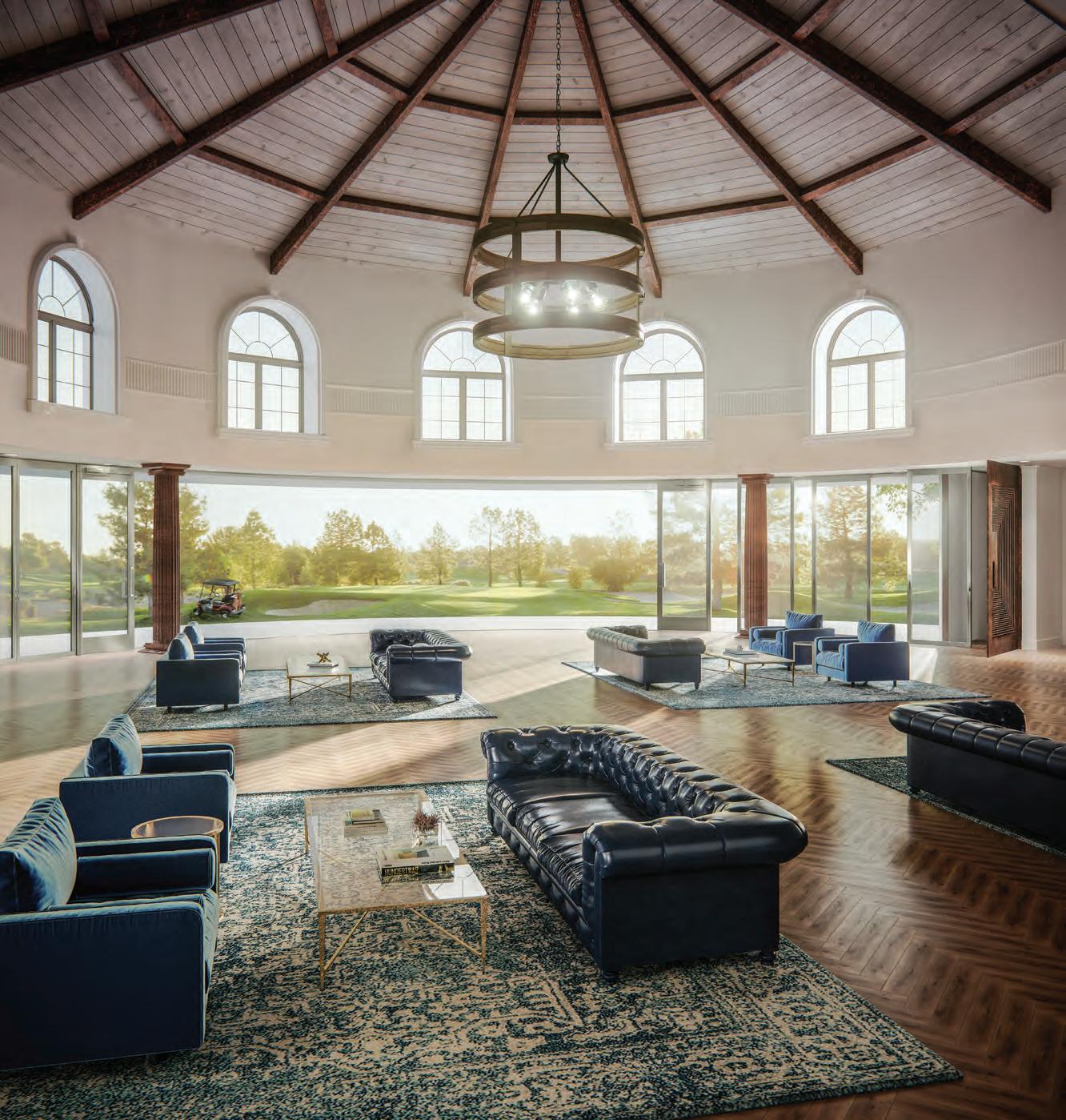


LARGE OPENING FRESH AIR VENTILATION


SWING DOORS SLIDE AWAY WITH PANELS



SLIDING GLASS WALLS THAT STACK REMOTELY
NanaWall® HSW systems’ single track sliding glass walls integrate within traditional architecture, working around existing structural columns and other remodeling challenges. Navigating segmented curves and angle changes, our walls can also incorporate commercially-rated swing doors that convert to sliding panels and hide away.
NanaWall® HSW systems’ single track sliding glass walls integrate within traditional architecture, working around existing structural columns and other remodeling challenges. Navigating segmented curves and angle changes, our walls can also incorporate commercially-rated swing doors that convert to sliding panels and hide away.
Learn more about our limit-surpassing innovations at nanawall.com/hsw.
Learn more about our limit-surpassing innovations at nanawall.com/hsw.

CULINARY & CATERING
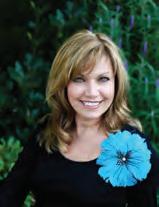
Lynne LaFond DeLuca, executive director of the Association of Club Catering Professionals (ACCP). You can also contact Lynne at Lynne@TheACCP.com
What Do Our Members Want That We Are Not Providing?
The world is in a state of constant change and with that comes a constant changing of our needs for life’s essentials, luxuries, and conveniences.
Our clubs have always provided a sense of community, family and a “home-away-from-home” for our members and now, we have the opportunity to be and deliver even more. Think about the amenities and the intangibles that your club has always provided. Now think about your own personal, everyday needs and “wish list” items that you and your family would find to be an incredible luxury, indulgence, or even just a convenience or “relief” to be able to attain daily. That. Right there…is the opportunity. How can we provide a service, remove a stressor, eliminate a pain for our members?
Can we replace an experience in some way that members are no longer able to experience, such as a sporting event, live concert, festival, or theater? Everyone is now craving things that we used to take for granted and our clubs have the unique opportunity to meet those needs, replace those cravings and allow our members to feel “whole” and socially satisfied.
For most clubs, the list of member benefits that we’ve always provided has probably not changed much over the years. Every now and then, we might add a new amenity, upgrade our existing facility, or add a new reciprocal club privilege, but our core “offerings” have stayed relatively the same.
One of the “silver linings” that this pandemic has brought to light is our ability to get even more creative and innovative than ever before with our offerings, benefits, and events. You have heard the phrase, “You can’t be all things to all people”, is true, but we can be more to our members. If you sit with your team, executive committee, board of governors and member committees and have everyone brainstorm on all the things they are “missing” right now, I’m sure you will hear things like concerts, live sporting events, retail shopping, getting together with friends, and travel/ vacations. This is a great list to start with!
Whatever your members are missing is where you have an opportunity to provide value and fun. Ideas that many clubs have already implemented include expanding their take-out menus; creating grocery store/pantries for members to shop for groceries; bottling to-go cocktails; creating drive-in and drive-through events; club staycation adventures; camping on the golf course, and of course, the incredible and vast array of virtual events.
In most clubs, we have a unique advantage: we have real estate – space that we can expand into and allow for physical distancing. This is GOLD right now! We can host a live concert where we can control the crowd and number of people while keeping everyone distanced.
We can recreate a favorite sports bar in one of our larger banquet spaces where members can watch a favorite local team play. Pop-up event opportunities are endless and not limited to food and beverage – think retail shopping as well!
Intimate, high-end dining experiences are a hot ticket right now in beautiful outdoor spaces. Determine how many you can safely accommodate and create a package that your members cannot resist, including beautiful furnishings, an exquisite menu, fabulous cocktails and wine, and maybe even a small gift to take home.
The ideas and the needs that you can satisfy are endless, and a lot of them will come straight from the mouths of your members – just ask what they are missing! BR
Lynne LaFond DeLuca is the executive director of the Association of Club Catering & Event Professionals and a private club industry consultant. In 2014, Lynne was named “One of the Most Influential Women in the Private Club Industry” by Boardroom Magazine and in 2016, was awarded BoardRoom’s Gary Player Educator of the Year Award. You can reach Lynne at Lynne@TheACCP.com, or visit the website at www. TheACCP.com. Follow the ACCP on Facebook at www.facebook.com/ AsociationofClubCateringProfessionals; on our LinkedIn Group and Instagram at www.instagram.com/clubcateringpro
LYNNE LAFOND DELUCA

FINANCE COMMITTEE

The Club Capital Paradox
What Will It Be?
The best way to prepare for the future is to start planning your capital needs now and develop a plan to fund them.
We’ve learned over the years that regardless of economic conditions, irrigation systems still need repairing, cart leases still need to be renewed, bunkers still need renovating and so forth. In short, the capital demands of a club go on and on, rain or shine.
The private club industry has a paradox at its very center: How can these collections of a town’s wealthiest residents struggle to gather the capital necessary to fund their club’s needs? After all, a country club is often worth less than some of the homes on the golf course. The club is a smaller business than nearly all its members own or manage in their day jobs. Surely 300 affluent locals can fund the upkeep, right?
Here is the reality: Most of us enjoy staying in nice hotels or dining at top restaurants, but we expect the owner to take care of the place. We want the experience, and we are willing to pay our bill - and even a healthy tip. But we don’t expect to share in the burdens of ownership, especially if it means large one-time or ongoing charges for building a new pool, replacing the elevators, or a gut renovation. Can someone else just handle all of that?
To be clear, the top 800 clubs in the U.S. have waitlists to join, and these clubs have no problem assessing their members $10,000 or even $25,000 each to fund major renovation projects designed by Chambers, or Marsh or Peacock & Lewis. Why? Simple supply and demand - if there is a line of people willing to pay $100,000 to take your coveted spot at the club, you don’t want to hesitate in paying your assessment.
PETER NANULA
Peter J. Nanula is chairman of Concert Golf Partners (www.concertgolfpartners.com), an owner, operator and all-cash buyer of private golf and country clubs. He can be reached at (949) 7150602 or via email: pnanula@concertcapital.com.
But most clubs, even in prestigious neighborhoods, are not filled to capacity like they were back in 2006 or long ago when private clubs occupied a different place in people’s lives. Most clubs we speak with are about 30-40 members short of where the board ideally would like to be - sometimes more. In this environment, proposing a member-funded renovation plan is a tricky endeavor.
At the Country Club of Roswell in Atlanta, GA, the board recently developed a $4.5 million “Vision 2025” master plan. Member surveys and focus groups came back enthusiastic. Then, the board proposed three options for paying the cost: A large one-time assessment combined with an increase in the club’s bank debt; a small monthly addition to every member’s bill over the next 10 years or a series of higher-thanusual dues increases.
Members balked, rejecting all three options by sizeable margins… which led them to vote overwhelmingly in favor of an experienced capital partner.
At a top club on Long Island, the board passed a series of large assessments in 2018 to fund a multi-million-dollar greens and bunker renovation project, by a roughly 75 percent vote. Good news, right? Yes and no.
The project was funded, and the greens turned out terrific, according to the club president. But several members resigned from the club. These “no” voters voted with their feet and the club suffered a nearly 10 percent decline in dues-paying members. New assessments and steep dues increases are now being levied to cover the shortfall of members.
The best advice from experts like McMahon Group and Club Benchmarking is to run your club with a surplus so that you have capital funds on hand to complete needed projects – and you won’t need an assessment that could scare off some of your members.
Also, target renovation plans that can garner a 90 percent or higher vote. That way, few members are likely to resign after being assessed. Follow these simple rules, and uncertain economic conditions won’t put your club’s long-term master plan off course. BR

“As a private club, our members and guests expect the same caliber of Five-Star service that Forbes Travel Guide offers. Forbes Travel Guide worked with our leadership team to create custom standards, tailored training, and quality assessments which have been implemented throughout the club. We value our partnership with Forbes Travel Guide and look forward to continuing to raise the bar at The Union League of Philadelphia.”
Jeffrey P. McFadden Chief Executive Officer/General Manager The Union League of Philadelphia






FOOD & BEVERAGE COMMITTEE
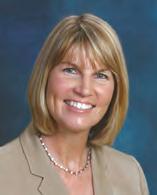
LISA CARROLL
Lisa Carroll, SHRM-SCP, is a search executive and consultant with Kopplin Kuebler & Wallace, a consulting firm providing executive search, strategic planning, and consulting services to the private club industry. She specializes in executive chef, GM/COO and CFO searches. Lisa can be contacted at (561) 596-1123 and at lisa@kkandw.com.
Introducing a New Culinary Arts Associate Degree Focused on Clubs
There’s a new and exciting culinary arts associate degree program of interest to private clubs.
First, let me share a little background information. Earlier this year we conducted the executive chef/culinary director search for Edgar’s Hospitality Group located in Augusta, Georgia. The not-for-profit Goodwill Industries of Middle Georgia and the CSRA (based in Augusta) operates Edgar’s Hospitality Group (EHG) and Helms College.
EHG and Helms College work together to provide culinary students with experiential learning through EHG’s multiple restaurants, a private club and two conference centers.
Helms College is a private, independent postsecondary licensed and accredited career school named after Dr. Edgar J. Helms. He founded the Goodwill movement in 1902 with a focus on: “What people really want is not charity, but a chance to work.”
Helms College has offered an associate degree in Applied Science in Culinary Arts since 2012, focusing on experiential learning – students work in labs and EHG kitchens as part of their curriculum.
Helms College’s Augusta campus, beginning in January 2021, is offering an associate degree program focused on culinary operations in resorts and clubs (CORC). Students enrolled in the new program will have club-specific courses as part of their curriculum and will acquire hands-on learning in EHG’s private city club, called The Pinnacle Club, located in downtown Augusta.
Club-specific courses include event planning and operations, member relations and engagement, action stations design, multi-unit operations, and American regional cuisine.
“This will be a rigorous program designed to train students from all over the world for a resort and club-focused culi -
nary career,” noted Dr. Gary Markowitz, senior vice president of education at Helms College.
Two important missions drive Helms College. “Providing guests an exceptional dining experience and offering the students of Helms College intense applied learning in world-class hospitality venues,” explained James Stiff, president of Goodwill Industries of Middle Georgia and Helms College.
EHG hospitality venues include locally acclaimed Edgar’s Grille, The Pinnacle Club (a private city club), meeting and event venues Snelling and Anderson Conference Centers and the recently opened downtown rooftop venue, Edgar’s Above Broad. A portion of every customer dollar spent in the venues goes towards education programs, including support for Helms College, job training and placement services for those in need.
In addition to the work opportunities in EHG venues, Helms College culinary students have the unique opportunity to work at the local major championship golf tournament in Augusta every spring.
In fact, during the 2019 championship tournament, 600 culinary students from across the country were assigned to one of the 27 on-site kitchens, each led by a tournament executive chef. Fifty-three Helms College students participated. The best student performer on each team received a white coat and seven Helms College students were awarded the white coat status for the 2019 tournament!
EHG also is creating and growing an agriculture program to support the needs of its farm-to-table culinary operations while providing experiential learning opportunities to Helms College students. The farm will include in-ground planting as well as greenhouse and vertical farming.
The school is partnering with The Ritz-Carlton Reynolds, Lake Oconee for externships and is also interested in partnering with clubs and other resorts. Students starting in the January 2021 cohort will be available for an externship in October 2022.
Chef Frank Kassner, the executive chef/culinary director candidate at Edgar’s Hospitality Group, came from Montage Palmetto Club and had over 17 years’ experience working for the Ritz-Carlton hotel brand. He’s an ambassador and mentor for Helms College students as they intern at each of the hospitality outlets as part of the college’s core curriculum.
For more information about this accredited associate degree or enrolling a student, visit www.HelmsGoldStandardCulinary.com or call 84.GO-HELMS. If you are interested in partnering with Helms College to set up an externship, contact Ellen Harper, director of executive affairs at eharper@helms.edu or call (706) 854-4771.
Support this great program and ensure a pipeline of culinary talent to your club! BR





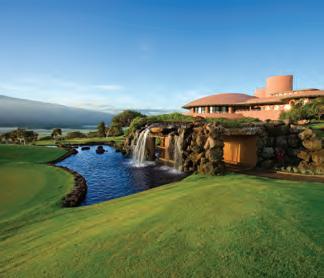
As a division of Troon ® , True Club Solutions (TCS) is the only advisory services firm that draws upon decades of experience, currently serving 440+ locations around the globe. As an alternative to Troon’s professional management solutions, TCS engagements benefit our clients by tapping into the depth and breadth of expertise from our thousands of corporate and field associates to focus on Club specific, shorter term challenges and opportunities.

LEGISLATIVE COMMITTEE
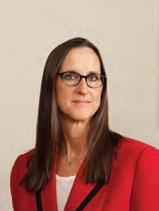
ROBYN STOWELL
Robyn Nordin Stowell is a partner in the law firm of Sherman & Howard L.L.C. in Scottsdale, Arizona. Robyn may be reached at (480) 624-2736 or by email at rstowell@shermanhoward.com.
Discipline in the COVID-19 Era
COVID-19 has changed many things in the club environment, but one thing that has not changed: Some members will not follow the rules.
Another thing that has not changed is the bottom-line requirement for member discipline. We are making and remaking new rules as the coronavirus situation evolves.
It seems that COVID-19 will be an ongoing and evolving process for at least a number of months, so it is important to remember to keep an eye on these issues. To be ready to apply member discipline appropriately, the following steps apply.
1) Review any applicable statutes. If you are a member-owned club or a homeowner association, in almost all cases, there are state statutes that discuss the requirements for the member discipline process. These statutes address the type of notice required, the number of days of notice required, the member’s right to a hearing, and possible limitations on the amounts of fines. Think of these as “boundaries” within which you must operate.
2) Review your bylaws to ensure that they don’t violate applicable statutes and be sure the process is up to date and sufficient for the club under today’s current circumstances. For example, you may need the ability to communicate electronically or conduct hearings electronically. Your board might not be meeting in person, or some of the attendees might be vulnerable and not able to appear in person.
3) Review your governor’s executive orders and any corresponding local health department requirements to understand the specific limitation on

your club’s operations. These change regularly and it is important to be up to date and understanding exactly what is required of you.
4) Consider your club’s facilities and services so that you can identify the specific types of rules and restrictions you need in the current COVID environment. Consider how the government restrictions limiting people or activities impact the rules needed for these facilities. For example, have you added to-go food or food delivery services such that you need additional rules and guidelines? Also, consider your members and the types of guidelines they need. (By the way, if you are adding services during COVID-19, you should also review your insurance coverage.)
5) Make appropriate rules for your facilities and services, keeping in mind the information you developed from reviewing the statutes, bylaws and governmental orders. Communicate those rules to the membership. Consider how to keep your members advised or rule changes because you may need to communicate changes multiple times before all restrictions are lifted.
With our current COVID-19 circumstances, if you follow these foregoing processes, the unfortunate next required step is to “lather, rinse, and repeat.” A reasonable expectation is that we will continue to get new COVID-19 guidelines and restrictions on what can and cannot be opened, what people should or shouldn’t do regarding social distancing or wearing masks, etc. We need to continue to circle back to the step of considering the governmental requirements, your facilities and services, and your members’ needs and club use so that we can make appropriate rules and implement them. BR
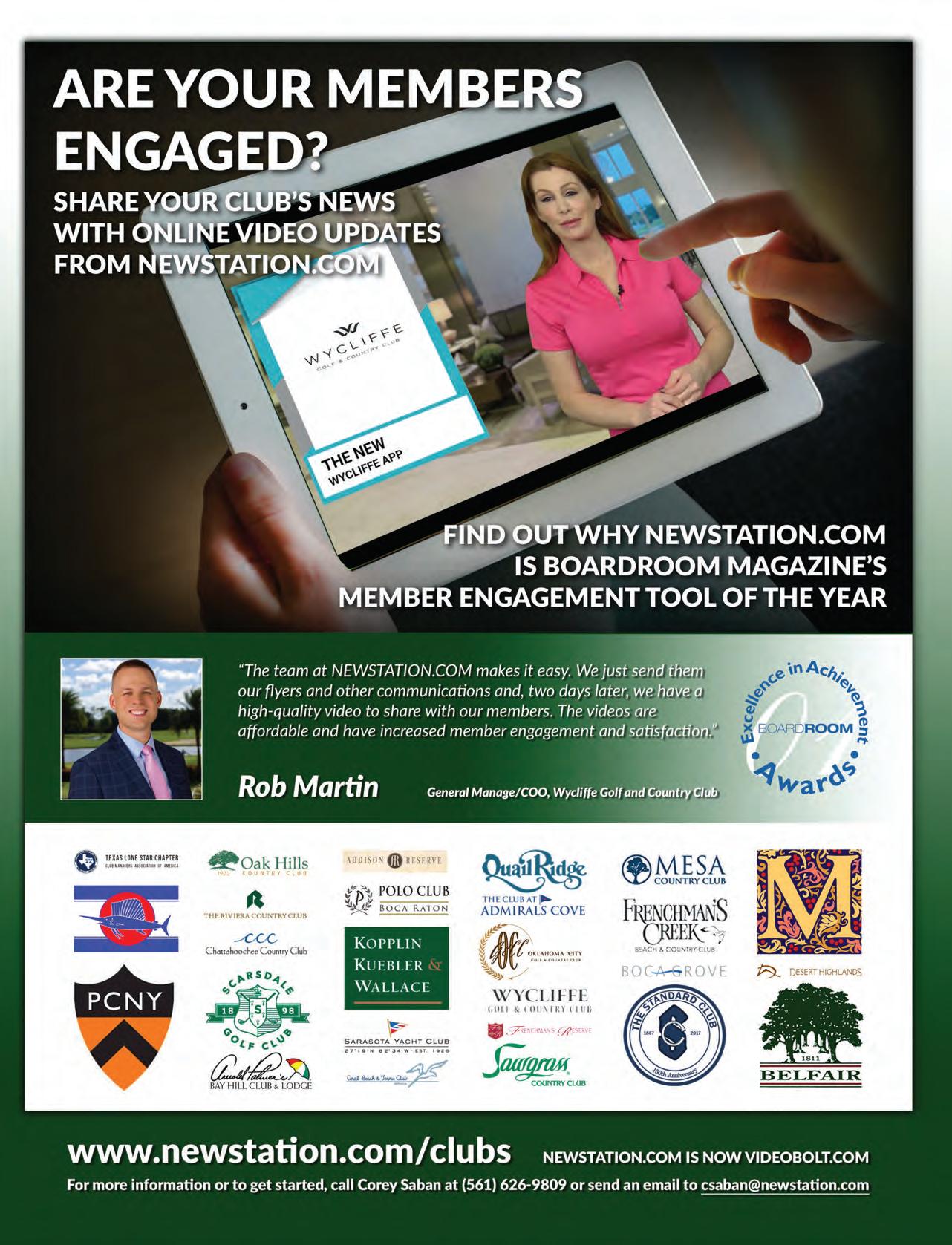
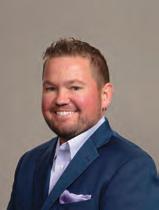
Billy Knight is ClubCorp’s vice president of corporate development. He can be reached at billy.knight@clubcorp.com or 678-859-5497.
Keeping Members Connected Approaching 2021 with a cautiously optimistic outlook
For what feels like the first time in many years, our industry had some tailwinds behind it in 2020.
Despite the COVID-19 pandemic, many private clubs have enjoyed a relatively successful run, as a rapid, nearly overnight shift in how our society spends its time and discretionary dollar drove significant traffic toward club activities, and particularly golf. Widespread adaptation of work-from-home policies afforded individuals more flexibility with respect to how their workdays were structured. Restrictions on indoor gatherings drove people toward outdoor activities where social distance could easily be maintained. Reluctance to travel, particularly via airplane, kept families local and pursuing leisure activities close to home. Lastly, many private clubs were able to effectively position themselves as a safe haven during the COVID-19 crisis – capitalizing on a general perception that private clubs were safer than other dining/recreation outlets.
This all coalesced into a perfect storm for golf. Recent NGF studies suggest that the increase in rounds played may end up being as much as 15 percent over 2019, approaching levels that haven’t been seen since the mid2000s. In many private clubs, this has also driven a surge in golf membership enrollments, driving dues lines and helping to offset some of the losses incurred via the decline in private events and other revenue areas.
What does this mean for our industry in 2021 and beyond?
That’s a question private club owners and board presidents will soon be forced to address, particularly as we approach the cold weather months in many areas of the country. In some respects, the timing of the first wave of COVID-19 outbreaks worked in the golf
industry’s favor. Just as the initial wave of shutdowns hit in March and April, golf season ramped up in many markets. This was undoubtedly a key factor that helped drive the surge in golf activity at private clubs over the past eight months. Frankly speaking, most areas of the country will not have that luxury moving into the winter months.
With the winter months approaching and fears of a second wave of COVID-19 infections mounting, now is the time for private clubs to develop a proactive strategy to keep members active and engaged, without having golf as part of the activity mix.
Now more than ever, providing a robust digital member engagement platform – including concepts like virtual member events executed across social media platforms, online golf and tennis instruction, mobile-friendly to-go/carryout ordering channels and more – is critical to keeping members connected and ultimately retained through the next few months.
As we develop business plans and annual operating budgets for our ClubLife Management clients, we’re approaching 2021 with a cautiously optimistic outlook as it relates to the impact of the virus on our businesses next year. Our plans evaluate a variety of modified operating environments for next season, including worst-case scenarios where indoor activities and banquets/private events are still limited, golf demand slows and the need for virtual programming is amplified. This approach is designed to provide our clients with maximum flexibility to adapt to a rapidly-changing operating climate.
We’re also highly focused on capitalizing on the surge in demand for golf in 2020, rolling out innovative new programs and strategies designed to engage and retain a wave of new golfers that were introduced (or re-introduced) to the game during the pandemic. We view this as a unique opportunity to create a new generation of private club members – one that all private clubs need to be prepared to execute on.
For more information on how we’re working side by side with our allied clubs to prepare for a successful 2021 season, visit clublifemanagement.com/covid-19. BR

The Best Way to Address Your Operational Challenges and Save Money
This year brought challenges unlike we’ve seen before. Budget troubles plagued the entire hospitality industry, including the private club sector.
The uncertainty of when we’ll “return to normal” means that cost-saving measures will be in place for the foreseeable future, so finding and retaining the best people to manage key operational areas is still priority number one.
Factoring in the cost to advertise, interview, screen, and hire for open positions, an unfilled position will negatively affect not only your operations but your bottom line.
Working with a recruiter is key to finding the best candidate to fill any open position. Robert Krzak from Gecko Hospitality addresses some frequently asked questions when selecting a professional recruiting firm.
Why should my club work with a recruiter?
Robert Krzak: Most club hiring managers are overwhelmed by the sheer number of resumes they get, especially now with the vast number of people looking for new opportunities. A reputable recruiter will dip into their established candidate database, screen qualifications, and

ROBERT KRZAK
present only the best candidates to your hiring manager. That leaves the hiring manager to do what they do best: act quickly to fill open positions and ensure a smooth and seamless onboarding process.
One additional benefit to working with a recruiter like Gecko Hospitality is our ability to look beyond the club industry to find the best candidates. Based on our 20-plus years of placing candidates, we know the best person for the position can come from various industries. Our network includes thousands of high-end clubs, hotel, and resort candidates, allowing us to expand the search for the most qualified people.
How can clubs hiring managers know they can trust a recruiter?
RK: When selecting a recruiter, trust is paramount to a lasting relationship. Reputable recruiters have a code of ethics they live by and deliver on in every interaction with club management. Part of that trust is knowing that your recruiting partner is always looking out for your best interest.
I’m proud to say that our code of ethics is posted on our website for anyone to read. These principles bind everyone who works at Gecko. We recognize that every professional you hire through Gecko is an investment for your club, so we go above and beyond to bring these principles to every interaction with both clients and candidates.
Does my club need an exclusive agreement with a recruiter?
RK: No. Some club recruitment firms charge up to double the industry average on searches by locking you into exclusive agreements. We look at our partnership with clients differently. Our number one goal is to make sure you’re happy and we have implemented a one-year guarantee* for our private club clients. Plus, we only charge when we find the candidate.
Employee turnover is hurting many clubs. What can be done to address that?
RK: Search “how to reduce employee turnover,” and one of the first things on many lists is “hire the right people.” Easier said than done, especially in a market when there are hundreds of applicants for every position.
Working with a recruiter specializing in the private club industry is the best way to ensure you’re interviewing only the most qualified candidates. For instance, Gecko’s private club recruiters come from positions within the club industry, so they know the level of service members expect. They wouldn’t present a candidate who they felt couldn’t deliver on that.
Along with fair and equitable HR policies, filling open positions with the most qualified person is the best way to reduce turnover. Time and again, we see that good employees working for great employers is the winning combination. BR
Robert Krzak is the president of Gecko Hospitality, located in Ft. Myers, FL, and serving clients nationwide. For more information, please call (239) 690-7006 ext. 100, visit the website at www.geckohospitality.com, or email him at robert@geckohospitality.com.



Club
Our difference is your advantage.
Network:
Our network includes thousands of high-end club, hotel, and resort candidates. There’s a wealth of qualified talent outside the private club industry—and we bring them to you.
Fees:
Our fees are competitive across all industries we serve; no more paying double industry average fees to source qualified candidates. Plus, you only pay a fee when we find the candidate.

Focus:
Based on our 20+ years of placing candidates, we know how to screen resumes so your hiring manager can focus only on qualified candidates who fit your culture and your requirements.
Golf is Often a Solo Game… But the Complex World of Insurance Takes a Team Approach
S&K Insurance was founded in California in 1964 by Yosh Shibayama, and is now a member of ISU International, writing more than $1 billion in premiums.
Yet throughout its growth, S&K Insurance maintains the idea that it’s important to get to know a customer before recommending a product, because every client’s business needs are based on their unique situations and goals.
S&K Insurance specializes in helping private clubs mitigate their risk, keep premiums low, and assuring their HR department is up to speed on the ever-changing rules and regulations that could put them in harm’s way. As one club GM pointed out, “S&K Insurance manages our employee benefits, provides expertise in safety and risk management, offers valuable training and access to helpful tools and education.” While another simply states, “S&K Insurance helps my team be
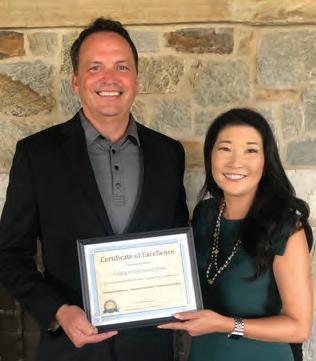
compliant while also focusing on the bottom-line so we can avoid audits, lawsuits, accidents and injuries.”
Toni Shibayama is a managing partner and chief risk officer, and has been with the company for over 20 years. Her dedication to excellence has helped customers develop strategic programs that meet the complex and ever-changing environment of their industries.
Brad Sporer is a managing partner and chief revenue officer, and has been part of the team for 20 years. He is continually developing business strategies to offer the best products and solutions for their customers.
S&K Insurance has what your private club needs, including property insurance to protect the building and the contents in a fire or other covered incidents. It can also protect against losses from business interruptions, while general liability is essential to pay for the costs of medical care for guests and members who have been injured on the premises.
Just like any business or organization, you need workers’ compensation insurance if you employ workers. You may also want to insure against cyber liability if you keep information on a server. Depending on the amenities your club offers, you may want to consider liquor liability, coverage for food consumption, employee theft, and allegations of discrimination if you deny membership for other reasons.
S&K Insurance provides a comprehensive package of insurance coverage for private clubs. They work with you to determine your needs and ensure you get the best protection for your budget. You want to protect your members, your board, your employees and your property from unforeseen circumstances and ensure the longevity of the club with the right insurance coverage.
S&K Insurance’s goal is to help businesses mitigate risk and to increase employee productivity so your club can thrive in today’s economy. At S&K Insurance, they do more than just sell insurance; they partner with clubs to help them develop strategies which will ensure long-term success. BR
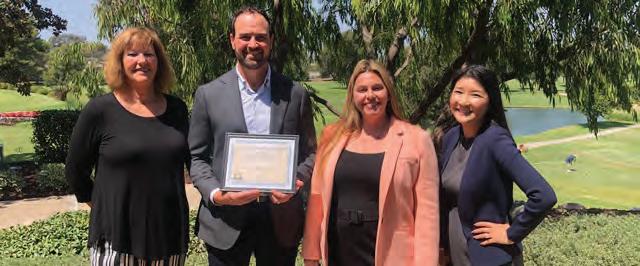
Greg Sullivan, GM of Rolling Hills Country Club, receives a Certificate of Excellence from Toni Shibayama of S&K Insurance for the Club’s ongoing efforts in reducing their experience mod, lowering their premiums, and displaying an overall reduction in workplace injuries.
Toni Shibayama of S&K Insurance (far right) presents a Certificate of Excellence to Mesa Verde Country Club for their commitment to lowering their experience mod, reducing their premiums and establishing a good safety record. Pictured from Mesa Verde CC are (L-R) Patricia Smith, controller; Jeremy Samson, GM; and Michele Green, HR manager.


BoardRoom magazine Recognizes the Private Club Presidents of the Year
By Meghan Thibault
Now in its 12th year, BoardRoom magazine annually recognizes the world’s top private club presidents, captains and chairs as Private Club Presidents of the Year, for their outstanding work, their understanding of the industry, and role and responsibilities of the club’s board of directors. In this continuing series, BoardRoom introduces five of the top 24 presidents for 2019. The Distinguished Club President was featured in the January/February issue.
Private club board presidents play a huge role in professional operations of their clubs as a volunteer working diligently with their board of directors and general managers, striving for well informed, but not emotional decisions.
This recognition by BoardRoom magazine has attracted board president nominations from clubs and other nominators around the world.
These outstanding presidents exemplify the focus on the leadership responsibilities, the accountability and the management of the board providing a healthy respect for the club’s macro management. They are cognizant of the importance of working, effectively and efficiently, with their volunteer boards and the dedication required from everyone with whom they work.
Key elements of a “good” board include commitment, competence, diversity, collective decision making, openness, transparency, effective communication with the management and the membership, fiscal responsibility, development and establishment of the clubs’ mission, vision and policy direction, especially through establishment of a strategic plan.
A successful board president draws upon the expertise of other board members, the club’s institutional memory and stewardship of the club’s resources. As well the board president provides new board members and future board presidents with information they need to perform effectively as board members.
Congratulations to these outstanding private club board presidents. See pages 58 & 59.
To view all the Distinguished Club Presidents from the past 12 years, please visit: www.boardroommagazine.com/presidents.html
Does it make a difference if you are a manager at a Distinguished Club?
Of course, it does! Both general managers and department heads of clubs who have earned Distinguished Club status are widely recognized by Kopplin Kuebler & Wallace and boards as leaders at providing a great Member Experience. It makes you a very strong candidate for leading clubs searching for top club management.
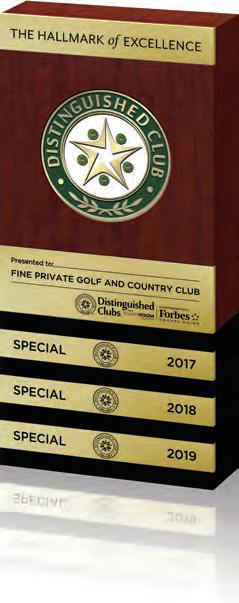
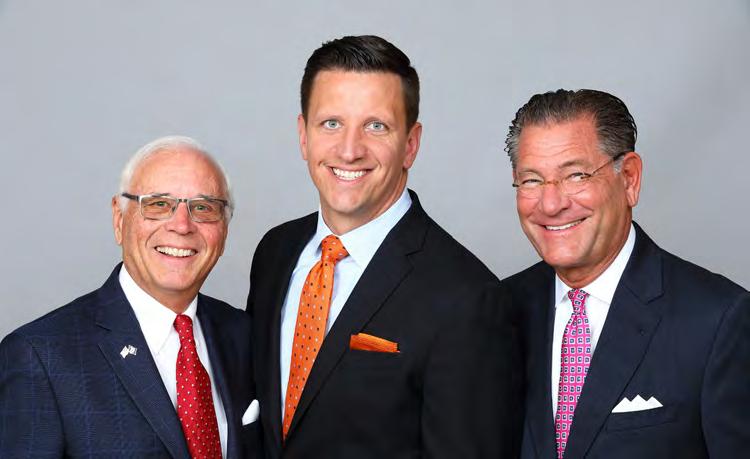
Executive Search Firm Leaders for the Private Club Industry
The only merit-based award program that recognizes private clubs and their management for outstanding delivery of exceptional Member Experience. www.distinguishedclubs.com
Kopplin Kuebler & Wallace Partners pictured left-right: Dick Kopplin, Tom Wallace and Kurt Kuebler
JIM STEINMEYER | PRESIDENT, ACADEMY OF MAGICAL ARTS | HOLLYWOOD, CALIFORNIA

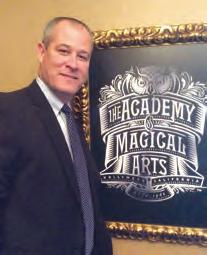
Jim Steinmeyer joined the board of directors of the Academy of Magical Arts in 2013, and has served as the secretary, vice president and finally, as president. Under his leadership, the Academy has welcomed more new members than during any other tenure, and the Academy (and magic) has seen unprecedented growth.
His communications to both members and employees have proven to be very effective, with transparency always the goal.
During Steinmeyer’s tenure on the board, the Academy has implemented a long-range plan to eventually purchase the property after 2029. In addition, the Academy has redesigned and
refurbished two grand theaters, which are enjoyed weekly by thousands of members and guests.
Lastly, Steinmeyer took on the responsibility of redesigning the Harry Houdini Séance experience, one of the long-standing “dinner experiences” inside the Academy’s Castle.
Steinmeyer has supported the general manager Joe Furlow, the senior management team of 15 department heads and the Academy’s more than 200 employees. He has spoken to the staff on numerous occasions, issued words of encouragement during difficult periods, and supported “out of the box” decisions that eventually increased the member/employee satisfaction at the club.
In 2020, Jim’s tenure on the board will come to an end because of term limits, but his daily communications with Furlow and staff, as well as his positive attitude to make the Academy the best it can be, will be sorely missed.
Steinmeyer is an inventor and designer of some of the most famous illusions in magic history. He was only 24 years old when he consulted with David Copperfield and created the illusion that made Copperfield famous – the disappearance of the Statue of Liberty. He has designed illusions for Doug Henning, Siegfried & Roy, Lance Burton, Orson Wells, Harry Blackstone, Pendragons and Alex Ramon.
Jim’s illusions have been featured in many Broadway shows, earning him two Drama Desk nominations. He created the Flying Carpet effect for Disney’s 2013 Aladdin and the Beast levitation/transformation scene in Beauty and the Beast. Steinmeyer created special effects for Phantom of the Opera, Mary Poppins, Into the Woods, Pippin, Merlin and many others.
Jim Steinmeyer is also a historian and writer who has authored several books about the history and technology of stage magic and has contributed to MAGIC and Genii Magazines. BR
RICHARD E. STRAUGHN | PRESIDENT, MOUNTAIN LAKE COUNTRY CLUB | LAKE WALES, FLORIDA
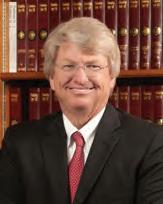
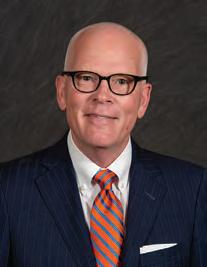
During Richard Straughn’s term at Mountain Lake Country Club, he successfully re-energized a renovation plan that has been underway at the club’s Colony House for the past 10 years. By insisting on transparency and a “no personal agenda” environment, a plan was developed, vetted by the board and delivered on time and under budget.
“In a small and exclusive environment like Mountain Lake, the president must check his ego at the door, empower the leadership tea, and make de-

cisions that are of the best interest of the whole membership,” said Straughn. This approach has led to a culture of positivity, according to the club’s GM Eric Dietz.
“Mr. Straughn’s leadership style is that of empowerment. He subscribes to the belief that in his role, he is charged with identifying the right people, securing their commitment, giving them clarity of direction and his enthusiastic support to let them do their jobs,” said Dietz.
One of the most successful initiatives under Straughn’s leadership has been to raise the quality of the Mountain Lake experience, something that is hugely important for the short and long-term. The club has enhanced the quality of each area of its operations and made a series of significant capital investments that both improve the club’s aesthetic and give staff the tools necessary to deliver a higher quality member experience. The result has been increased participation, higher topline revenues and greater overall member and guest satisfaction.
Through Straughn’s efforts, a long-range planning committee was established and a long-range plan is in active development. The club’s board meets five times per year to set policy and focus on strategy and vision, leaving operations to Dietz and his team.
“I have been in this business for over 30 years and have never worked with a leader that is not only my president but a mentor, an adviser and a friend. He is encouraging, helps me stay within the ‘navigational beacons’ and has been instrumental in the many short-term successes that we have enjoyed,” said Dietz.
A native of Winter Haven Florida, Straughn practices law. He graduated from the University of Florida Levin College of Law. Straughn and his wife Tammi make their home at Mountain Lake and are parents to children Marie and James. BR
JIM STEINMEYER, PRESIDENT JOE FURLOW, GM
RICHARD E. STRAUGHN, PRESIDENT ERIC DIETZ, GM
STEVEN SUNSHINE | PRESIDENT, SHADY CANYON GOLF CLUB | IRVINE, CALIFORNIA
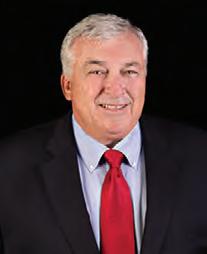
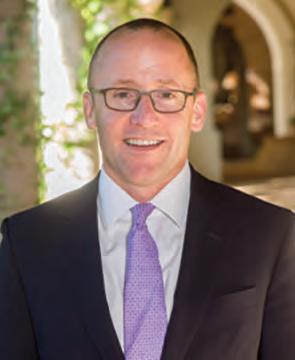
As president of Shady Canyon Golf Club, Steve Sunshine displayed tremendous leadership, initiative and the ability to lead from behind. He has an innate sense of club dynamics and possesses the ability to build on group consensus.
During his tenure, Sunshine hired and mentored a new general manager and new executive chef at Shady Canyon. He also garnered support for a new capital dues program to fund Shady Canyon’s annual repair and maintenance costs, saying, “Great clubs protect their future.” The

funding program will go a long way toward protecting and preserving the club’s infrastructure.
Sunshine also initiated a new tradition of partnering with nearby Big Canyon Golf Club, inviting both the board and general managers of each club to network at a shared dinner to discuss best practices.
“He embraced every challenge at the club as an opportunity to make the club the best that it can be for both members and staff,” said Lloyd Gillespie, the club’s general manager and COO. “I’ve been lucky in bearing witness to several talented volunteer leaders in our business, none more outstanding than Steve. He is a rainmaker that takes care of others.”
Shady Canyon Golf Club in southern California’s Irvine, is a board-led organization that relies on its talented management team to run operations. “Sunshine has been instrumental to my success and is always available to talk and mentor me through Shady Canyon’s membership dynamics and processes,” Gillespie added.
A partner at the international law firm of Bryan, Cave, Leighton, Paisner, Sunshine is a transactional lawyer with a focus on real estate development and the legal needs of ultra-high-net-worth families. For 12 years, Sunshine, a member of his firm’s management committee, is tasked with managing the day-to-day operations of the firm’s 26 offices around the world.
Sunshine holds a bachelor’s degree and a JD from UCLA. He and his wife Christine Sunshine have three children: Vanessa, Douglas and Jackie, and a granddaughter, Christina. BR


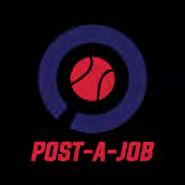
STEVEN SUNSHINE, PRESIDENT LLOYD GILLESPIE, GM/COO

Orient and Develop your Board of Directors
Replace emotions with facts!
BoardRoom Institute gives your club board access to top experts in the private club industry.
Hundreds of years of combined experience and hundreds of thousands of dollars worth of information in over 45 educational videos.
BOARD AND CLUB BENEFITS
• 24/7 access
• Affordable
• Prevent club lawsuits
• Accountability

GM BENEFITS
• Reduce micromanagement
• Collaborative governance
• Creates a shared playbook
Until now, almost all board member education rested squarely on the shoulders of the GM/COO. This was, and continues to be, a tremendous responsibility. The good news is that this is no longer the case and help is available - The Association of Private Club Directors is here to help you.
Robert Sereci, GM/COO Medinah Country Club, Medinah IL

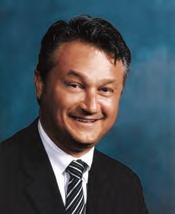

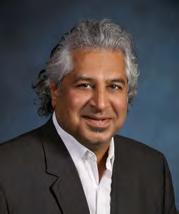
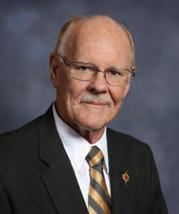
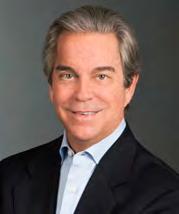
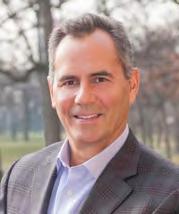
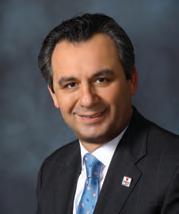

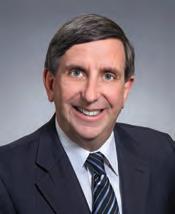
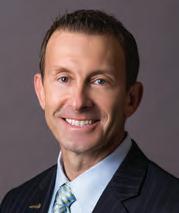
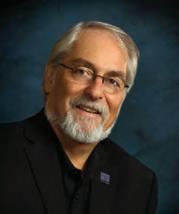


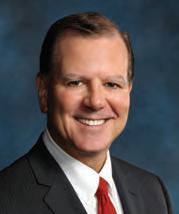

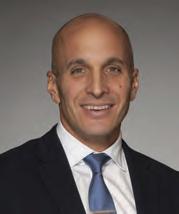

John G. Fornaro BoardRoom magazine
Kevin Reilly PBMares
Jim Fedigan Jonas Club Software
Philip G. Newman Partner - RSM US
Randy Addison Addison Law
Gordon Welch APCD
Rhett Evans GCSAA
Jim Butler Club Benchmarking
Michael Scimo President, Medinah CC
Tarun Kapoor Kapoor & Kapoor
Rick Coyne ClubMark
Phil Harvey Venture Insurance Programs
Robert Sereci GM/COO, Medinah CC
Jerry McCoy Clubwise Consulting
Pete Bevacqua President, NBC Sports Group
John Embree USPTA
Gregg Patterson Tribal Magic
BoardRoom magazine Excellence in Achievement Awards
The BoardRoom magazine “Excellence in Achievement” Awards is the only private club industry award that recognizes the clubs’ business partners. BoardRoom magazine’s industry peers review and select these outstanding suppliers and consultants, which represent various aspects of course and club operations.
Winners, each year, are selected for overall excellence in their respective fields, achievements, innovation, vision for future growth and continued impact on private club operations.
“The BoardRoom Awards are the only awards in the private club industry that recognize private clubs’ business partners, and every year we see increasing innovation, achievement, a vision and dedication from BoardRoom Award recipients. And of course, private clubs are the beneficiary of outstanding work of the industry’s vendors,” said John Fornaro, publisher of the BoardRoom magazine
The BoardRoom magazine is the only publication of its kind that is designed to educate the board of directors, owners, general managers and department heads of private golf, city, yacht, tennis and country clubs about issues concerning all aspects of the club, golf course management and operations.
HONORARY LIFETIME ACHIEVEMENT
Dave White
LIFETIME ACHIEVEMENT*
A. Judson Brown III – NCIDQ; ASID Rick Snellinger
GARY PLAYER EDUCATOR
Thomas B. Wallace III, CCM, CCE, ECM
DAVE WHITE EDITORIAL AWARD
Bonnie J. Knutson, Ph.D.
JOHN FORNARO INDUSTRY IMPACT AWARD
Tim Schantz - Troon
NEW PRODUCT Proform Premium Matting & Commercial Carpets
AMENITIES PROVIDER Sports Solutions
ASSOCIATION PGA of America

ASSOCIATION PROGRAM Association of Club Catering Professionals
BUSINESS INTELLIGENCE SOFTWARE Jonas Club Software
CHAIR MANUFACTURER Eustis Chair
CHILDRENS’ PROGRAM KE Camps
CLUB FITNESS PROGRAMS 1000 Hills Fitness
CLUB MANAGEMENT SOFTWARE NorthStar Club Management Software
CLUB PHOTOGRAPHY EA Photography
CLUB SIGNAGE Signera
CLUBHOUSE ARCHITECTURAL DESIGN Peacock + Lewis Architects and Planners
CLUBHOUSE RESTORATION MASTER PLAN C2 Limited Design Associates
CLUBHOUSE RESTORATION Ansana Interior Design
CONSULTING COMPANY Club Benchmarking
CUSTOM DESIGN HOSPITALITY UNIFORM High-End Uniforms
CUSTOM DESIGN OUTDOOR FURNITURE XHIBTZ Contract Furnishings
CUSTOM LIGHTING DESIGN Castor Design Associates, Inc.
DATA PRIVACY SOLUTIONS CSR Privacy Solutions
ELECTION MANAGEMENT SYSTEM Survey & Ballot Systems
EXECUTIVE SEARCH FIRM Kopplin Kuebler & Wallace
FACILITY ENHANCEMENT ANALYSIS
Clubwise Consulting
FITNESS EQUIPMENT Technogym
FOOD & BEVERAGE TECHNOLOGY PRODUCT FOOD-TRAK/System Concepts, Inc.
FURNITURE MANUFACTURER Gasser Chair Company
GOLF COURSE MAINTENANCE FIRM BrightView
GREEN PRODUCT Vivid Leaf
INNOVATIVE ARCHITECTURAL PRODUCT NanaWall
INNOVATIVE OUTDOOR PRODUCT Dayva International
INTERIOR DESIGN - BAR AND LOUNGE * Bozeman Club & Corporate Interiors PHX Architecture
INTERIOR DESIGN - CASUAL DINING C2 Limited Design Associates
INTERIOR DESIGN - CLUBHOUSE Marsh & Associates | MAI
INTERIOR DESIGN - DINING Angela Grande Design
INTERIOR DESIGN – LOCKER ROOM Marsh & Associates | MAI
INTERIOR DESIGN – PRO SHOP Marsh & Associates | MAI

IT SOLUTIONS
Country Club Technology Partner
LAW FIRM Addison Law
LAWYER Michelle Tanzer
LOCKER COMPANY Hollman, Inc.
MANAGEMENT COMPANY Troon
MASTER PLANNING Lichten Architects
INTEGRATED BUSINESS SOLUTIONS Strategic Club Solutions
MEMBERSHIP ENGAGEMENT TOOL Newstation.com
MEMBERSHIP MARKETING Creative Golf Marketing
MEMBERSHIP SURVEY McMahon Group
MOBIL APP Northstar Club Management Software
OUTDOOR FURNITURE COMPANY JANUS et Cie
OPERATIONS & MANAGEMENT ASSESSMENT * Denehy Club Thinking Partners Golf Business Network
PAYROLL PROGRAM ClubPay
POINT OF SALE COMPANY Northstar Club Management Software
POOL COMPLEX DESIGN PHX Architecture
PRIVATE CLUB BRANDING FIRM Pipeline Marketing
POOL RESTORATION & BUILDING RenoSys
PURCHASING COMPANY XHIBTZ Contract Furnishings
REAL ESTATE SERVICE Hilda W. Allen Real Estate
STAFF APPAREL Ambassador Uniform
STAFF TRAINING COMPANY RCS Hospitality Group
STRATEGIC PLANNING Club Benchmarking
SUSTAINABILITY PROGRAM SES Lighting
TAX CONSULTANT Mitchell Stump, CPA
TAX, AUDIT & ACCOUNTING PBMares
TENNIS COURT BUILDER Welch Tennis
TENNIS MANAGEMENT Cliff Drystall Tennis
WEBSITE COMPANY MembersFirst
FOOD FOR THOUGHT
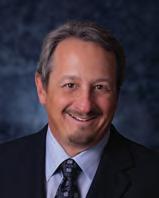
BILL SCHWARTZ
Bill Schwartz is the founder and CEO of System Concepts, Inc. (SCI). Based in Scottsdale, Arizona, SCI specializes in F&B procurement and inventory management. Bill can be reached at (480) 951-8011 or bills@foodtrak.com.
When F&B Costs Aren’t “Ideal”
The goal of all foodservice operations is to use only as much food or beverage as is required. This means no waste, no spoilage, no portioning issues, no theft, and perfectly executed recipes.
It’s typically expressed as a number or percentage and is alternatively called the “perfect food cost” or the “theoretical food cost” or sometimes the “ideal food cost.”
Unfortunately, that number is impossible to calculate accurately. Believe me, I’ve tried. For the last 40 years, I’ve been designing and implementing software to do just that. But the task is practically impossible.
Even in the simplest of quick service operations, some variables cannot be accurately calculated without a ridiculous amount of labor. For example, to calculate the perfect food cost, we need to know exactly what was legitimately sold or distributed, including every possible component.
Did that take-out order get a large bag or a medium bag? Which condiment packages did they get and how many? How many napkins? Did they ask for any modifications?
This example of variables represents some of the challenges facing quick service operations. Imagine the variables involved in a large club. Perfect food cost calculation is not a realistic option. And if we can’t calculate it accurately, we can’t determine how close we are to running it.
Clubs typically rely on budgets to set food and beverage cost goals, as do most organizations with food service departments. Unfortunately, while running close to the budgeted number may be fine from a fiscal perspective, it could be very far from perfect.
Budgets are typically based on historic data, so it stands to reason they would be set higher than perfect since there was no way to know this excess was always there. Our studies have shown that the budgeted number is at least five to 10 percent higher than the illusive perfect food cost.
Our studies did not attempt to calculate the perfect food cost because it would not be possible to do so accurately.
But we know (assuming no under usage) the “perfect” food cost will always be lower than we can get it.
Instead, we simply looked at what they were running before implementing our system and process changes and after. Without changes to the menus or vendor pricing, clients were able to reduce their food costs by between five to 10 percent based on the club’s volume and the extent to which they used the system and implemented best practices.
Keep in mind that saving this extra five to 10 percent of foodservice revenue goes straight to the bottom line and represents roughly the same profit impact as doubling F&B sales!
So how did they achieve this reduction without changing the menu or getting better pricing? They attack the problem from a variety of specific directions.
They start by implementing basic control practices like strong receiving protocols, accurate inventory taking and a professional approach to procurement that includes bids and purchase orders. They use mobile scanners and an automated procurement process that starts with outlet requisitions.
Requisitions are converted to transfers or shopping lists that are then converted to purchase orders, which are used to receive the goods and then are converted to invoices. Invoice transactions are transferred to the accounts payable system and charged to the proper accounts automatically.
This approach alone is good for more than 75 percent of the variance reduction and reduces labor at the same time since the source document is the requisition and that’s completed by the outlet manager. All the rest flows automatically from there.
Once the disciplines and automated processes are in place for determining the actual cost of goods, they can focus on the ideal cost of goods. This is done by looking at individual item variances.
While it may be difficult or impossible to calculate variances for the entire operation, it is much easier to calculate




DAVID W. LACEY
David Lacey is a two-tenure member of the board of governors at the Philadelphia Cricket Club. You can reach David at his email address: dlacey@bmtc.com
A Strategic Priority at Your Club Diversity, Equity and Inclusion
Diversity, equity and inclusion can become your next strategic priority.
Forbes magazine recently published its survey of organizations with effective DE&I programs and practices, which reported:
• 87 percent make better business decisions.
• 60 percent achieve better results versus their peers without DE&I programs and practices.
• Decisions about the enterprise are made twice as fast.
Based on these favorable outcomes, you’d expect that DE&I to move ahead as a priority, but it hasn’t. Accenture, the global consulting firm in its 2019-2020 survey, reported these results for the leaders of organizations:
• 76 percent - Financial performance is the number one priority.
• 72 percent - Branding/ a reputation for quality products/services in its markets, as number two priority.
• 54 percent - Retain and develop talent as the number three priority.
• 34 percent - DE&I is a distant number four priority.
When 34 percent of organizational leaders in all economic sectors report DE&I as a lagging priority, why is there such a disconnect?
DE&I is more than the right thing to do from a practical point of view. We can move DE&I to an organizational imperative. So, what can club leaders do to make DE&I important?
Here are action plans for each element of DE&I. One choice alone is not practical for the complexity of DE&I. Let’s take it apart and consider these practical, targeted actions:
1. For “D” or diversity , we can begin with a key “R” or recruitment. Clubs can hire so that its job candidates match the racial, gender and ethnic percentages in the local market. First, candidates match the relevant market-based percentages, followed by new hires that match.
At the next level, assess a club’s profile of department managers and the leadership team members from the “D” perspective. Then you can create your own diversity index. When you establish diversity as a priority for your workforce, you can identify appropriate recruitment targets that match your local market’s talent supply. Quite often, a club can invoke the Rooney Rule of the NFL, which requires NFL teams to include at least one diversity candidate in the candidate pool for any open position. The Rooney Rule is a step forward. Diversity in recruitment must be an on-going priority, with club leaders responsible for it.
2. For “E” or equity , I recommend multiple actions. First, list all the club’s positions, next, the gender of the incumbent and finally, the pay for each person.
This inventory will reveal any pay discrepancies based on gender. Then the club leadership can make appropriate adjustments. Pay adjustments are tied to performance or contributions by the incumbent, collaborative relationships with colleagues and finally, club leaders’ judgment.
Therefore, pay adjustments are not automatic. Secondly, every 12-18 months it’s a best practice to evaluate pay practices relative to your peer clubs in the local market. That analysis will inform you about the status of your pay practices as one of these three categories: Above Market, on Par with the Market or Below Market.
For those positions below market , you can then decide how and why to make pay adjustments. It’s helpful to set a compensation target, either at the market median (50th percentile) or above the median at another higher percentile, to compete for and retain talent for your club.
“E” or equity is a very fact-based consideration. It can become political when club leaders are slow to act based on the facts. When you use appropriate analytical tools to describe the facts about pay and the club’s competitive position, then you can act with confidence and with conviction.
Both are needed to ensure your club is acting fairly and equitably with all your employees. Equity or “E” becomes a point of pride! And creates a more effective team!
3. For “I” or inclusion, the proposed action plan can best be summarized as act early and act frequently. First, it’s a best practice to survey all your employees about what is working and not working at your club.
Using this method is similar to your annual physical with your doctor. An anonymous survey allows you to test the cultural health of your club. With that assessment, you can implement actions to enhance the health of your club.
Real feedback from a survey or a focus group plus visible actions based on the data drives change at a club by including all your employees. A word of caution: do not survey your employees or conduct focus groups unless you intend to act!
Secondly, inclusion can be achieved when you organize a group of employees to address club-wide issues. Your group should be a mix of organizational levels, genders, ethnicity and ages. For example, this group could tackle a club-wide issue: How do we enhance the member experience?
This working group makes a presentation to the leadership team with its recommendations. This action includes all club levels on the project team and engages or includes them in addressing the issue. At a minimum, you are signaling that their voices matter to you as a club leader.
This is an important signal to send, especially given the Accenture survey results, which, in part, compares leaders versus employees on statements of “I feel included”, “I am welcomed to express my point of view”, etc. Leaders say 20 percent of the time employees are invited to express their opinions compared to employees saying two percent of the time an invitation is extended. This comparison is a 10 times difference in perception between leaders and employees about inclusion. My recommendations should increase the inclusion.
The D, E and I action plans are practical and achievable. But bold leadership by the club’s general manager and leadership team is a necessary ingredient to transform DE&I to a business imperative at your club.
All of the proposed actions for D, E and I are within the direct control of a club’s leadership team. Club leaders can make a difference for diversity, equity and inclusion. Try these action plans for D, E and I. They work!! BR

FAIRFIELD, CT 203 319 8228
JACKSON HOLE, WY 307 690 7931
LOS ANGELES, CA 310 409 8957
PALM BEACH, FL 561 662 4379
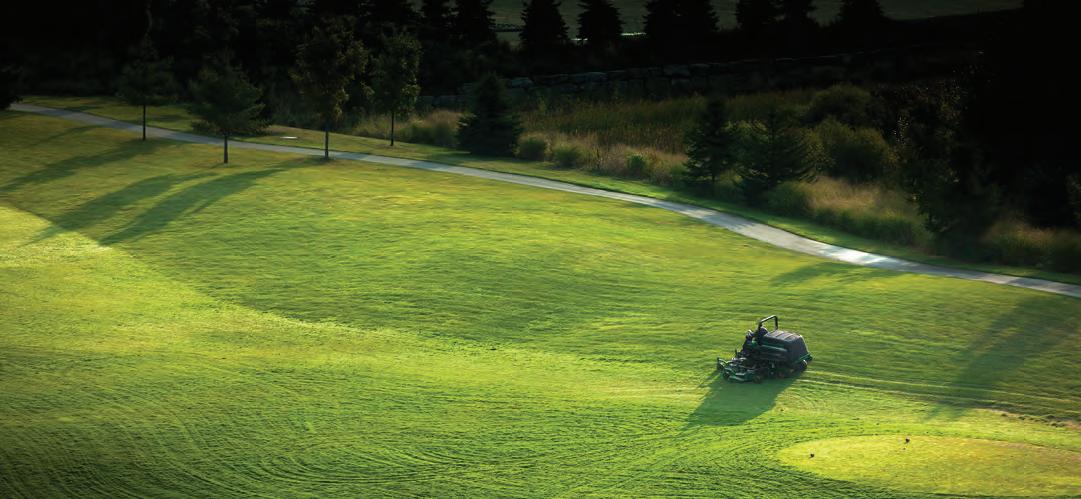

EXECUTIVE COMMITTEE
PGA’s Certification Program Vital for Pros and Clubs
PGA Professionals are the tie that bonds at golf facilities…forging connections and relationships vital to a successful golf club operation.
So how do PGA Pros bring value when seeking to engage new members while retaining members who already belong to their club?
Indeed, golf professionals are teachers, offering lessons to club members. While they are highly visible across many aspects of the golf industry, many club members have little idea of the training and background PGA Professionals bring to their work. To remain relevant in the ever-changing marketplace, all PGA Pros have access to resources and educational opportunities to enhance their effectiveness on the job.
The PGA’s lifelong educational certification program offers wide-ranging certification opportunities that sig-
paths: Executive Management, Golf Operations, and/or Teaching and Coaching. This training is on top of the extensive training that goes into becoming a PGA member.
These PGA certifications validate the knowledge base and skills and experience required by employers looking for talent to lead their golf business. It allows PGA members to use their certification to stand out from other applicants when competing for key roles that match their career aspirations.
“Our educational programming and certification in the lifelong learning strategy across three career paths provide a strong foundation for PGA leaders to differentiate themselves to employers. PGA Pros who are certified and/or receive the Master professional certification will have immediate credibility with employers,” explained PGA of America Chief Membership Officer John Easterbrook Jr., PGA.
“Whether it’s in executive management, golf operations or teaching and coaching, the PGA Professional has direct access to the best education and training available in the game. I really believe that the golf industry has benefited from the game being played outdoors, and while being played responsibly, it provides a much-needed opportunity to recreate in these crazy times. A lot of new players have been introduced to golf. Hiring a PGA Golf professional to lead the operations is the best opportunity to turn this spike into meaningful growth for our industry.”
— PGA of America Chief Membership Officer John Easterbrook Jr., PGA
nificantly increase the PGA Pros’ value to their clubs. PGA Pros help grow the game, engage club members, introduce new members and guests to the game, and most importantly, create golfers with a passion for the game – the connection that keeps members and guests passionately tied to their clubs and the game of golf.
PGA education has established formal certifications for those who have invested at least five years of their career (Class A Membership) in one of three dedicated career
What does this mean for the future and what does it mean for employers? Relevance and leadership within the golf industry foster an understanding from employers that these certifications will help with job placement, membership retention and, most importantly, membership growth.
It also means that more and more employers are hiring PGA Professionals to run the entire club. There are currently 1,468 PGA Professionals in the role of CEO and/or general manager at facilities across the United States.
To further enhance the training and development of executives in golf, the PGA is working with one of its partners at the University of Nevada-Las Vegas to assist with its life-long learning strategy for members employed within an executive management career path. UNLV, known for its leading global reputation in hospitality management, assessed the PGA’s current educational offerings to examine existing gaps in competencies that could support a member’s growth in a specialized path of executive management.
The creation of a university granting online certificate program to help prepare a member with skills and knowledge to ascend to overall enterprise management of a club or golf facility results from this two-year process.
“It’s tremendous for us to have a university granting certificate program from UNLV, a world-leading hospitality management program, available to our members,” said Easterbrook. The completion of the certificate program also assists members in completing PGA Certification requirements in Executive Management.
Golf is the core of many clubs. Golf members typically drive the highest dues and golf participation at daily access facilities pays the bills. Having a golf-centric and passionate leader that has come through a specific education programming that prepares them to lead a team will help grow
and retain the major revenue drivers at any facility. As an employer hiring a PGA member who can talk the game, play and grow the game will benefit their operations or clubs’ overall health.
How does this benefit the PGA Professional?
The PGA Pro knows the game of golf. “The executive management track overall, and our partnership with UNLV in particular, provides an ability for PGA Pros to round out their leadership skills to maximize customer engagement and operating performance. While this prepares executive management participants to lead any team in any industry, they are best positioned to drive success in business focused on golf,” added Easterbrook.
“Whether it’s in executive management, golf operations or teaching and coaching, the PGA Professional has direct access to the best education and training available in the game,” noted Easterbrook. “I really believe that the golf industry has benefited from the game being played outdoors, and while being played responsibly, it provides a muchneeded opportunity to recreate in these crazy times.
“A lot of new players have been introduced to golf. Hiring a PGA Golf professional to lead the operations is the best opportunity to turn this spike into meaningful growth for our industry,” Easterbrook concluded. BR

CONTEXT
ON THE FRONTLINES

NICOLE COUGHLIN
Nicole Coughlin is events coordinator, Superstition Mountain Golf and Country Club, a BoardRoom Distinguished Club, in Gold Canyon, AZ. Nicole can be reached via email: ncoughlin@superstitionmtngc.com
Superstition Mountain Finds Innovative Ways to Serve Members
This year has brought a lot of change and private golf clubs, like the rest of the world, have had to overhaul processes and find ways to continue to serve members while staying safe and within various COIVD-19 restrictions.
At Superstition Mountain Golf and Country Club, a BoardRoom Distinguished Club, we pride ourselves on providing members with a certain lifestyle. One that, in addition to golf, includes great dining, lively social events, a robust fitness program and top-tier service. So, what do you do when events are canceled and amenities are closed because of a global pandemic? You find new ways to move forward.
We were fortunate enough to be in a state, Arizona, where we did not have to close our two Nicklaus-designed golf courses. We implemented quite a few new guidelines to ensure
bership and staff. That’s when the team stepped up and found new, innovative ways to serve members and maintain our luxury, closely-knit, private club experience.
FOOD & BEVERAGE PROGRAM
Our incredibly talented Chef Michael O’Dowd (MOD) began offering daily specials for pickup and delivery. By limiting the menu, we were able to better manage F&B costs and keep club dining fresh and interesting for members. Wine, beer and cocktail kits have been available for delivery. During the height of the pandemic, we put together full meal kits for those who preferred to prepare food in their own home.
We’ve begun offering what we lovingly call MOD Market. Each week we send out a list of grocery items that will be available and members can place orders for pickup…everything from lobster meat and fresh produce to face masks and disinfectant spray. These services were especially appreciated when we were able to keep toilet paper on the list when many local stores faced an extreme shortage.
Perhaps the most surprising outcome of finding new, innovative ways to serve members … most of these new ideas will stay, even after COVID-19 restrictions are lifted. Aside from allowing us to continue operations during a global pandemic, these measures have given us a new way to connect with our members. Virtual events and on-demand fitness classes allow us to serve members no matter where they are. As a club, we have always tried to be open to growth and change as the needs of our membership shift. Even during a pandemic, we are continuing to learn more about how we can better serve our Superstition Mountain family. Now, and during whatever the next season may bring.
proper social distancing and sanitation but play continued. Adding hands-free flagsticks and touchless ball retrieval levers to our pins, ensuring no one outside of the same household shared a golf cart and adding extra cleaning measures was the easy part.
Closing our clubhouse facilities and stopping all events had the largest impact on our mem-
EVENTS
The lack of socialization has perhaps been the most difficult for many people. We crave human connection and our members are certainly used to a full social calendar. To supplement in-person events and gatherings, we began hosting weekly virtual member mixers. Streamed live on Facebook, members could tune in from anywhere in the world to watch me, our GM and weekly special guests share a few
drinks and talk golf, club news and world happenings. Members can ask questions during the live stream and connect with their friends and Superstition family in the chat.
We’ve had mixology lessons from our bar manager, discussed playing competitive golf with our talented LPGA members, got fitness tips from the sports cub team and talked shop with our director of agronomy. It’s informative and fun with lively conversation, plenty of laughs … and a few cocktails.
Each week brought something new. After more than 20 virtual mixers (as of early September), members are still engaging online and excited for their weekly happy hour, even if it looks a little different this season.
In addition to the mixers, we began streaming live music performances, comedy shows and rounds of bingo. We’ve even done virtual wine tastings with members able to pick up the wine selections ahead of time and follow along at home.
The virtual events allow members to stay engaged with the club and their fellow members and have gone a long way to ward off quarantine boredom.
FITNESS AND WELLNESS
The closure of gyms naturally extended to our sports club and the team pivoted quickly to stream classes online. They’ll even go the extra step and help mem -


bers set up their Zoom accounts if they are having trouble logging in.
Our fitness experts have also developed a virtual fitness library of recorded classes that can be accessed from anywhere at any time. Whether it’s getting in a quick Zumba class, continuing work on mobility training or enjoying a Yoga session, members can take classes from the club’s fitness experts at their convenience and from the safety of their own homes.
Extending wellness services, our massage therapist is offering in-home appointments. So, after a tough virtual workout, members can relax with a professional massage.
BENEFITS
Perhaps the most surprising outcome of these changes is this … most of them will stay, even after COVID-19 restrictions are lifted. Aside from allowing us to continue operations during a global pandemic, these measures have given us a new way to connect with our members. Virtual events and on-demand fitness classes allow us to serve members no matter where they are.
As a club, we have always tried to be open to growth and change as the needs of our membership shift. Even during a pandemic, we are continuing to learn more about how we can better serve our Superstition Mountain family. Now, and during whatever the next season may bring. BR


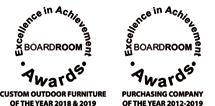

ROYAL CARIBBEAN INTERNATIONAL
PHOTO COURTESY OF
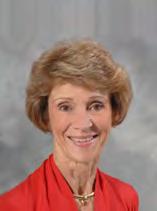
Bonnie J. Knutson, Ph.D., is a people watcher. A professor in The School of Hospitality Business, Broad College of Business, Michigan State University, Dr. Knutson is a member of the Country Club of Lansing and the Michigan Athletic Club. She can be reached via email: drbonnie@msu.edu
They Have Been Called Millennials on Steroids
In the early 1990s, two historians, William Strauss and Neil Howe, published the first of their several books on generational history. They determined that a generation lasts about 20 years, which is the length of time of one phase of a person’s life.
They also determined that the members of each generation will always be connected because they shared life-defining experiences during their formative years, i.e., world events, natural disasters, economic conditions, politics, technology – and yes, pandemics.
These common events are called markers because they create bonds that tie consumers of a generation together into cohorts with similar attitudes, values and life skills that affect everything from how they spend their time and money, including joining and being active in a club.
Today, the belief that you must promote to different age groups differently is accepted as a marketing truth – by butchers, bakers, candlestick makers, and clubs. Clubs who use generational marketing principles to understand the factors that influence the values and buying motivations of members (and employees) stand a much better chance of spotting trends to reach members, and prospective members, in revenue-generation new ways.
For the first time in history, we are approaching five generations of members (and employees), each with its own set of characteristics, values and “hot buttons.” Our memberships already include the Traditionalists, which Tom Brokaw deemed the Greatest Generation, the big Baby Boomers group, Generation X, the smallest cohort, the infamous Millennials, or Gen Y, the largest and most-consuming generation in history. At least so far.
So just when you think you have the Millennials figured out, hold on to your hat because here comes Generation Z.
The venerable Pew Research Centers (PRC) cautions, “Generational cutoff points are not an exact science. They should be viewed primarily as tools…Generations are often considered by their span, but again there is no agreed upon formula for how long that span should be.”
GEN Z
With this caveat, PRC says that those born 1997 onward are part of a new generation called Gen Z. And because they do share some of the characteristics of the preceding cohort, they have also been deemed Millennials on Steroids. This means that the leading edge is finishing college, entering the workforce and becoming your future members and employees. So, let us take a look at three ways their views have been shaped and how that will affect your club in the future.
First and foremost, Gen Z members are digital natives, less in sync with the ABCs and more in sync with the three As – Apple, Amazon, and Alphabet. Coming of age with anywhere-anytime connectivity, they are defined by a higher degree of “now-ism” than are their older counterparts.
They have a shorter attention span and retain less knowledge because they can always “google” the vast amount of information available to them with just a few clicks. Technology is their life; social media is their constant companion.
When is the last time you saw a Gen Y without earbuds and a phone in their hand, in their pocket, or strapped to their arm? Such reliance – some would say addiction – has resulted in a generation that reads less, has fewer social skills, is less prepared for adulthood, and is less happy and certain about the future than their predecessors.
Yet with the all-encompassing hold that technology has on their lives, they crave human interaction above and beyond Zoom, YouTube, Instagram, Snapchat, and TicToc (email is pretty passe for them). Recent data show that they spend an average of 11 hours a week on mobile devices and stream about 23 hours of content every week – more than any other generation.
About 75 percent communicate with others more digitally, but they still appreciate being face-to-face. To paraphrase the futurist Alvin Toffler, The more technology invades our lives, the more we need the human touch. See the opportunities for your club?
Second, their formative years were inundated with cultural changes brought to them live and in living color on their small screens. Brexit. The Arab Spring. The 2008 financial crisis. Title IX. The Supreme Court ruling on same-gender marriage. Pro-athletes taking a knee. And, more recently, the issues of social justice. All of these have made this generation skeptical of the institutions around them.
At the same time, they reflect the variations in diversity, equity, and inclusiveness in their many forms. This generation understands the contradictions fostered by these changes, so are flexing their voices and their economic muscles to drive change. These shifts have major impacts for bylaws, boards, membership, and employees for the club industry that was initially built on status, privacy, and exclusivity.
And, oh yes, did I mention that Gen Z wants – make that demands – instant feedback! See the opportunities for your club?
And third, these young people are driven by individualism with strong heads, strong values and a belief that they can make a difference. Gen Z are self-starters and love to find innovative ways of solving problems because they are open to people, no matter how different they are.
At the same time, they also realize that these transforaminal issues are too big to be solved by them alone. In this way, they are very much like the traditionalist who faced world wars, the Great Depression as well as social disruptions. Their mantra seems to be: Let’s work together to address this issue. See the opportunities for your club here too?
Whether called rebels, rule-breakers, disrupters, or just plain troublemakers, it is the young people – i.e., the next generation – that has driven change. Remember when the censors would only allow Elvis’ performance on the Ed Sullivan Show if he were shown only from the waist up?
Remember when, in 1946, the world was shocked when the bikini hit the beaches? And remember when, in a historic change at one of the world’s most exclusive golf clubs, Condoleezza Rice was invited to become the first female member since the club was founded 80 years earlier?
“Gen Z’s influence in the workplace, economy and society will be increasingly felt in the coming years.” It will be exciting to watch our clubs embrace it and grow with it.
Your bottom line will thank you! BR
The health of our customers is our top priority. Each Eustis Chair is custom made in the USA and comes with a 20 year warranty. Our stacking chairs are easy to re-configure in your space and easy to disinfect.

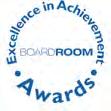
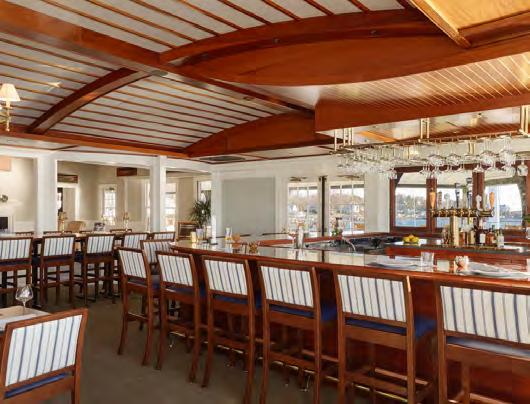
Contact us today to discuss your next remodel or design project. EustisChair.com
Phone: 978-827-3103


EXECUTIVE COMMITTEE
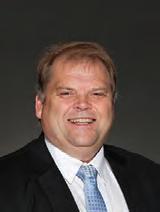
KEVIN WALLS
Kevin Walls is a Career Consultant for the PGA of America. He can be contacted at (662) 306-0719 or by e-mail at kwalls@pgahq.com.
The PGA Professional Can Help Drive Amenities
Clubs continue to evolve from the traditional model by the addition of new amenities, which have become a popular essential, something desired by both existing and potential members.
Fitness centers, golf teaching centers, pickleball and coffee/virtual office areas are new trends that will be around for some time.
Fitness has become one of the top activities at clubs behind golf and dining. Most members find being healthy and staying physically fit is very important and a personal goal. A great fitness program can help maintain the members health and keep them more active, so they can visit the club more often and extend their years of being able to enjoy the club.
A great year-around club fitness center is a great member asset and members do not have to join a gym in the area and pay for another fee. Quality fitness accommodations are a great way to attract a new member and families.
The number of members of the club will dictate the services and programs that can be offered. The club must offer the right programs that fit the membership and offer specialized programs such as the Titleist Performance Institute (TPI), TRX suspension training, muscle therapy, mediation, martial arts, yoga and Pilates. Some clubs also offer massage, spa and salon services, physical therapy and other athletic specific training. Healthy diet and cooking classes by the culinary team have shown success as well.
The PGA Professional can drive revenue and participation. As a matter of fact, this topic has been brought up in several interviews in our Head Professional searches on how the golf professional can help promote the wellness and fitness center. They can also stress the importance of being physically fit, improvement in the overall golf swing and promoting fitness programs to the junior golfers. The PGA Professional can coordinate with the fitness director to create golf specific classes to enhance the members’ flexibility and physical movement to improve their condition.
Technology is a big factor on the expansion of golf practice facilities. During COVID-19, most golf facilities have had a heightened demand for rounds of golf and had to look at new methods to satisfy golfers. Limited time restraints have become more normal as golfers have less time to play a full round so quality practice amenities will become more popular.
• Golf simulators offer members the opportunity to practice in a comfortable environment 12 months of the year and enjoy games with friends during the downtime.
• Launch monitor technology: State-of-the-art monitors can measure ball flight and club data from six-yard pitches to over 300-yard drives. The ForeSight GCQuad uses four high-speed, high-resolution cameras to capture ball and club data at impact. The TrackMan 4 uses doppler radar technology to capture swing data and display a 3D trajectory of each shot in real time.
• SAM PuttLab: This allows golfers to understand their individual strengths and weaknesses for more efficient training by analyzing the 28 most important parameters of a golfer’s putting stroke.
• Biomechanical 3D Analysis: Using MySwing (which creates a 3D rendering of a golfer’s swing much like an MRI captures your body), K-Vest (a wearable system that tracks biomechanical data) and a BodiTrack pressure mat (which records balance distribution), every aspect of a golfer’s swing and body mechanics can be recorded and analyzed to improve their game.
• TPI : Allows PGA members to become certified on the study of how the human body functions to the golf swing. A functioning body allows a player to swing the golf club the most efficient way possible and how physical limitations can adversely affect the golf swing and cause physical injury.
By combining quality golf instruction along with providing a physical improvement program both the golf teaching center and the fitness center can be successful and popular amenities.
Health and fitness are the future. By focusing more on diets, wellness and revamping fitness amenities, golf clubs can stay up to date and encourage members to use the facilities more frequently. Clubs that give their members the features and services they want will establish a strong footing for success.
The PGA Professional and staff are in the perfect position to help other amenities be successful. They should be included in the overall plans in making these club amenities successful for all members. BR


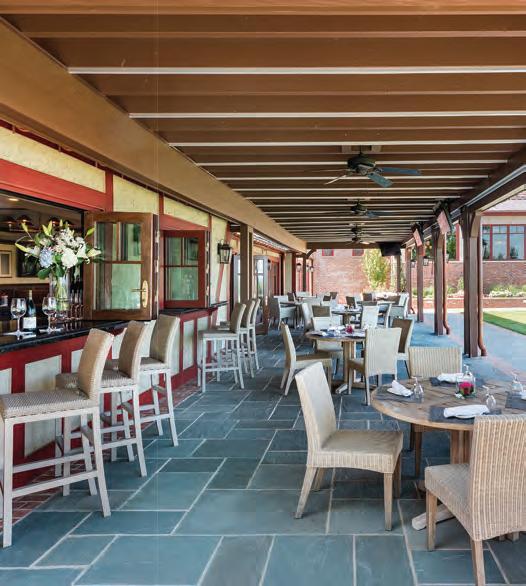

RACQUET COMMITTEE
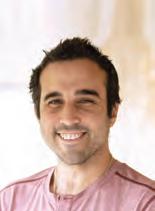
JARRETT CHIRICO
Jarrett Chirico, USPTA,PTR, PPTA,PPR is director of racquets, Baltimore Country Club, Baltimore, MD. Jarrett can be reached at (410) 889-4474; Cell (310) 405-3949, or via email: jchirico@bcc1898.com
The What and How of Innovation
I’m continually intrigued reading articles and posts about innovation and change. We’re in an industry that grounds itself in tradition and it’s there that many leaders have fallen prisoner.
By definition, innovation is the action or process of innovating or in the simplest of terms, enacting change. Many clubs fail because of their inability to do just that –change. Leaders get so caught up in doing one thing perfectly that they are afraid to innovate, afraid to fail.
If COVID-19 has taught us anything, it is that the clubs that have not pushed for more before this pandemic won’t be around to play catch up when it is over. In the end people don’t fail because they lack resources, people fail because they lack resourcefulness, they lack the will to step outside of their comfort zone.
True innovation is understanding the difference between what we offer and how we offer it. The ‘what’ never solves the problem.
Clubs can provide more amenities, more programs and more options, but if we do not connect it back to our history, it will simply get lost.
The ‘how’ is the make-it-or-break-it of innovation. The ‘how’ connects new ideas to our clubs’ long traditions forged over decades of service.
It’s one thing to try something new (anyone can do that), but it’s another to make it your own. That’s where the magic happens.
Here’s a simple example. Tennis is struggling and if statistics hold true, pickleball will be the most played racquet sport in the United States within the next decade. Although many clubs still deny the need for pickleball (this will eventually change), more clubs than ever before are adding it to their program.
Despite the unprecedented numbers of people playing, not all clubs succeed with pickleball. This is because directors focused on the ‘what’ (which is adding pickleball) but have forgotten to invest the time in figuring out the ‘how’ (it should be offered at your club).
Pickleball is only as good as your staff, your programming and your investment in racquets. Facilities can always catch up later.
As leaders we have three responsibilities: To understand traditions, anticipate what’s next and to have the ability to merge the two. First, we have to understand clubs’ deep-rooted traditions and members we serve. Secondly, we continually have to be searching for what is next.
We have to think not where the industry is, but where it will be in five to 10 years. In many ways, we have to be able to predict the future correctly.
Finally, we need to be able to merge our understanding of the past and our prediction of the future. This is true innovation.
It is saying, “yes”, pickleball will work if it is aligned with the right staff and will ultimately grow our racquets program. If we can get golfers using more of our club facilities and more members engaged, we have solved the how To simply add pickleball (or whatever it may be) we would only be solving the what and that’s not innovating, that’s wasting money.
Despite the many hardships and challenges ahead, if COVID-19 has shown us anything positive, it’s that leaders are uniting like never before. Collaboration breeds new ideas.
New ideas wake up our desire to take risks again, try new things (as crazy as they may seem), and to change. It has taught us to innovate again. Finally, we are all looking to each other for ideas and our staff and membership are looking to us. Clubs can come out of this and prosper like never before.
Success will depend on how we connect what we are offering to the understanding of how we can make it our own within our clubs’ traditions.
Remember, true innovation is not about what you offer but how you offer it!
Good luck, my friends. The best is yet to come! BR
DAVE MOYER
Dave Moyer is a USPTA Master Professional and the director of tennis at The Country Club at DC Ranch in Scottsdale, Arizona and can be reached at dmoyer@ccdcranch.com
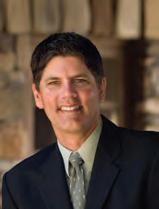
RACQUET COMMITTEE
Promote Tennis As The Healthy And Safe Alternative
Throughout this challenging 2020, we’ve heard the phrase, “For the health and safety of everyone involved” too many times to count.
At our clubs, we have had to develop programs, staff and reopen with that important phrase in mind. Fortunately for the sport of tennis, there hasn’t been a better activity to allow members to use their clubs and facilities safely.
From a wellness perspective, tennis is one of the few activities that allow participants an aerobic and anaerobic physical workout, a mental workout and great socialization. You can count on one hand the number of sports that combine all four. During this pandemic, the social aspect has been the number one factor for the rise in tennis participation.
Clubs and facilities that have recognized members’ ability to play tennis safely have seen record numbers in participation and revenue.
This has been a great opportunity for families to come together and play, friends to participate in singles and doubles games and for clinics and lessons to continue safely with strict guidelines and protocols.
So, what can your facility do to capitalize on the surge in tennis participation?
Start with promoting the benefits of tennis to your members through communication in emails, newsletters and social media making sure to hit on the key aspects of tennis as a healthy sport. Staying active and playing tennis promotes weight loss, cardio activity, a healthy heart and mind.
Many kids are at home right now learning remotely so this is a great opportunity to promote a healthy lifestyle. Get them away from the screens and out on the tennis court with other kids.
Follow that up with a program that promotes fun, safety and social distancing. We have had to modify our program slightly to accommodate smaller groups.
We put together a program that offered more variety of days, times and types of clinics, which has allowed us to keep the number of participants lower.
It was a win all the way around because our club was busy, our pros had more opportunities to get on the court to earn money and members felt safe at the club because we weren’t having large groups coming at one time.
What types of programs can you provide that are safe but hit on all the health benefits of tennis?
• Increase the number of “cardio” type tennis clinics, which emphasize continuous movement. Incorporate ladders and other fitness equipment into the equation that members do not have to touch and cross contaminate. This allows players to spread out, get their heart rate up and feel like they got a great workout if you want to feel like you are providing a safer environment.
• Come up with live ball drills involving strategy and scoring also to give a mental workout. One of our most popular drills is a game called 41, which requires four players per court and is a fast-paced game played to 41. Action is nonstop and different points are awarded depending on how the point is one.
For instance, you get five points for a volley winner, four points for a groundstroke winner, etc. This not only gives your members a great workout but forces some mental gymnastics as well.
• Finally, program for the social aspect of tennis. You can safely have members come to round robins if you have systems in place to keep players from gathering. Don’t take more signups than court space allows so that players aren’t sitting out and talking to each other in close proximity. Have family events or do a couples drill so that good friends can socialize with their spouses.
Tennis has been a great sport for many years but is the right sport at the right time during COVID-19. Take advantage of all the health benefits that tennis offers by providing a safe and fun environment for your members. BR
RACQUET COMMITTEE
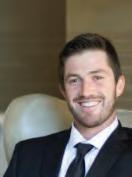

Appreciating Tradition While Embracing A Racquets Program
It’s important to understand that traditions are traditions for a reason – people find value in them.
As evolving lifestyles and changing demographics are making a strong presence in the private club industry, it’s important that we, as racquet leaders, find what members are looking for in terms of value.
Private clubs are starting to see a strong dominance of Millennials, a generation very conscious of its financial spending and planning, as well as a time-constrained lifestyle. As racquet directors, we need to make sure this generation finds value in our offerings.
Founded in 1854, The Philadelphia Cricket Club is one of the oldest country clubs in the country, and when stepping onto the St. Martins campus, you are greeted by 21 beautifully maintained grass courts.
In 1881, the club was one of the United States Lawn Tennis Association founding members, today known as the USTA.
The club hosted the inaugural U.S. Women’s National Singles Championship in 1887 and continued to host the event until 1921, when it moved to Forest Hill. The Women’s National Doubles Championship, which started in 1889 and Mixed Doubles Championship, which began in 1892, were also held at the club until 1921. These events later combined with the men’s singles and doubles championships to form the U.S. Open. There is no question the tennis history at Philadelphia Cricket Club is priceless.
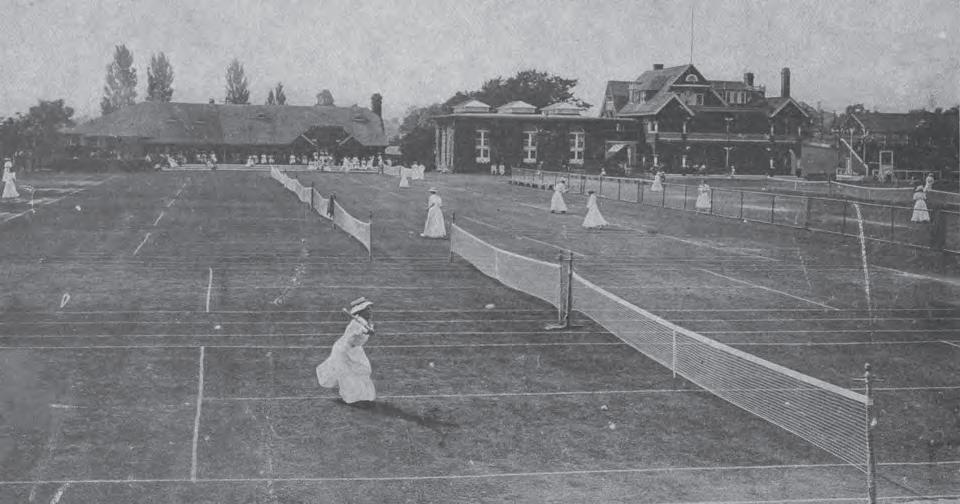
PLATFORM TENNIS
For clubs located outside of the Northeast Region, it might come as a surprise that Philadelphia Cricket Club has one of the most dominant platform tennis programs in the country. It consists of socials, competitive leagues, camps, clinics, and company outings.
With heated courts, platform is a winter sport and offers members an opportunity to exercise and socialize outdoors during the colder months. The club’s newly renovated platform tennis facility includes four courts, all lit for night play, and a pavilion with an indoor/outdoor fireplace, two outdoor decks, and comfortable inside seating areas to complement a fully stocked bar.
Platform tennis, in a way, has started its own tradition at Philly Cricket, where members have enjoyed memorable experiences through programming in which membership found value.
PICKLEBALL
Pickleball is here to stay and Philly Cricket is taking advantage of the fastest growing sport in the country by building four permanent pickleball courts for our members to enjoy. The beautiful aspect about pickleball is that it brings all different demographics together because the learning curve is so short and members transition into playing games right away.
SQUASH
Squash at The Philadelphia Cricket Club continues to evolve as the sport evolves globally. Squash transitioned from solely hardball
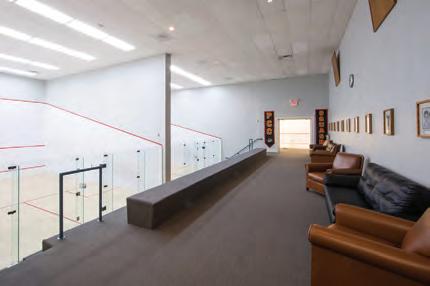






ELIZA SELIG
Eliza Selig is the HFTP director of communications. She can be reached at (512) 220-4026 or eliza.selig@hftp.org.
Finance-focused Tips Every Club Professional Should Know But
Have Never Asked - Part I
Many of us working in clubs are firmly focused on our responsibilities, ensuring our corner of operations is running effectively and positively.
While operating a club is definitely a team effort, we often rely on our team members to do their job well alongside us, without knowing exactly what the details are to get their job done. We asked club finance executives, members of Hospitality Financial and Technology Professionals (HFTP®) to run through some tips that help make the club business side a smooth operation. Some tips may seem like a no-brainer, but we hope a few give you an “aha” moment.
Tip 1: Identify any ghost employees that might be present on your payroll.
Daniel N. Conti, Jr. CHAE, CAM CFO, The Jupiter Island Club
With the push for direct deposit for employee compensation at many clubs and the spread-out nature of the numerous club departments, the potential for ghost employees exists. A way to verify that indeed the employees on the direct deposit payroll are real is to switch off the direct deposit on a given week and instead distribute live checks.
The key is not to announce that this is being done until after the managers have approved the payroll and submitted it. Then process the payroll using live checks and handing them over to either the HR director or CFO to distribute. Announce to the employees that all checks will be live that week and need to come in with a picture ID to pick up their check.
Any checks that remain after employees have picked up their checks would need to be investigated and confirmed as belonging to a legitimate employee or ghost employee. It is also prudent, if possible, to do this without your payroll administrator’s involvement — just in case there is a fraudulent scheme in the works that involves them.
Tip 2: Allocate a 60-day cash reserve for operational purposes.
Stephanie Anderson, CHAE, CPA, CGMA CFO, River Bend Golf & Country Club
Many clubs focus on planning for capital projects and review cash flows for this purpose regularly. As a function of working on a zero-based balanced budget, operations are sometimes either funded by initiation fees when dues are not high enough and/or they have a breakeven operational budget. The problem is that when these stress scenarios are encountered, the cash is not there to support the period of stress. Our club allocates a 60-day cash reserve for operational purposes. For some, this may seem like a lot, but it allows the flexibility to deal with short term stress from either COVID, fire, hurricane, etc.
Tip 3: Conduct a fixed asset inventory.
Many clubs understand the importance of making sure there is not anything on the depreciation schedule that the club no longer owns and that the club’s recorded assets are correct. However, it is just as important to conduct regular inventories of fixed assets to ensure no significant assets are not capitalized.
For example, after an inventory at a previous club I worked at, I found more than four large assets that were not part of the depreciation schedule. After further investigation, I was able to determine what was behind this and where they were expensed. The manager was under the impression that he could not get approval for these items as capital expenses. Rather, he was able to get an increase for these as operational line items and they would be less scrutinized. To maintain this ruse, he was able to get fake invoices from three different vendors over five years to be approved.
In summary, a fixed asset inventory verification is very important for a club, even though depreciation is not the most important thing for a 501(c)(7).
Tip 4: Have your controller/CFO at board meetings and any other meetings where financial results are discussed.
Thomas Smith, CHAE Chief Business Officer, Imperial Golf Club
For the GM, it means having another person to help you get things across to the board. For the board, it means they have more than one voice from management. It also significantly helps when financial decisions are being made at a board meeting.
Based on my experience, it has helped build a partnership between the GM and CFO and that’s very important to having a successful club. I attend every board, finance, house, planning and membership committee meeting. Being there gives me the chance to stop things before they start “rolling down the hill.” It also allows me to get to know and educate the committee members who might be on the board of directors someday.
Tip 5: Make time for re-training.
Jill Burnett, CHAE, CPA
CFO, Medalist Golf Club
Take stock of the areas your employees can build their knowledge: operating software, email system, timeclock software (scheduling), club website, Excel and Word and make the time for training. All these systems consistently have new features added and it is wise for employees to take advantage of them. Coordinate training during slower seasons, which can be done by knowledgeable staff volunteers in house. One suggestion is to have the volunteer select a topic, develop an hour-long training session and
from Racquet Committee | 78
courts, a version of squash unique to North America, to eight softball courts in the early 1990s as the United States adopted the international version of the game. There are also two hardball doubles courts.
This court setup, coupled with the world-class facilities, means PCC is often used as the host venue for major national championships, most recently the U.S. Men’s & Women’s National Championships and U.S. Collegiate Doubles National Championships.
Widely known for its junior program, PCC has produced 41 national champions across multiple
schedule a lesson for others on that topic. This helps empower your employees to develop their leadership skills and think critically.
Tip 6: Understand board members’
fiduciary responsibilities
Frank Wolfe, CAE, FIH
CEO, Hospitality Financial and Technology Professionals
Fiduciary means “involving trust, especially the relationship between a trustee and a beneficiary.” As a club board director, one is trusted by the members and has to act as their representative regardless of personal beliefs. As a representative, the director has to put the interests of the club members collectively first. Directors need to exercise sound business judgment and while they don’t have to always make the right decision, they should use common sense.
Another part of this trust is being able to “keep a secret” until the appropriate time comes along. Take, for example, a group of members who are suing the club based on a disagreement. The board, who has a minority faction agreeing with the claimants, has an initial conversation with an attorney for the appropriate course of action including the risks of damages.
Even though the minority faction agrees with the members filing suit, they have agreed to represent the entire community. Since the board is the opposing party in a lawsuit, all directors involved have a duty to keep what they learned confidential. BR
Part II of this series will be published in our January/ February 2021 BoardRoom magazine.
age groups and continues to be an avenue that junior players take to gain recruitment spots at colleges across the country. The PCC performance pathway, mapping out a player’s development from their entry into squash through college recruitment and beyond, gives our members an excellent grounding in the sport.
Many junior players are now adult members and participate in successful inter-club leagues and some iconic member/member and member/guest events. Clinics are offered for all levels; ladder play, box leagues, and club events ensure the membership stays engaged both competitively and socially.
EXPAND OFFERINGS
To create value for members, we must continue to expand our racquet offerings, which can eventually turn into traditions based on how members view it. The more we offer as racquet directors, the more we connect with different aspects of membership.
We must protect old traditions while creating new ones to find value for our membership. BR
Boris Fetbroyt is the director of racquets at The Philadelphia Cricket Club. He can be reached at bfetbroyt@philacricket.com.
Rich Wade is the director of squash at the Philadelphia Cricket Club. He can be reached at rwade@philacricket.com
NANCY’S CORNER

Leadership in a Crisis
LPGA Commissioner Mike Whan
NANCY BERKLEY
Nancy Berkley is an expert on women’s golf and junior girls golf in the U.S. Nancy is a member of the World Golf Foundation Women’s Committee, and a member of the National Golf Foundation. She shares news about women’s golf – along with her opinions on www.nancyberkleygolf.com. Nancy has served on the governing boards of two golf clubs and currently is on the green committee and marketing committee at Frenchman’s Creek Beach & Country Club. She is a contributing writer for LPGA publications.
Mike Whan marketed toothpaste, hockey and golf clubs before becoming commissioner of the Ladies Professional Golf Association.
The LPGA, one of the world’s longest-running professional sports associations, was founded in 1950 by 13 women affectionately referred to as The Founders.
In 2010, when Roberta Bowman, the president of the LPGA board of directors, asked Mike to become the LPGA commissioner, the Tour was struggling with managing a women’s global golf tour.
Mike brought management skills to his role as LPGA Commissioner. The LPGA Tour conducts over 30 tournaments annually played on four continents. Since the LPGA Tour has resumed tournaments in August 2020, the Golf Channel reports that LPGA tournament telecasts average 23 percent more viewers than before the COVID-19 outbreak.
Bowman confirmed that more companies are following the lead of KPMG and sponsoring women’s leadership conferences along with LPGA Tournaments.
Two years ago, I joined Mike in his golf cart as we traveled around the Diamond Resorts Tournament of Champions celebrity LPGA event at the Four Seasons Golf and
Sports Club in Orlando, Florida. The most memorable happened when Mike stopped the cart to ask an elderly fan using a walker if he wanted a ride up the hill to the next tee. Most people who work with Mike know that kind and caring side of his character. Mike has three adult sons and a lovely wife, and over 200 active LPGA Golfers that Mike protects like daughters.
Last December, the Commissioner announced the 2020 LPGA tournament schedule of 34 events – more global with more prize money, sponsors and innovative formats than in previous years. The Dow Great Lakes Bay Invitational at Midland Country Club in Midland, Michigan, a member of the BoardRoom Distinguished Club program, was scheduled for its second year July 13-18.
As the 2020 season began, Mike couldn’t have anticipated the global pandemic that has challenged the schedule and his leadership skills. Mike first started hearing about the coronavirus just as the Tour headed to Australia for two tournaments. Thailand was the next stop.
“I remember thinking to myself: Come on, this is just another bird flu. We’ll figure our way through it,” he recalled.
The Thailand government canceled the mid-February
Midland Country Club, a BoardRoom Distinguished Club Welcomes the LPGA Tour

Midland Country Club in Midland, Michigan, is the only member of the Distinguished Club Program that currently hosts an LPGA tournament: The Dow Great Lakes Bay Invitational, an inaugural two-person team event.
After a very successful 2019 team tournament, Covid-19 concerns caused the 2020 tournament
to be canceled. The LPGA Tour extended the Midland Country Club contract out one more year – to six years.
Todd Beals, Midland’s general manager, when asked why Midland hosts this tournament in the middle of the summer depriving club members of its golf course, he explained, “that many tee times are provided to Midland’s members at other clubs who in exchange can watch the great LPGA women golfers. Another benefit is that the tournament brings tourists to the area, adding millions of dollars to Midland businesses.”
But why is Midland Country Club the only Distinguished Club hosting an LPGA tournament? With the increase in women golfers and fans, a women’s golf event should be a great club attraction. Check out the club’s excellent website www. midlandcc.net. The club’s compelling marketing message: Where Tradition Thrives. Where You Belong, welcomes back the LPGA next season. BR
tournament. The Tour arrived in Singapore for the HSBC Women’s World Championship the last week in February. That’s where Mike said he heard the word “quarantine” for the first time. He learned that should any player test positive for the virus, all his Tour players would be locked in their hotel rooms for 21 days. Mike canceled the Singapore event.
He also canceled the next southern China tournament and headed with the Tour players back to the U.S in February. Twenty-seven LPGA tournaments remained on the 2020 schedule to be rescheduled or perhaps canceled.
I questioned Mike about his decision making. He explained that the “old” Mike took pride in what he called “aggressive mistakes.” If something didn’t work, he would fix it. But he was learning that in a pandemic, you can’t take what he described as a haphazard approach.
Here are excerpts from our interview. They reveal how the commissioner’s leadership skills were impacted by managing the LPGA Tour through the Covid-19 crisis.
Q – What is it like to be the commissioner and affected by events beyond your control? Has this happened to you before?
MW –The similar feeling was 9/11, where your footing is uncomfortable. You feel like you need to get consensus, but half of me wants to make decisions and figure out what went wrong later. But in a pandemic, you can’t take that haphazard approach. I remember back in March when we returned from Asia and I went around the table and asked, “Can we just play the next events?” Everyone looked at me and said, “We have to stop.” I was so proud that they were bold enough to say I was wrong. It was a wake-up call for me.
Q. About rescheduling events back in the U.S. Is there anything you would have done differently?
MW – To answer honestly, I would’ve canceled some of our U.S. events earlier. My fight to keep them on the schedule cost the Tour a couple of million dollars because once you “build-out” for a tournament, the LPGA has all the costs for everything rented and leased from bleachers to porta-potties. So now we have what we call the 45-day rule. We’re not going to start spending money that we can’t get back until 45 days before an event.
Mike Is Like a Symphony Director

Q. Were you worried that by canceling tournaments that you would lose your audience for LPGA Tour? And how about losing sponsors?
MW – I told our players back in April that I wasn’t going to force any sponsor to do something in 2020 because they have a contract. When you’re in the middle of a crisis, telling somebody what they have to do because that’s the piece of paper they signed is a way to not be in business with them long term. What I have asked sponsors is to give me one more year on our contract.
The 2020 LPGA Tour season will be remembered for the tournaments that were played and those that were canceled. It will also be remembered as the year that the LPGA Commissioner Mike Whan led the LPGA Tour through a pandemic with his team at his side. BR
Roberta Bowman became the LPGA’s chief brand and communications officer in October 2018. Before her current role, Roberta served on the LPGA’s board of directors and board president when Mike Whan was asked to be the Commissioner in January 2010.
As a senior executive at Duke Energy for many years Roberta brought her strong set of marketing and branding skills to the LPGA. She developed the LPGA’s “DriveON” message that highlights the inspiring LPGA Tour players. She knows the commissioner very well and shared the following insights in describing his leadership style.
“Mike has some northstars: The first is what’s best for his LPGA players and the second is to follow in the footsteps of the LPGA’s Founders. He is a long-term thinker and values the richness of different points of view. When you talk with Mike, you feel like you are the only person in the room. He gets the best out of all of us on his board. Mike’s like a symphony director. He has embraced the notion that women’s sports present opportunities that are without limits and that idea is drawing sponsors to the LPGA.” BR
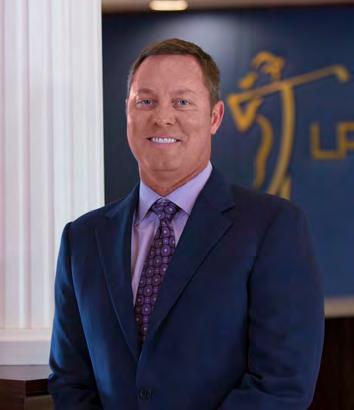

Steve Schendel is vice president/agronomist with Golf Maintenance Solutions. He can be reached at (630) 220-5977 or via email steve.s@golfmsolutions.com
Has the Audible Become the New Normal?
Successful leaders and golf course superintendents are very good at adjusting to conditions around them.
To use a sports analogy, we can refer to a quarterback who has communicated the play to his team inside the huddle. After they approach the line and he reads the defense, the quarterback may call an audible to adjust the play for a better chance of success.
While audibles are often called in golf course maintenance because of weather, play levels, staffing shortages, or special events, 2020 has brought us a pandemic, forcing us to make golf course adjustments. This year we all have seen innovative ideas to help create a new way to play the game while practicing social distancing.
Flag sticks that are not touched, removal of bunker rakes, water coolers not utilized and an overall reduction of “touchpoints” are just a few of the adjustments that have taken place on the golf course.
We all know that this spring golf courses were challenged with play restrictions and a need to operate differently. Interestingly, as we moved through the season, we began to learn some very encouraging news. Golf courses in many markets were seeing membership and golf participation up compared to recent years. This has certainly been very positive for golf courses throughout the country.
As we look at the industry’s current state, it’s important to look at what may have been a short-term adjustment and what may become the new normal. Some of these adjustments are easy to recognize, such as touchpoint reductions. Others are not as obvious but have had a very important impact on how golf courses have become successful again. Some of these include:
• New maintenance standards: We have seen and helped golf courses adjust maintenance standards. Even though rounds have increased at most properties, golf course maintenance has become more streamlined. This has helped create a realistic golf experience without getting caught up trying to overproduce conditions in market segmentation.
• Pace of play: Lengthened tee time intervals, individuals in golf carts, lack of bunker rakes, leaving the flagstick in are a few examples of necessary adjustments that have positively impacted pace of play and the golf experience. Everyone from an experienced golfer who wants to keep the pace flowing to the new players who hate feeling intimidated or rushed, pace of play has improved at many clubs and has helped create more interest in the game.
• Labor: While it was thought the pandemic would create a surplus of labor, the reality is that there still are challenges in finding quality employees. Unemployment/stimulus benefits and continued competition
for employees have continued to make it challenging to find and retain good labor. There will always be a need to find new ways to attract, train and retain good help. This never gets any easier and should always be a major focus for golf course maintenance.
• Scheduling: Part of being a successful superintendent is scheduling your workdays around play. Because of social distancing, many clubs have seen tournament rounds reduced. This has lead to potentially fewer shotgun starts and an opportunity to get out of the gate and ahead of play for less maintenance worker/player interaction and an opportunity for more efficiency.
• Automation/new technology: There is no doubt this year that we have evolved quickly into a world that operates differently. With a continued focus on health and safety, there has been and will continue to be a focus on less physical interaction and more automation.
Whether we like it or not, new technology and automation are becoming more popular than ever. The Golf Industry Show that was supposed to occur in Las Vegas this coming February has switched to a virtual learning interactive event. This is just one example of how we are becoming more of a tech industry, and it continues to be one of the biggest trends in the world we live in.
We know many clubs will be doing business differently in 2021. As we wrap up an eventful year, work with your golf course superintendent and focus on trends that are “more than just audibles” but new ways of doing business for success at your club. BR
DAVE DOHERTY
Dave Doherty is CEO and founder of the International Sports Turf Research Center, Inc. (ISTRC) and holds three patents regarding the testing of sand and soil- based greens. He can be reached at (913) 706-6635 or via email: daveistrc@hotmail.com
The State of the Industry We Learn from Experience
Today, our society is wrestling with the COVID19 pandemic creating a very difficult time for our private clubs.
Many golf courses and other recreational facilities have had to cut maintenance budgets significantly. On the maintenance side of the industry it’s understood that cuts are necessary, and most golf course superintendents and sports turf managers have adjusted and are doing a remarkable job with less funds, fewer staff members and other resources. However, I am amazed at the positive attitude at most facilities that I’ve visited in recent months.
A number of years ago, I wrote an article about a general manager of a golf course in the Midwest part of the United States, pointing out that one of his first actions as the new general manager was to call a meeting of all of the department heads during which he informed them that “they would each have to do a little more with a little less.”
This mindset of doing a little more with a little less has been very successful and the moral of the staff and the club membership is steady at a very high level. This club has a staff from top to bottom of personnel that think and operate together in a calm rational manner and base their decisions on knowledge, science and experience.
In addition to recreational dollars being at an all time low, Mother Nature has been extremely cruel in many parts of North America and the rest of the world. We have had extreme moisture followed by heat that has set all time records and in some cases the moisture and heat have come at the same time.
Texas, for example, experienced over 60 days of 100F-plus temperatures and severe drought. As a result, the stress on bent grass

GREEN COMMITTEE
facilities has never been greater. When the prolonged heat, for example, came we were, in most cases, unprepared and suffered from a tremendous amount of lost turf. We learned that in such heat induced stress conditions that our plants needed more air movement on the surface and more oxygen needed to be introduced to the root system.
With this firsthand knowledge gleamed from our experiences, we were better prepared for the heat and stress that followed. In most cases the greens just needed better surface air movement and more oxygen in the root zones.
Courses that suffered severe damage back then because of heat/moisture stress needed to look at the physical properties of their soils as well
Texas, for example, experienced over 60 days of 100F-plus temperatures and severe drought. As a result, the stress on bent grass facilities has never been greater. When the prolonged heat, for example, came we were, in most cases, unprepared and suffered from a tremendous amount of lost turf. We learned that in such heat induced stress conditions that our plants needed more air movement on the surface and more oxygen needed to be introduced to the root system.
as the soil chemistry, disease and insects. In 90 percent of the cases, if science shows that our physical and chemical properties are acceptable and that we have no disease or insect issues and that our irrigation water is acceptable, than that only leaves tree root invasion, lack of oxygen in the root zone and or lack of air movement on the surface.
Shade or lack of sun accounts for the other nine percent of turf loss. I have no clue what would cause the other one percent of turf loss except for maybe equipment malfunction, or moisture barriers left in place to long in low lying areas around the green.
Whew, there’s more to this thing of having healthy greens, tees and fairways than one would first think.
The state of the industry is what it is and it’s not going to change very quickly. We need to learn from the past and improve our surroundings and our future based on science and common sense. BR

GREEN COMMITTEE

ANGELA HARTMANN
Angela Hartmann is GCSAA’s director of marketing and communications. She can be reached via email: ahartmann@gcsaa.org
Superintendents, GCSAA Adapt to Overcome The Challenges of 2020
Every club in the country has been affected by the historical events of 2020. No industry could have foreseen how quickly the pandemic affected operations, but the golf industry’s swift reaction has helped bring about a resurgence in play.
Despite temporary closure of golf courses in March and April because of the pandemic, the entire golf industry rallied together to reopen golf beginning in May, with incredible results. Year-over-year numbers saw play in June up 13.9 percent; July up 19.7 percent and August up 20.6 percent.
Superintendents played a key role in helping golf return by developing and implementing safety protocols as part of the industry-wide Back2Golf initiative. Enhanced cleaning procedures, removal of water coolers on the course and modified flagsticks were just some of the ways superintendents helped make golf a refuge for so many during an uncertain time.
For many clubs, golf’s popularity in recent months has helped compensate for the loss of food and beverage revenue because of restrictions on large gatherings.
As an association, GCSAA is adapting too. In August, it announced that its 2021 Golf Industry Show, the largest gathering in the golf course management industry, would be a virtual event in February. It wasn’t an easy decision to make, but in listening to the membership, industry partners and health professionals, it was the clear choice for everyone involved.
GCSAA and presenting partners, the Golf Course Builders Association of America (GCBAA) and the American Society of Golf Course Architects (ASGCA), will offer a virtual experience that will continue the GIS’s long tradition of connecting attendees, exhibitors and industry experts through a progressive week of unparalleled educational opportunities and ac-
cess to golf facility solutions for golf industry professionals.
In addition to the education, trade show and special events that will take place on the virtual platform the first week of February, attendees will also have the option to view or review all the content for an extended period after the show concludes.
The Golf Industry Show partners also recognize the opportunities that come with transitioning to a virtual event. The virtual show is an option for staff at clubs who have not been able to attend in-person in the past because of travel costs or time away from work. And for clubs that have been able to send their superintendents in the past, but not other staff members, the virtual show opens the door for varied maintenance team members to take advantage of the industry-leading education.
“We truly have the ability to connect more industry professionals from all over the world than ever before with the virtual format,” GCSAA CEO Rhett Evans said. “And with the savings on travel costs, it’s a tremendous value for every member of the team while still offering the high-quality education and innovations the GIS is known for.”
With these opportunities in mind, for the first time, facility packages are being offered to include the entire golf course management team for one price.
The all-inclusive facility package including 88 educations sessions, which can be viewed during the event the first week of February or on-demand with 30 days of extended access, the virtual trade show, opening and general sessions, networking events, virtual visits from special guests and more costs $850 for an unlimited number of team members. It’s $1,000 for non-GCSAA members.
Each team member will receive 3.0 continuing education points (CEUs). The individual all-inclusive package is available to GCSAA members for $600 or $750 for non-members. Other packages are also available.
The theme of the 2021 GIS — “Your space. Your pace. All in one place.” — not only reflects the ability of participants to attend the show from the safety of their homes or offices and consume the content on their own schedules but also speaks to the convergence of industry experts that will be a part of the high-caliber education lineup in keeping with past GIS events.
To register your team or to learn more, visit golfindustryshow.com. BR
Bill Boothe is president and owner of The Boothe Group, LLC,

TECHNOLOGY PERSPECTIVE
Are Your Dining Room Servers Ready for Prime Time?
One thing we know for sure about your food and beverage operation is that you have constant employee turnover.
And turnover means new staff members need to become proficient on your POS system.
Clubs typically use the “hand-medown” training method where an experienced staff member shows the new employee the ropes. But in most cases, this training has no real structure or consistency to assure that every server is using the system properly and efficiently.
Since you can’t have the software vendor come in to provide training every time a new server is hired, what can you do to improve this situation?
Our consulting practice has provided a great testing ground for various training methods, and one of our most successful tools is the F&B POS User Certification.
Simply put, this is a structured list of exercises that a new server must perform – and master – before being turned loose on the live POS system. The new server works with a highly experienced staff member to walk through each step of the POS process: opening checks, assigning them to member accounts, entering the order, mods, sides, special instructions, coursing, sending, splitting checks, closing the shift, etc.
The trainer tracks these tasks on a printed document to guide the practice sessions and grade the server’s performance. Using this approach standardizes the training new staff receives and helps ensure that the var -


BILL BOOTHE
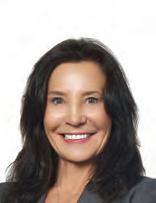
What Is an Equity Club?
Across the United States there are thousands of social and recreational clubs of virtually every shape and size, offering boundless combinations of facilities, activities, membership programs and member demographics.
However, from the perspective of legal structures, there are multiple variations, but really only two distinct alternative legal structures for clubs. The two structures are commonly referred to as “non-equity club” and “equity club.” So, exactly what is an equity club and why does it matter?
Interestingly, the concept of an equity club is one of the most frequently misunderstood concepts in club law. The confusion occurs because the concept of equity is most often associated with the equity held in one’s home, as in “the homeowner has X dollars of equity in the home.”
The most common understanding of equity is that it represents the dollar value of a property or an interest in a property in excess of claims or liens against it. Further, contrary to what many automatically conclude, the refundability of the initial payment paid in order to acquire a club membership, regardless of whether it is called initial capital con-
Michelle Tanzer, Esq. serves on the National Club Association board of directors, arbitrates club related disputes for the American Arbitration Association’s (AAA) National Golf Industry Panel and authored “The Club Litigation Book: Keeping Clubs out of Court.” Ms. Tanzer is chair of the global club and branded residences group at the law firm of Nelson Mullins Broad and Cassel and can be reached at (561) 866-5700 or via email: Michelle.Tanzer@NelsonMullins.com.
purposes. Thus, an equity club could offer memberships subject to the payment of a non-refundable initiation fee or a refundable capital contribution. In either case, such a club is still legally an equity club provided the three key requirements are met.
In contrast, a non-equity club is one that is owned by a sponsor, whether an individual or an entity and not by the members themselves, regardless of the refundability of any payments made to acquire a membership in such club and regardless of any voting authority members may have in limited circumstances.
However, classification as an equity club for legal purposes does not automatically exempt the joining payments paid by members from sales tax or income tax.
For example, in Florida, in order for joining payments to be properly exempt from sales tax, the club should be able to demonstrate that it qualifies for the exemption by virtue of its practices as well as its governing documents.
To meet each of the three requirements, the club needs to demonstrate that:
(i) a certificate of membership (or other similar proof of ownership) is provided to its members;
(ii) members have a right to vote and they exercise these rights, and (iii) upon dissolution, the assets are distributed to the qualified members or an organization exempt from federal income taxation or to a qualifying common interest realty association. See Florida Administrative Rule 12A-1.005 for further details.
As with most legal issues, the bottom line is to understand what type of club you are, make sure your documents accurately and properly reflect your intentions and objectives and seek guidance whenever needed from your trusted legal and tax professionals.
tribution, initiation fee, capital contribution, joining payment or other such name, does not determine the equity status of a club.
Rather, the status of an equity club hinges on three key requirements: (i) ownership interests in the club are held by the members, (ii) the members can vote on critical governance and operational matters, and (iii) members have an interest in the club’s assets upon dissolution or liquidation.
If a club meets all three of these requirements, it is properly categorized as an equity club for legal
The day-to-day practices of the club are as essential as the precise wording in the club’s bylaws and other governing documents. Similarly, in the case of equity clubs that are not tax exempt, beneficial income tax treatment will depend on proper financial and accounting practices, as well as the operative language in the club’s governing documents. Failure to meet the applicable requirements could result in an audit and potentially late payments and penalties.
As with most legal issues, the bottom line is to understand what type of club you are, make sure your documents accurately and properly reflect your intentions and objectives and seek guidance whenever needed from your trusted legal and tax professionals. BR
Melissa Low, CAE, is the senior director, communications & advocacy, for the Club Management Association of America. For the latest information on these and other issues affecting the club industry, please visit CMAA’s Legislative Report blog at www.cmaa.org/legislative.aspx.
Focus on State Trends
It’s been an interesting year as clubs and businesses faced unprecedented operating regulations at the local and state level, but two specific trends may prove beneficial beyond this public health crisis for club business and operations in the future.
Continuing to-go and off-premises alcohol consumption: During the COVID-19 pandemic and restrictions on in-person dining, many state laws were relaxed to allow for to-go and off-premises alcohol consumption. Now it looks like that trend could be here to stay for a while as state legislatures seek to provide continuing relief for hospitality businesses and restaurants.
According to the Distilled Spirits Council of the United States, more than 30 states and the District of Columbia allow some form of to-go, pick up, or delivery of cocktails or distilled spirits from restaurants or bars.
Here’s an overview of the states who considering measures to extend current regulations in 2020:
• Iowa – HF 2540 permanently allows the sale of alcoholic beverages and mixed drinks for carry out and delivery. The legislation was signed into law by the Governor on June 29 and became effective immediately.
• Michigan – HR 5811 extends carryout and delivery of alcoholic beverages, specifically cocktails to go, through December 31, 2025. The legislation has been signed into law.
• Ohio – HB 669, the Business Expansion and Safety Act would allow the sale of cocktails for takeout and delivery, permanently. The Ohio House passed this measure in early June and it is awaiting action by the Senate.
• Oklahoma – SB 1928 allows licensed restaurants and bars to continue delivery and curbside pickup indefinitely. The legislation was signed into law on May 21.
Additional efforts are underway in Florida, Texas, and the District of Columbia.
Legislation to require insurers to include COVID-19 damages in business interrup-

tion coverage: In the midst of COVID-19 beginning in March, legislation sprung up in multiple states requiring insurers to cover COVID-19 related damages under business interruption coverage.
Generally, this type of insurance coverage applies to physical property damage. Most insurers have deemed losses caused by pandemics as ineligible for coverage. Retroactive adoption could provide needed relief for businesses located within these states.
Here’s a high-level look at the legislation introduced, which we are tracking on ClubIndustryVotes.org:
• Massachusetts – MA SD.2888 would apply to businesses with 150 or fewer full-time-equivalent employees, be applied to all policies in effect during the declared state of emergency, and create a relief fund for insurers through the state commissioner of insurance.
• New Jersey – NJ A-3844 would apply to businesses with 100 or fewer employees, would be retroactive to policies in existence on March 9, and allow for the possibility of reimbursement of insurers.
• New York – NY A 10226 would apply to businesses with fewer than 250 full-time employees (defined as working 25 hours or more weekly), would be in effect during the declared state of emergency, would be retroactive to all policies in effect as of March 7, and includes reimbursement for insurers.
• Ohio – OH HB 589 would apply to businesses with 100 or fewer full-time employees (defined as working 25 hours or more weekly), be applicable to all policies as of the effective date, and create a state relief fund for insurers.
• Louisiana – LA HB 858 would apply to businesses with fewer than 100 full-time employees and would be retroactive to policies in effect as of March 11. The Senate version of this bill, S477, does not have a limit on the size of the employer.
• Pennsylvania – PA HR2372 would apply to businesses with fewer than 100 full-time employees (defined as working 25 hours or more weekly), be retroactive to policies in effect as of March 6, and include reimbursement for insurers.
• South Carolina – SC S1188 would apply to 150 or fewer full-time employees and be applicable for all policies in effect as of the state emergency declaration on date and includes reimbursement for insurers.
Coincidentally in April, two were introduced in the US House of Representatives that address business interruption insurance and coverage of pandemics, HR 6497 and HR 6494.
In HR 6494, the Business Interruption Insurance Coverage Act, Congressman Mike Thompson (CA-5) seeks “to make available insurance coverage for business interruption losses due to viral pandemics, forced closures of businesses, mandatory evacuations, and public safety power shut-offs, and for other purposes.”
The bill text does not indicate any application to the current crisis but would invalidate exclusions in existing coverage for future qualifying events. Both bills were referred to the House Committee on Financial Services, but no further action has resulted. BR
IDEAS
Starting Off On The Right Foot
Giving New Members a Friendly Face Since Day One

Picture this. Your members, old and new, attend a Zoom wine tasting, bartering to spend top dollar on a must-have item. But it isn’t wine. It’s a pair of socks! But not just any pair of socks.
Imagine seeing your face on the ankles of members everywhere from the driving range to the dining room. This is the reality for Kris Butterfield after creating what she has called Kris Socks.
It all started with her dogs, well, more accurately, her dog-sitter. Butterfield gave a pair of socks with her dog’s faces on them to the sitter after each stay,
“Just like that, a light switch turned on and I suddenly realized that when someone joins Bethesda Country Club, they should get a pair of Kris Socks!”
Now, if you go to the club in Bethesda, Maryland, you will receive a new member package along with a pair of socks bearing her face because Bethesda is a place “where every day starts off on the right foot, and you will always find a friendly face.”
The idea has been so well received, Butterfield says it’s not uncommon to get pictures of members wearing the socks in random locations accompanied by curious outfits and unforgettable poses.
Since she began there has been overwhelmingly positive feedback, saying that getting the socks is a pivotal moment for new members, the moment they smile with the realization they have joined the perfect club for them.
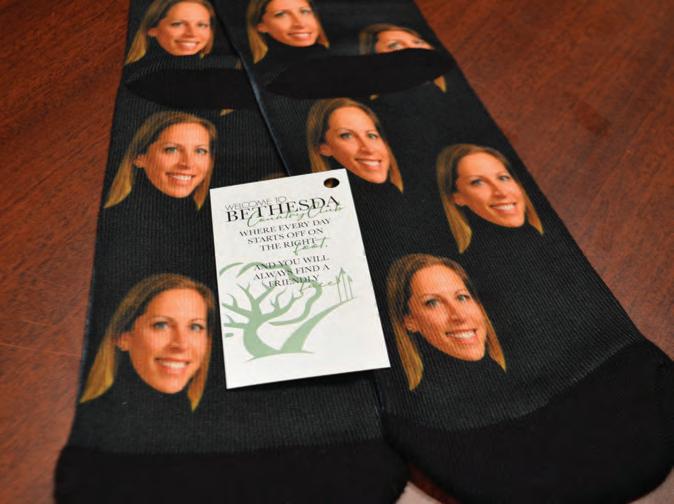
“I don’t want to take it too far, this might be too far, but it is that same genuine smile Tiger Woods beams when he wins the green jacket at Augusta.”
These socks haven’t just caught Bethesda members’ attention but also the eyes of many of Butterfield’s industry colleagues. It was featured in a CMAA marketing and membership summit and over 150 attendees completed a survey where many answered what they wanted to hear more about: Kris Butterfield and her Kris Socks.
“I love how this idea has encouraged other club professionals to kick it up a notch and make it a challenge to find that unique attribute at their club to promote.” Country clubs walk a fine line between staying traditional and being progressive. However, being progressive doesn’t mean the loss of tradition.
Even though socks may not be the fanciest or classiest welcome gift, it mirrors the fun, upbeat culture Bethesda is all about. BR

ELLERY PLATTS
Ellery Platts, Innovative Ideas editor, earned a Bachelor of Journalism (Hons) from the University of King’s College where she balanced her love for writing and photography with varsity athletics. An avid golfer, she has been in the club circuit since early childhood where she played as a member of Silver Springs Golf and Country Club, Calgary, AB.
To submit an idea or story for this section, please email ideas@boardroommag.com
Rogue Rescuers
Putting the Community First
Flames snowballed, spreading up the road towards the homes of nearly 1,000 seniors in Jackson County, Oregon. They sat in their homes, unsure of where they could go or what to do next until they reached out to a stranger in the community.
The Manor, a large retirement village in Medford, had been placed under a level three evacuation order by the Oregon Department of Forestry. They had to leave.
That day, early in September, Thor Damerval, general manager at the Rogue Valley Country Club, answered the call.
“We were able to open our doors, our hearts and our arms to make sure they were safe.”
The Almeda Drive Fire burned across 3,200 acres of land in just a week, taking down over 3,000 structures, resulting in three fatalities. Rogue Valley was closed that day, but as luck would have it, Damerval and a few colleagues happened to be there, able to answer the phone and leap into action.
“In a kind of frantic voice, they asked if we could take in any of their residents because the wildfires were getting close and they needed to save lives.”
Within 10 minutes, buses arrived at Rogue Valley, filled with senior citizens in their 80s and 90s who then poured through the doors.
“The phone kept ringing, and I kept saying ‘yes, bring more, bring more’, and it grew to about 440 people.”
Not only did the club welcome the Manor’s residents, but it also invited their furry friends.
In no time at all, the clubhouse was transformed into a temporary home-away-from-home. Damerval and his colleagues found any available space they could from the fitness center to the ballroom while pulling out any chairs and couches they could uncover. Rogue Valley staff even contacted club members for bedding so the seniors could comfortably stay the night. Members responded quickly. Everywhere you looked, mattresses, sleeping bags, blankets, pillows and pop-up buffets stocked with beverages, hot food and cold snacks were put in place to make the new residents comfortable.
“Throughout 22, 23 hours, we had probably the biggest slumber party that the club has ever had,” explained Damerval.
Fortunately, the seniors were able to return home the following evening after firefighters controlled the flames, which got within a few hundred yards of the Manor’s front doors.
Soon after, Damerval and the club received close to 150 letters of thanks from the residents expressing their gratitude for all the help and kindness they had received.


Even with the coronavirus at the forefront of everyone’s mind, community always comes first at Rogue Valley.
“We did our best with COVID-19 regulations during that time, but hey, it’s humanity and the virus kind of took a backseat when it came to just getting them out of harm’s way.”
Unlike the seniors, five Rogue Valley employees had their homes burn down in the fire. Once again, the membership came together, this time to support their own, raising close to $58,000 in a few short days. This gave the five staff the means to replace some of their possession with a little less worry.
The country club’s relief efforts didn’t end there. Not long after, they hosted a car show, raising an additional $60,000 for wildfire relief victims. Though September was an especially exciting, and honestly a nerve-wracking month, humanitarian work is nothing but common practice at Rogue Valley.

Damerval and his team work hard to achieve their goal of hosting at least one charitable event every single month, whether that be their annual five-kilometer run for teen mental health or various polar plunges in their pool during the winter months.
One thing the club has added to the schedule this upcoming season is an appreciation banquet and golf tournament for first responders. It’ll be held this upcoming spring.
“Hopefully, we will raise as much money as we can and give them a day of thanks for what they’ve done.”
That being said, we can all take a page from the Rogue Valley handbook and look for new ways to give back to our communities. But for now, the club is focusing on renovations and praying for a quieter next six months. BR
INNOVATIVE
IDEAS
Fishing Derby a Draw for Kids
To submit an idea or story for this section, please email ideas@boardroommag.com


It all starts in the spring when a truck arrives to stock the 12th hole pond with trout at the Silver Springs Golf and Country Club.
The trout pond is an integral part of the club’s Audubon initiative. Superintendent Lance Morris says the fish help reduce leech and freshwater shrimp populations that get into the irrigation and sprinkler systems.
After that comes a successful golf season, wrapping up in the fall with the highly anticipated fishing derby at the private club in Calgary, Alberta, Canada. The event welcomes kids, parents, grandparents and family alike to the pond for an evening of food, friends and fishing.
“It’s nice to introduce your kids to something new, or something you have enjoyed and want to pass down,” says Karen Roberts, the administrative assistant at the club. “Having a safe place to do so that’s in your neighborhood is a positive asset.”
It first began in 2017 when the green committee noted the high mortality rate for the trout in the pond each year. In hopes of making the best of the situation, they invited families to sign up, bring a rod, and catch a fish!
The club boasts around 190 junior members and about 80 participants enjoyed the derby this year.
Roberts hopes that some of the kids taking part today will bring their children someday while reminiscing about her fishing memories when she was young.
“Most of my holidays were spent camping and fishing with my dad so it’s nice to see that family connection hasn’t been lost on the generations.”
Gary Stevens played a significant role in getting the derby rolling.. He worked with his company, Assante Wealth Management, to fund food and
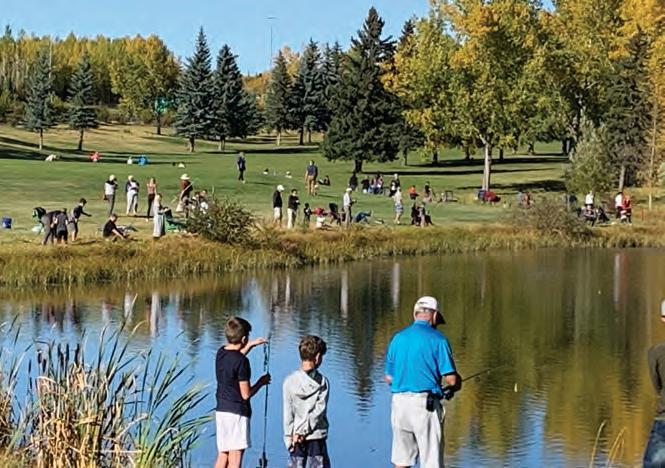
drinks for all the participants at the event while sitting around a fire pit.
Stevens understands that events like this create lifelong memories for families, especially during a year when socializing is limited. “The best part is watching the children, many of whom are catching their first fish.”
Not only does the derby improve relationships between family and friends, but it also improves the relationship the club has with the environment as part of the club’s Audubon program. BR
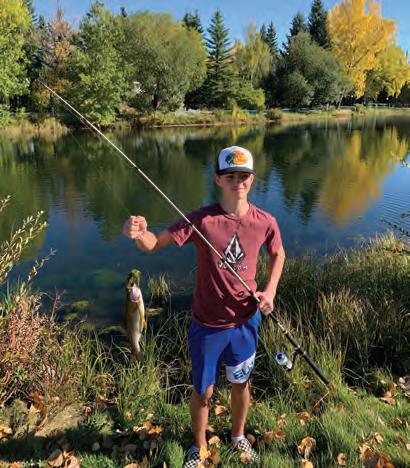
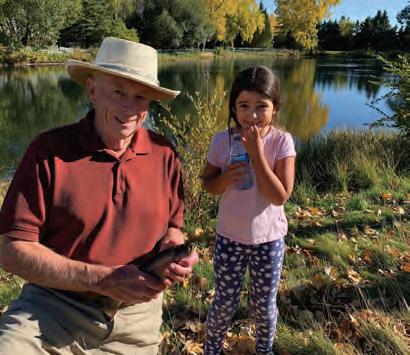
TOM NEILL
Tom Neill is president of Private Club Historical (www.ClubHistorical.com). His company creates strategic historical plans, discovers club history, designs historical exhibits, displays, books and historical videos. He may be reached at (949) 497-6543 or via email: tom@privateclubhistorical.com.

Foundations - Building Your Future
Just as colleges and universities enjoy the generous support of alumni, clubs, too can benefit from such tax-deductible donations from members. And why not?
Many members share the same passion for their club as they do for their alma mater. After all, most people attend university for only four years, while club membership can last for years. Why might a club need benefactors? Well, in general, clubs put their revenue into operating costs and maintenance, with little leftover for the creation, preservation and restoration of the all-important historical exhibits and displays that tell a club’s story and preserve its legacy.
But what if you could fully fund your historical displays and exhibits without assessments or due increases and offer your members the benefit of a tax-deductible contribution? It may sound too good to be true, but many clubs are taking full advantage of this opportunity allowed by the IRS by forming foundations.
How is this done? Gregory Nowak, senior counsel at Miller Canfield, explains, “Many private clubs are surprised to learn that they have the opportunity to establish a nonprofit foundation to help preserve their facility. They first have to qualify for the listing of their clubhouse on the Federal National Register for Historic Places, but this is not as difficult as it may seem.
E-SPRAY e1572
ELECTROSTATIC SPRAYER
HISTORICAL COMMITTEE
“Once they achieve that listing, there are some fairly straightforward steps they can follow to establish a nonprofit foundation that can receive tax-deductible contributions to preserve their clubhouse.”
Foundations are independent 501(c)3 organizations and, once established, can receive tax-deductible donations for the preservation, rehabilitation, restoration and reconstruction of the clubhouse. This also includes new historical displays and exhibits celebrating club history, including tributes to the surrounding grounds, members and other historical events. Because of the special tax status of foundations, all donations will only be used for these purposes.
“Since establishing our foundation in 2016, our club has raised over $2 million centered around preserving our historic
E-spray is a cordless, light weight, battery powered, hand held, ergonomically designed, electrostatic sprayer up to 10’ reach with an incredibly fine mist and electrostatic charge.
• Disinfect up to 1200 sq. ft. in under 10 minutes
• Up to 10 feet spray
• Light weight
• Hand held
• Ergonomic design
• Quiet
• Fast battery load
• Use on any surface not harmed by water
Additional Lithium Ion Batteries are available upon request


TRIBAL MAGIC

Recognizing Wonderful
Funky but Wonderful
GREGG PATTERSON
Gregg Patterson is president of Tribal Magic and can be reached via email: GJPAir@aol.com
I’m an old, geeky, retired club manager who learned a great lesson during my operational years –wherever you are, whoever you’re with, whatever you’re doing, however long you’re there, recognize the Wonderful. And be thankful.
Let me explain…………
I ran a small, funky, low-key club on the Left Coast for almost 34 years and loved the place, the job and the people. In the eyes of the world, my club was a no-name, not-inthe-headlines type of place. To the Big Boys of Clubdom it was a below-the-radar, run-of-the-mill, small time club experience.
But for me it delivered wonderful.
THE EYES TO SEE
The young, the hungry and the highly ambitious, those who’d heard me wax poetic about the wonderfulness of my funky little club, were anxious to understand WHY an old geeker like me loved managing – with undiminished enthusiasm – a no-name club like mine. So they’d call, visit, tour, touch, interview and gather up all sorts of in-depth observations.
And after all the touring got done, they’d ask me how I could see Wonderful in such a small place with such a small bank account filled with such ordinary people doing such routine things when bigger, better and more prestigious clubs could deliver gobs more wonderful than a club like mine could ever deliver.
I’d smile and tell them that I was blessed with the eyes to see the wonderful in where I was, what I was doing and who I was doing it with. I’d tell them that I saw, every day, the mountain of ideas, issues, insights and poetry beneath “what is.” I’d tell them that I saw the profound in the ordinary and the philosophy in the details. I’d tell them that I was blessed to see big fish where others saw minnows, to see the stories behind the stuff, the thinking behind the decisions and the journey from idea to action. It was wonderful!
And they’d give me the look.
I told them that big clubs, little clubs, no-name clubs and world-famous clubs all address the same big issues, from the why of clubdom to governance, operations, membership, staffing, leadership and creativity. I’d explain that all of these big issues were right there, on display, ready to be consumed every day. Wonderful!
They sniff and chuckle.
I’d tell them I loved people and found everyone, from busboys to billionaires, interesting and stimulating. I discovered that everyone was a novel, engaging and stimulating, waiting to be read. There was always another someone with a story to tell about their journey and their experiences and their insights. Wonderful!
Everyone was interesting? Really?
I’d tell them that the club, the staff and the membership made me feel wanted and needed. They gave me a sense of belonging to a special community of shared values and common purpose. Wonderful!
They’d smirk. Belonging?
I’d tell them that I was doing something meaningful every day. I helped bring happiness to the depressed, gave insights to the young, comfort to the old, support to the faltering, encouragement to the striving and a community of caring to all during turbulent times. And I discovered that delivering meaningful, regardless of where you are, is wonderful!
They shake their heads. Shared values and common purpose?
The club recognized me as me and appreciated the things that made me “me” and they encouraged me to pursue me. They let me bicycle to work, travel to strange places, teach in the university, write articles, play basketball, spank the tennis ball, attend seminars and read books because they knew I’d stay longer and do better if they affirmed ME. Wonderful!
And every day I felt blessed, grateful and filled with the wonderfulness of it all.
ANSWER ME THIS
At which point the highly ambitious and upwardly mobile would sputter,“Huh? Didn’t seeing wonderful diminish your ambition and submarine your journey to bigger and better? Didn’t you pass up more wonderful, with more money and a shinier badge, for an ordinary, down market club like this?”
I tell the upwardly mobile that some managers stay a long time at one club and others don’t but both can be happy if they have the gift of seeing wonderful wherever they are for however long they’re there doing whatever they’re doing. Wonderful!
You mean to say that this place, this job and these people are PERFECT?
I’d chuckle and respond. Never perfect, but wonderful nonetheless! I explain that I learned long ago that those who are looking for perfect – the perfect job, perfect spouse, perfect car, perfect house – are often blind to the wonderful in the here-and-now. I didn’t see, live or deliver perfect. But I experienced wonderful every day. Didn’t you have any bad members, bad boards, bad staff and bad days?
Absolutely, I experienced lots of bad during The Journey. But, whenever there was bad I reminded myself of the good and I always found, when I added it all up, that the goods always outweighed the bads. Wonderful!
What about all the big issue challenges managers experience in a big club – governance, finance, membership marketing, human resources, programs, tournaments, events, construction, neighbors, lawyers, the city and the state?
I tell them that small club managers deal with the same challenges as the big boys do. The size may be different but the issues are the same. Challenging-and wonderful!
What about all that education you’ve received, the MBA you earned, the seminars you’ve attended and the conferences you’ve consumed, that primed you to “think like a consultant. Isn’t it all wasted in a small time club like this?
Absolutely not! I tell them that we small timers are full time consultants who, as managers, are able to translate ideas into action. We have the opportunity, the responsi-
bility and the authority to make all those executive ed ideas happen. Wonderful!
What about the absence of “brain food”, of intellectual stimulation, in a funky little place like this?
I tell them that brain food was everywhere, in the endless and varied challenges, in the staff and committee meetings, in the walk-and-talk opportunities, in the White Papers that got written, in the government regulations digested, in the mentoring delivered and in the mentoring received. Big helpings of brain food were everywhere. Wonderful! I smile and sip my caffeine and say that at some point in life you recognize the wonderful that’s right there, in front of you, on display, ready to be seen and consumed. And you’re happy, content, at peace with where you are, what you’re doing and who you’re with for however long you’re there. They chuckle, give each other the look and think to themselves, this old geeker is whacked, brain dead and dumb as a rock if he sees wonderful here, now, in this place doing these things with these people. He’s smiling, laughing, reflecting and happy … unbelievable! A screw’s loose. And I chuckle…
RECOGNIZE WONDERFUL
I end our discussion with the bottom line. Wherever you are and for however long you’re there, recognize the wonderful. Forget “perfect.” See “magical.” Spread the joy. Be grateful. And enjoy the journey! BR
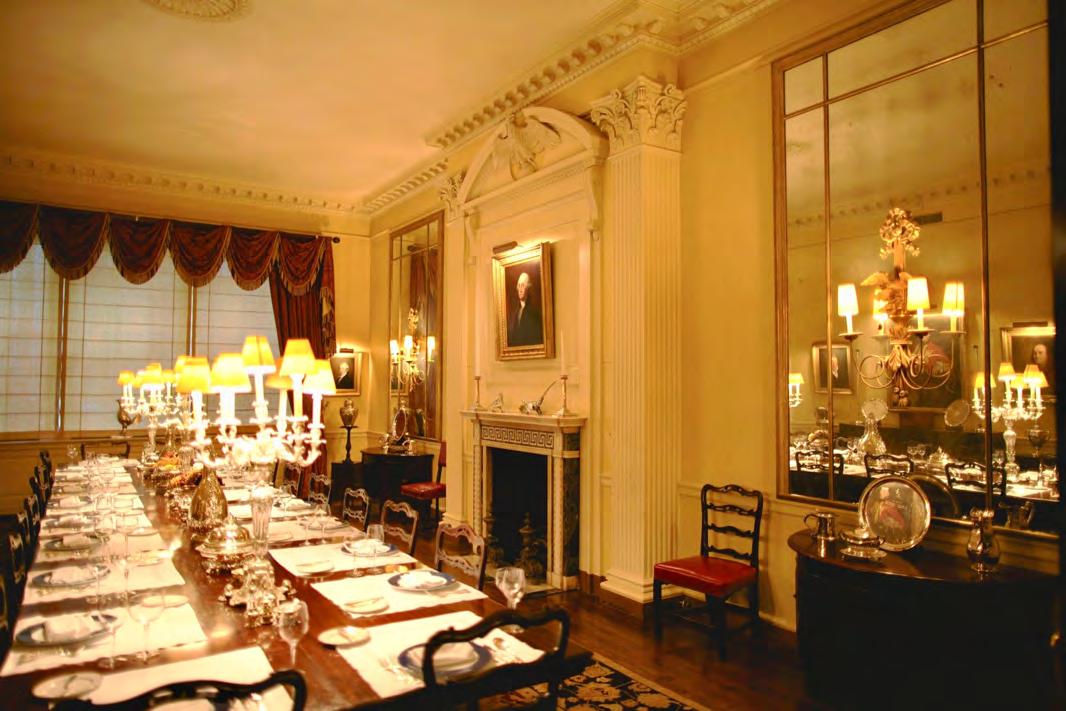
EXECUTIVE COMMITTEE
It’s About Time

While speaking with many general managers and chief operating officers recently, there’s been a theme among many of them, TIME.
There is enough to do on a normal day, but when you add in the time it takes to prepare for a board meeting, and it takes as long to prepare as it does for the meeting, well, that’s a lot of time! Time’s something we cannot get back, so we need to use it properly. Is four to six hours a bit lengthy for a “regular” board meeting? Well, it seems excessive to me.
I will give credit to a meeting with long-range planning issues or other time-sensitive matters, but for a normal board meeting, one to two hours is plenty of time.
But it also depends on the type of leadership the president extends. For example: As a young GM, I experienced a president who was fully in control of the meeting. In fact, most meetings were decided before we walked into the room. Committee chairs had discussed their reports with each other before the meeting and there was “an understanding.” These meetings lasted around an hour.
The next year we had a president who wasn’t in control. He wanted to discuss the issues at the meeting…he wanted everyone to be heard. These meetings, while they accomplished a great deal, took at least three to four hours. For me, it was very frustrating. How could the same board be so different? It’s the leadership style and intent of the board. By the way, the past president stopped coming to meetings!
I also believe under the first president the board was “intentional.” Board members had the president’s vision and direction for the year, and they knew what they needed to do. They knew the game plan.
The second year the president didn’t share his game plan and the board didn’t have direction, so the outcomes were accidental. With no game plan or guidance from the president, the board floundered, and we were discussing every little thing.
GORDON WELCH
Gordon Welch is president of the Association of Private Club Directors
If you or your club are having issues with your board meetings or are interested in a board orientation, please call me at (918) 914-9050. I would love to help!
Board members take note: The boardroom is not the place to decide what is on the menu; what tee markers you’re going to purchase, or what kind of flowers should be where! That’s micromanagement!
You have hired a professional staff to make those decisions and if you have functioning committees, they should make recommendations through the committee. The board’s responsibility is fiduciary – not daily operational issues.
QUICKER MEETINGS
So, here are some ideas on how to speed up your board meetings? Some ideas, while not always popular, work!
• Move evening board meetings to breakfast – most board members need to leave for work.
• Do not serve alcohol at meetings
• Do not serve dinner at meetings – serve it after the meeting for those that want to stay.
• Do send out all reports and financials a week before the meeting
• Do use a consent agenda
• Use a timed agenda
• Ask your board members to be prepared for the meeting when they arrive.
• Do not allow mobile phones in your board meetings. So, how long should a board meeting be?
The average normal board meeting should last one to two hours or less. This allows plenty of time to listen to recommendations from committees and act on them. Again, longer board meetings are signs of micromanagement and that’s when a club is in trouble. When trust is lost, the board will begin to question and micromanage. So, to review:
• The board president and GM/COO should put the agenda together
• Use a consent agenda to get through the minutia
• GM/COO should have a dashboard report that gives the board a quick overview of the operation
• The board members should remember their job is fiduciary and not operational
• Be prepared for all the board meetings – take it seriously!
• Arrive on time!
• Communicate with each other and with the GM/COO so everyone is on the same page walking in.
• Have all committee reports to the GM/COO at least a week before the board meeting
• Board presidents – Share your vision for the year and have some sense of control in the meetings!
There you have it: Nine simple steps to a quick and more efficient board meeting. BR
SUSAN GREENE
Susan Greene is 32-year veteran in the private club business. A master certified membership professional, she is a former national president of PCMA (Professional Club Marketing Association), vice president of membership and general manager. She is often called upon as an industry speaker and serves as the director of membership and marketing for The Oaks Club, Osprey, FL.
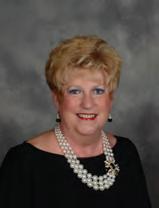
MEMBERSHIP COMMITTEE
The Pivoting Role of the Membership Committee And Membership Director
Remember when a membership committee’s role was to cooperate with the board and staff liaisons to provide advice and counsel on matters of membership recruitment and retention?
Well, that role hasn’t necessarily changed. However, the methods of accomplishing this role have pivoted dramatically this past year.
On the retention front, who knew we would be:
• Establishing a crisis communication plan:
- Should be detailed
- Should include key messages
- Should define a communications team
• Developing and prioritizing crisis communication channels:
- Videos
- Virtual town halls
- Social media
- Voice messages
- Website
- Employee messaging
- Pulse and survey generating
• Implementing a corresponding crisis action plan:
- Prioritize action plan
- Designate a timeframe of action
- Designate an “owner” of the action plan
• Who knew our committee would be tasked with:
- Socially distanced events, such as
> Virtual member mixers
> Food truck rallies
> Drive-in movies
> Parking lot bingo
> Puppy playdates
> Student learning and creating education spaces
• Virtual new member orientations and virtual i-Pad tours from the new member point of view
• Virtual programming ideas to reach into the home, such as
- Book clubs
- Virtual cooking classes
- Virtual wine taskings
- Virtual painting classes
- Facility clubs within the club outside the club’s walls
- “U” events, i.e., weather, technology, Zoom
• Creating Multi-generational services and programming:
- Car washes
- Virtual Magic shows
- Virtual Museum tours
- AARP virtual events
- Everbright virtual events
On the recruiting front, who knew we would be:
• Redefining our features and benefits: Safety and security: Director of Membership and Marketing Meg Stepanian of Estero Country Club says it best in that, “We are gatekeepers, no doubt.
But pre-COVID, we typically worked out ways to say ‘yes’ to as much as possible. With all the restrictions of these times, I find myself spending much more time each day saying ‘no’ to both prospects and members and having to explain why is a shift.
“Interacting is a lot less carefree and fun like everything else is now. However, this shift is also what maintains the safety and security our members want from the club.”
• Creating new age approval processes to include virtual introductions and membership candidate interviews
• Creating virtual tours for prospects
• Global interaction with members
• Adjusting our messaging just as: “Come visit the club” to “Let us spend time on our website exploring our club.”
The ability to pivot as a committee and a team makes “cents.” BR
MEMBERSHIP COMMITTEE
Internal Branding

Clubs are only as good as the employees that create and deliver the experience – a statement that’s never resonated more than during the past 10 months.
The unbelievable spirit, tenacity, creativity, passion and grit displayed by the range of professionals that characterize our industry is truly remarkable and profound.
Perhaps it stands to reason then, that a growing number of clubs realize the brand story told inside their club is as important as the one told outside.
According to a study by Harvard Business Review, “Fewer than 50 percent of employees believe in their company’s brand idea, and even less are actually equipped to deliver to on it.”
But why is brand worth talking about to employees? Because what starts within spreads throughout. For better or for worse. We’ve yet to come across a successful, thriving club where the members don’t recognize the employees as a critical part of what defines their club’s brand. Internal branding is just as important as external branding.
It’s worth noting that Millennials now make up the bulk of U.S. workers. And according to CNBC, 86 percent of Millennials surveyed said they would take a pay cut to work at a company whose corporate culture aligns with their own values. As a result, consistent internal branding is now critical for clubs looking to recruit new talent and retain current staff. The workforce dynamics in seasonal markets further underscore this need.
The fact is, employees have become consumers of internal brand identity. Just as consistent external branding can boost membership recruitment, consistent internal branding can help drive employee satisfaction.
The premise behind internal branding is this: Strong internal branding is vital to success because it ensures employees’ commitment to the club’s values and empowers them with an understanding of how to deliver on those values.
When employees care about and believe in the brand, they’re motivated to work harder while their loyalty to the club increases. Ultimately,
MIKE PHELPS
Mike Phelps is CEO and Co-founder of Pipeline, an agency specializing in branding for private clubs and communities. Visit www.pipeline.agency to learn about their services.
this is a critical part of the club’s culture, as employees are unified and inspired by a common sense of purpose and identity…they live and breathe the brand to bring it to life for members.
KEY INSIGHTS
Internal branding goes beyond communication, all the way to evolving employee behavior and club culture. The power of internal branding can be summarized in three points:
1. Internal branding helps cement employee commitment to the club.
2. It helps ensure alignment with club values and behavior.
3. It helps with recruitment, retention and relationships at every member touchpoint.
Branding starts from the inside. Employees must understand and embrace everything about the brand – the culture, customs, traditions, purpose, distinctions and overall brand positioning.
Consistency within translates to consistency among members and ultimately travels outside the gates. If employees don’t believe in the brand, will members?
IDEAS FOR INTERNAL CLUB BRANDING
In any internal branding initiative, begin with similar principles to an external branding initiative:
• Define the story (customs, culture, traditions, distinctions, positioning, purpose)
• Underscore the values
• Involve the employees
• Inform and persuade
Remember, the goal is not to communicate a series of facts but to persuade participants to embrace the brand story. Don’t overburden employees with reading materials and training information all at once.
Instead, focus on giving them the tools they need to live the brand. Connect it to your club’s history and the essence of your brand to clarify your message. Allow the principles of your external branding campaign to inform the internal process.
Start by taking them through an onboarding process that incorporates the tradition, culture, values, and club’s story. Think of how to involve your members and other longtime employees in the process and craft experiences to help employees learn about who your members truly are, why they joined the club and what makes the club special to them.
On an on-going basis, develop a key theme around which employees can rally…like an internal tagline or anthem. Employee incentives, career development training, social activities and even compensation models should all connect with and reflect the club’s internal brand.
Finally, keep in mind that an effective internal branding initiative requires significant effort and careful thought. It is a journey, not a oneand-done activity. Reach out if you’d like our help. BR
COREY SABAN
Corey Saban is co-founder of Newstation.com. A former Emmy nominated and Associated Press winning TV journalist Saban’s company serves as a virtual newsroom for all industries looking to use short form video to engage their clientele. To learn more, text the name Corey to 31996 or email him at CSaban@Newstation.com.
Understanding Gen X’ers
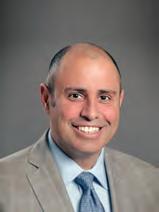
Big hair, rubber bracelets and acid-washed jeans. Move over Boomers…Generation X is moving in.
No longer a kid in his twenties or finding himself in his thirties, the youngest Gen X’er is now 40 years old (oldest is 54). It seems like yesterday, my peers and I were listening to Duran Duran and watching the A team, but here we are ready to do what our parents and grandparents did…. join a club.
Many clubs have adapted to our needs with more family-centric activities, looser dress codes and larger wellness areas. But before you get ready to mail your marketing materials blindly, it’s vital to understand who Gen X is and what they want, especially as it relates to communication.
There are 65 million Gen X’ers (me included) who are in the middle of their careers and peak earning years. We have older parents and younger kids. We are constantly looking for more time.
Our time is limited as we grow our business, navigate school activities, and figure out exactly what Medicare covers for our folks. We appreciate work-life balance, informality and are technologically adept. In fact, technology is vital to our success.
We’re not digitally native like the Millennial (the generation behind us). There was no Google to help us better understand Shakespeare; there was no Spotify for on-demand music. We had Cliff’s notes and sat anxiously watching MTV waiting for the one-hit wonder or hairband anthem.
As digital immigrants, we quickly adjusted to the new way of life, embracing the Commodore 64 and AOL.
Today, 92 percent of Gen X’ers own a smartphone (we spend 21 hours a week here, on average) while only 6 of 10 of us have a desktop computer, according to Pew Research.
Gen X’ers are on the go. We have multi-devices, so your marketing messaging and touchpoints should consider how we interact with your brand. For example, a text message or email will do better than a printed flyer. We like to read but are often not present enough to do so. Instead, we watch.
Gen X’ers are responsible for 1.5 billion daily views on YouTube. Our second favorite channel to engage with a brand or to find information is Facebook, says Pew.
We are the heaviest social media users of any demographic group. We hunt for content on a brand’s website and or app. That means it’s important for your club to be consistent across all media.
To do that, you should embrace video.
Video can be anything you want it to be. Many clubs have a long-form “about us” video on their homepage, but they fail to remember the importance of regular video communication.
This includes highlighting events, sharing your safety protocols, a president’s message, or even looking for new hires. Then you can and should integrate your videos into your app/website for ease of use and a more cohesive member experience.
While many clubs focus on Millennials, they skip over the needs of Gen X. Studies show that many are frustrated that brands ignore them, despite the fact that they hold a large portion of purchasing power.
Don’t make the same mistake. Boomers are here now, while Gen X will dominate your tomorrow.
Fortunately, Baby Boomers’ social media video habits are aligned with that of Gen X. Think by Google recently found that Boomers turn to YouTube to save time, get help and engage with a brand that keeps them plugged in. But unlike Gen X, older Boomers who struggle with disabilities will depend on written transcripts for the video, which also helps you stay ADA compliant.
How you market is everything, so don’t “diss” Gen X. Determine your value proposition. What makes you unique? Why should they join? Or regularly share “What’s in it for them?
If you try the video strategy, you will find it frees up time and allows you to communicate instantly. Do it yourself or hire an outside company to use Gen X old school terminology they will find “totally gnarly.”
This lets you appreciate their needs as they sit back and watch in their “cribs.” Here’s to your success, “home slice.” BR
HOUSE COMMITTEE
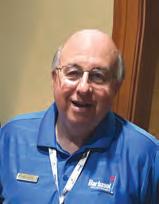
BRUCE BARILLA
Bruce Barilla has 20 combined years of golf locker room experience at The Greenbrier and Butler National plus 50 professional tournaments. He is president of Locker Room Consulting. www.lrcgolf.com
Tipping versus Non-Tipping
Generally speaking, I believe that clubs that don’t allow and clubs with automatic service charges can discourage good service and be unfair to the members and employees.
However, an employee should do a good job whether they get tipped or not. Their service shouldn’t be lax just because an automatic service charge guarantees their compensation. Unfortunately, human nature can set in.
NON-TIPPING
I remember a member telling me that his Florida club was instituting a non-tipping policy. He said the locker room attendants would begin to receive Christmas bonuses. My initial thought was, how much is the bonus? Is it enough to make up for the lost tip revenue? $15,000? $20,000? $40,000?
Some non-tipping clubs do allow employees to accept Christmas and birthday presents, which can be substantial. If an employee isn’t happy, they should discuss it with the manager, count their blessings or look elsewhere. Salary and benefits can be a larger sum than even if tipping is allowed. If so, there should be no lack of employment applications at this club.
FAIR TO MEMBERS?
Should members be told whether they can tip or not? Locker room attendants have told me that some members tip anyway and tell them to take the money. I worked at only one club that didn’t allow tipping. In my first week on the job, a member handed me a $10 bill. I told him I wasn’t allowed to accept tips. I believe he was testing me.
At the same club, one of the members gave a cart attendant $20 to show appreciation. The employee told him he wasn’t allowed to take tips. The member said, “Says who?! I own the place. Take the money.” If I were a member at a non-tipping club, I’d tip anyway. Even as a guest, I’ve done so. I feel like I’m hypocritical if I don’t, having made my living this way for so many years.
SERVICE CHARGES
A service charge isn’t a tip. A tip is voluntary while a service charge is not. It’s a forced fee, although if the membership agrees to it, then it is a policy. I can understand why dining room operations do such –easier for the members, no perceived preferential treatment towards employees getting the better tippers, which can cause disharmony
among staff, employee payroll cost savings and the IRS isn’t questioning whether income is declared or not.
However, what if the service isn’t what it should be? One manager says it doesn’t happen at his club. Good! But what if it did? I remember dining with my wife at a resort in Virginia. While the food was excellent, the service wasn’t up to par with the 18 percent the resort charged us. Now what?
It just didn’t seem worthwhile to say anything to either the server or the manager out of concern for an unpleasant ending to an otherwise lovely evening. Honestly, being allowed to decide if and how much to tip won’t inconvenience me.
FAIRNESS AND HONESTY
If “customers” are charged a specific percent automatically and it isn’t divided equitably amongst the staff providing the service, it’s very discouraging to the employees not receiving a fair share. It’s not right if the place of business also gets a percent along with the cost of the “product” even though the member or guest thinks it all goes to the staff.
Most of my locker room experience has involved tipping clubs. Some members made up for others. We did a good job either way. Was there ever “favoritism”? Once in a while when the best tipper came off the golf course, all he had to do was stick his hand through the crowd at the bar and his drink was ready. But you know, no one said a word. They understood why and respected the best tipper knowing it could just as easily be them – or you. BR
4. Set a high bar on hiring. Bezos once said, “I’d rather interview 50 people and not hire anyone than hire the wrong person.”
Club leaders should be equally diligent because the people who serve members – keeping them convinced that their club membership is an invaluable part of their lives –are their most valuable asset.
Align your hiring practices to your club’s mission and vision promises. Most clubs envision world-class capabilities but fall short of connecting their ambition to building a team of world-class leaders who can lead the organization toward its vision.
With roughly one-in-10 Americans currently unemployed, the talent pool is deep. Evaluate your club’s hiring practices challenge yourself to build the team worthy of your goals.
Create a leadership pipeline through which future club leaders will be developed. Move beyond the clumsy work of nominating committees, which place popularity and lesser characteristics ahead of one’s leadership capabilities. The leadership pipeline integrates carefully identified criteria for board service with the deliberate engagement of potential club leaders in rigorous preparation. Committee service is a key component of the leadership pipeline because effective leaders have demonstrated their capabilities and commitment through their actions. In practice, you’ll find that hiring better is its own reward.
It’s true that attitude reflects leadership. If you want to enjoy better attitudes in your club, lead better, starting with focusing on the long term, obsessing over customers, making bold choices and hiring world-class employees. It’s a formula that’s worked pretty well for Jeff Bezos. BR
• Offer more health dining options, including healthy choices (i.e., more salads, fruits) at the club and at home.
• Family meal programs – regular features in the club house.
• Exercise. Consult with a trained clinician and dietitian to boost nutrition knowledge to set S.M.A.R.T.E.R. Goals.
• Enhance use of the spa space and offerings including various massages, meditation and relaxation spaces. Update cardio equipment including machines with programmed routines.
• Add physical therapy to encourage work – life balance. Be the source of educational opportunities. Keep TALENT professional certifications current and up-to-date continuous learning. BR
Dr. SeungHyun “James” Kim, is associate professor, The School of Hospitality Business, Michigan State University; Dr. MiRan Kim, is associate professor, The School of Hospitality Business, Michigan State University; Dr. JaeMin Cha, is associate professor, The School of Hospitality Business, Michigan State University, and Dr. Ronald F Cichy, O.M., professor emeritus, Michigan State University
Four phases would never have worked. Bob was ultimately able to create two nine-hole phases — the first (the higher elevation holes) to be tackled at a cost of just under $4 million. The club used the membership boost to pay for most of that. We borrowed the rest and today we’re dismissing that debt with double payments. The second phase, tackling the lower-lying holes, may be undertaken as soon as 2021.
Sadly, Bob Bryant passed away from a lung condition early in December 2019. During the ensuing weeks and months, we witnessed an extraordinary outpouring of affection and professional respect for Bob. Today, as well as anyone, we at Anthem CC understand why.
Secondly, Heritage Links was chosen to interpret Bob’s design and physically install the new system. We couldn’t have made a better choice. They didn’t just keep eight of nine holes open throughout Phase 1. They also dealt directly with the homeowners’ association, with all the road crossings; they educated us on the merits of HDPE piping
and the hazards of friction loss. Most importantly, they did all this while keeping the old irrigation system patched up and running. And Heritage Links made it all appear entirely seamless. I recommend them highly. We still have Phase II to deal with, but we will do so from a much better place agronomically. Good thing, because post-lockdown, when things reopened last spring, golf was the only amenity available.
Our members exhausted the tee times. We typically do 2,900 rounds in June. In June 2020, we did 4,200! July and August were much the same. With solid irrigation as a foundation, the course could handle all that play.
The pandemic honestly worked in our favor in another way: For three solid weeks, the entire golf course was closed during the April lockdown. It grew back in so beautifully because of proper irrigation and so little traffic. (There’s another lesson for you: No matter how eager the membership, don’t rush resumption of play, post grow-in.)
The golf course has never looked better. The membership has never been happier. Bring on Phase II. BR
And with a surge of new members at nearly every one of our private clubs, we’ve recognized the need to connect them to their club and to one another or risk losing them again in the future. This same attention is being directed at associates as well, ensuring more than ever that the employee experience is mutually respectful among the team and in interactions with members.
As much as we may wish to learn that this pandemic was just a crazy dream brought on by a bad bump on the head, it has been and continues to be very real.
from Executive Committee - Pennell | 38
processes will need to change for the long run. Every club leader is looking for ways to minimize the number of physical ‘touchpoints’ in the member journey while providing high levels of personalized service.
Yes, our future is a puzzle, wrapped in a mystery, inside an enigma. Clubs are rarely given such a tremendous oppor-
from Executive Committee - von Ruexleben | 40
Venice Golf and Country Club’s General Manager Jim Schell had long pursued the goal of a sustainable club. Venice GCC is one of very few clubs in the world that is actually CO2 negative.
Discussing the impact of being sustainable during a pandemic, Jim says: “We were able to reduce our expenses for utilities, irrigation, fertilizer, pesticides and trash by such a large margin that we are well prepared for even longer periods of no – or low – revenues from our operation. Le-
from Food for Thought | 64
variances for key items – items that are expensive to lose or items that are purchased at higher volumes than others.
It’s possible to track these key items frequently – even daily if necessary – to determine how much was used versus how much should have been used.
This is a simple process for an automated system if the right data is collected (inventory, purchases and sales). Since 20 percent of the items represent 80 percent of the
Our clubs have survived the flying monkeys of COVID-19 because of the collective and hard-earned knowledge that comes from going through the experience together, not because of ruby slippers or a mustached man behind a curtain. And, as it turns out, having brains comes in handy. But so does having heart and courage.
So, we’ll continue to carry on, knowing that we now have proof beyond a reasonable doubt that our true overarching business principle is and always will be our ability to make people happy. We are humbled and feel fortunate every day to be able to do what we do. BR
tunity to reimagine their future with majority support from members. Clubs with thoughtful, trusted, innovative leadership are thriving, crafting strong teams. These clubs have a unified mission and set of goals from top leadership to the line level employee.
What a wonderful key to the mystery we may have if only we reframe the opportunities presented by this challenging time. How will you be remembered? BR
veraging the Vivid Leaf platform, we continue to pursue opportunities to save and becoming even more efficient and sustainable.”
Medinah Country Club in Medinah, IL, another sustainable club on the Vivid Leaf platform, has long employed a food truck for mobile, outdoor dining options. It has its own chicken coop and vegetables, all of which came in handy during this Pandemic.
Clubs can now share their approach to resilience on the Vivid Leaf mindshare platform (and what they did for their members) with other clubs, just as they do today for sustainability best practices. BR
food cost, tracking a small number of key items will significantly impact getting closer to ideal.
Even the best software will be unable to calculate your perfect food and beverage costs accurately, but it can help you get close to it. Actually, the software won’t get you close to it, but combining the processes and good quality data along with insightful analysis of resulting reports will.
And with the way things have been going this year, there could not be a better time to get closer to ideal. BR
from Historical Committee | 93
Clubhouse built in 1929. Our members have not only benefited by a tax-deductible contribution to the foundation but have seen first-hand the ongoing preservation of our clubhouse,” commented Aaron Wagner, general manager of Grosse Pointe Yacht Club in Grosse Pointe Shores, Michigan.
Clearly, establishing a foundation is a win-win for the club and its members as both benefit from preserving the club’s legacy for future generations. Member participation in a club foundation creates a positive feedback loop, as they help create something special, build club pride, and aid in member retention and growth. BR
For a more detailed step-by-step process of starting a Foundation, visit www.privateclubhistorical.com/foundations.



“The biggest hurdle we face is a basic awareness of what we do. We first have to sell people on considering the concept and not dismissing it out of hand.
“Secondly, we have to prove that we have the expertise to deliver what we say we can deliver. This part is the easiest. Retention rates are very high with long term and happy customers. They are our best marketers,” Pieschala added.
“Finally, there’s an emotional aspect to the decision to outsource. People feel ‘I’ll lose control over what is our core asset’, but most of our customers tell us after six months that they feel much more in control with us because we have a clear plan, we communicate well, and we collaborate.”
The evolution of golf maintenance continues today as both individual superintendents and companies like BrightView face many of the same issues, such as labor costs.
“Most of the labor staff on a golf course is unskilled to semi-skilled where people are working a mower, trimmers…doing things like that,” Pieschala said. “With movement to increased minimum wages, labor is more expensive. Even in places where there’s no minimum wage increase, labor costs are still growing.”
BrightView maintains golf courses in some of the country’s biggest markets, including California and Florida, where the golf course workforce has shrunk dramatically. Workers are unavailable, in part, because of government policies and rules. There’s also a whole transition happening in the nature of the workforce available to maintain golf courses. Labor is more expensive and harder to find,” Pieschala explained.
“We have a generation coming up that doesn’t want to work on golf courses their whole life. It’s not the kind of workforce where employees look at it as a career. There’s no large labor force of future 25-year career people and as those current career employees retire, where are other labor pools to replace them?” Pieschala questioned.
BrightView taps broad elements of the labor markets. “We use a lot of part-time people, including retirees, students, and members of the military among others. These are people looking for part-time work, not people who need full-time work and are settling for part-time.
“But, to integrate such employees, you need to redesign work, for example, having an employee who just mows greens and then goes home. Another may just rake bunkers. You need to have strong training resources to sustain such a workforce and better management practices, but they can be among the most highly productive team members.”
Managing productivity becomes increasingly important in this type of market.
“Very few people talk about managing labor productivity. In golf maintenance, we employ a ‘lean management’ approach to designing and scheduling work. As a result, we use substantially fewer labor hours to accomplish the same amount of work than the average course.
“The more efficient you are, the more the relative advantage you have increases as labor becomes more expensive and harder to find. So, we manage to maximize our productivity and use processes to manage our teams. We have scale. We know how to source and we save clubs money
by people being highly productive while producing better conditions,” Pieschala emphasized.
“Putting out a superior product is a must and our expertise infrastructure is not only very efficient in terms of cost, but also in terms of conditions that are more competitive, resulting in high member satisfaction and retention.
“We make significant improvement in conditions and that often means new members. One course we just started working with has gained 18 new members already this year,” Pieschala related.
So, what is BrightView’s standard for greens? “There is no ‘BrightView’ cookie-cutter standard. It’s our job to deliver what the club wants to satisfy and maintain its members. We have partner clubs looking for a true roll but moderate green speeds to suit their membership. Others want them fast, fast, fast because of the wants of their members.
“Our job is to understand what the clubs aspire to and what will attract and retain members, given the resources available,” Pieschala said.
“We also streamline operations,” Pieschala injected. “We offer world-class safety, lowering our workers’ compensation cost and we try to think financially from a director’s point of view. The maintenance team members all work for us and we have human resources and benefit infrastructure to serve our people well. We take all the administrative and liability issues related to the course and golf course maintenance off the board’s plate.
“We are fortunate to have a parent, BrightView Holdings, which is listed on the NYSE and has strong financial resources. A lot of clubs have deferred improvements. They may not have had the capital needed for improvements. This risks a ‘downward spiral’ and the course and conditions suffer.
“We can help our partners create a manageable capital plan and potentially spread payment over a contract term at zero interest. If the club has $100,000 a year for improvements, we can help them invest $500,000 in the course today and then pay us back over the term of the contract. So, the improvement can be done in a big bang way, so people go wow… things are really improving, we’ve got the bunkers fixed, rather than spread out the work over a longer period of time.
“We want our partners to thrive. Their success rebounds to us and we want them to be a winner.” BR
relationship is as collaborative and effective as possible.
“The green committee also provides a valuable viewpoint. Committee members provide the superintendent with a golfer’s view of the course, and the superintendent wants to hear that perspective. So, committee members should take the time to get to know the superintendent and their staff,” Evan added.
“With an open line of communication, where committee members share their positive thoughts as much as their concerns, the committee will have a better understanding of the complexities and myriad factors that influence the superintendent’s management practices and long-term planning. As a benefit of creating this open dialogue, the superintendent will better understand their club members’ needs and expectations. Two-way communication is key,” Evan stressed.
“For new committee members or those who need a refresher, the superintendent can provide an orientation on how and why course maintenance procedures take place. From there, the superintendent should give regular updates. Likewise, the committee should provide clear direction to the superintendent when the committee reaches a decision or come to a consensus on actionable items.”
Evans amplified his thoughts. “One thing club members don’t like is when they are unable to access the course or certain holes. Frost delays, aerification, new or overseeded turf, and renovation projects are all situations when the course may need to close for a while. Understand that superintendents don’t like to close the course either because they understand both the economics of the facility and the value in keeping the members happy.
“However, when it is necessary for the course to close, it’s because they are applying sound agronomic practices that will keep the course healthy. A delay or closure now means better playing conditions for years to come. Green committee members should be an advocate for the
1. Establish maintenance standards for the golf course to be implemented by the golf course superintendent.
2. Assist the club and the superintendent in establishing and adhering to an annual budget for golf course maintenance to enable the successful achievement of the maintenance standards.
3. Convey important golf course maintenance and operations information to the membership in regular updates
4. If the club has a master plan, developed with a golf course architect, be able to understand and articulate that to membership. If there is no master plan, push to select an architect that understands the design intent of the club and establish a master plan immediately.
5. Develop long-range plans for the golf course, making sure to incorporate the master plan for any design changes. Long-range plans should include identifying various course components that will need replacement over time- such as irrigation system, tee box leveling or enlargement, equipment purchases, bunker renovation, maintenance facility upgrades, to name a few. The green committee should work with the finance committee to establish reserve funding for the club’s future needs.
6. Understand the issues that affect golf course maintenance on a broad level at your golf course- labor, weather, soils, water, trees, turf disease- but do not feel the need to manage daily or weekly activities on the golf course that are the golf course superintendent’s responsibilities.
7. Establish regular monthly meetings led by the golf course superintendent to provide updates on maintenance standards, upcoming maintenance activities, special projects, and environmental issues affecting the golf course.
8. Listen to both individual membership and group concerns at the club. Be prepared to discuss these at meetings, with the understanding that not all concerns can be met but that they can be heard!
9. Ensure that the club addresses all environmental regulations, issues, and concerns from Federal, State and local agencies.
KevinNeal,vicepresident,BrightViewGolfMaintenance


superintendent and help other club members understand that these practices are vital for the long-term life of the golf course. The committee and superintendent can work together to develop a communications strategy,” the GCSAA CEO explained.
Communication between the committee and the superintendent is vital, as is a working relationship with the club’s general manager, green committee members and board of directors.
“The green committee serves in an advisory capacity to the director of agronomy and the general manager regarding the deployment of board directives and capital projects. And it also functions as a filtered membership feedback mechanism, so members have a voice regarding course maintenance and conditions,” explained Manchester Country Club’s Larrivee.
“At clubs that use the true general manager concept and committee system, all three must work together and communicate well,” said BrightView’s Neal.
“The general manager acts as the golf course superintendent’s supervisor and the Green Committee is an advisor. The GM and superintendent should meet regularly – I recommend weekly – with at least one monthly tour of the golf course. The superintendent keeps the committee informed of course management in regular monthly meetings, and the general manager should receive reports from these meetings from the superintendent,” he added.
GCSAA’s Evans suggests other factors are affecting the decision making.
“While the superintendent may report to the committee or your club’s board of directors, it’s important to understand that they have other governing bodies that are also impacting their agronomic decisions. In recent years, increasing regulatory actions have, in particular, affected the way superintendents irrigate the course and the inputs they can use to fertilize or control pests or diseases,” he commented.
“Superintendents follow established best management practices to make sure they are providing the best playing conditions possible; within the constraints of the regulations they must follow. Sustainable practices are good for the course, the community and can also help the club’s bottom line. Committees should take the time to better understand the constraints the superintendent must work with and how they are able to provide great conditions even under those constraints,” Evans added.
“Regulations, turfgrass varieties, and water availability may vary from state to state and from city to city. Maintenance budgets around the country, and even between clubs in the same town, can vary greatly. So, while committee members or club members may be amazed at the conditions seen on televised golf events who ramp up course conditions for the week of the tournament, don’t assume that those conditions are feasible at your club. Make expectations realistic for your club’s budget and geographical area,” Evan recommended.
THICK SKIN REQUIRED
“The increased awareness of environmental issues that we are facing has been the single biggest evolution,” injected BrightView’s Neal.
“Whether it’s water as a resource, managing fertilizer and pesticide inputs (Roundup, as an example), wildlife management, effects on pollinators, or other specific environmental challenges, golf courses are under more scrutiny than ever before. Clubs must be much more aware of their impact on the environment and the green committee needs to act as an advocate for the club to ensure that they are protected.”
One thing’s for sure: “Membership on a green committee requires having a thick skin,” Neal opined.
“Tough decisions must sometimes be made regarding disruptive and expensive projects on the golf course and the committee members must have strength in their convictions when practices such as aerification, tee renovation, or tree removal impact play.
“At the same time, the green committee must be able to listen to membership concerns so it can provide an appropriate response. This is when a master plan for the golf course design, a strong set of golf course maintenance standards, and a written long-range plan detailing improvement shows its worth. Being able to address demands in the context of these club-approved documents will prevent spur of the moment decisions that could have negative impacts in the long term,” Neal emphasized.
PUBLISHER’S FINAL THOUGHTS
Effective and constant communication with the membership is critical, especially when considering course conditions and future golf course plans.
The green committee chair should understand that the club generally has an array of players of many different abilities. In setting golf courses maintenance standards, they need to consider how various playing conditions affect players.
Complaints and grievances often seem small until they are overlooked, so there should be an attempt to diffuse these situations in a direct and timely manner. We must keep in mind that many golf courses developed years ago were designed for mid-teen handicap golfers, men, and over 60 years of age. Now many of the new golf courses are more challenging, longer and many more bunkers and water holes.
The club’s and the superintendent’s challenges are these: How do you design, redesign and manage the playability of a golf course for multiple members with different skill sets or abilities?
For example, younger members prefer deeper bunkers; many senior golfers prefer less depth and mid golfers prefer average bunkers. Younger members and better golfers prefer fast greens, while many higher handicappers prefer slower greens.
All I know is, I would never want to be a golf course superintendent. How do we satisfy the needs and wants of every member
and their different abilities? It’s also essential that the green committee chair respect the superintendent and their work to make the course the best it can be for the club’s members.
Lastly, sustainability, as outlined in our cover story (Sustainability… The Time Has Come!) in our September/October BoardRoom, must be top of mind. And this is attracting an even greater focus because what’s good for private clubs is also good for our environment, communities, and people.
In that story, as explained by Hervé Houdré, a principal with H2 Sustainability Consulting, the term ‘Triple Bottom Line of Profit, People and Planet, as explained by the English author John Elkington, in his book, Cannibals with Forks, offers businesses a very simple, yet extremely efficient, sustainable strategy model.
As Hervé says, “We realize that focusing on energy efficiency, water consumption and waste management, while developing partnerships with local or international organizations, helps companies reduce their expenses and improve their image and revenue.”
That means the triple bottom line master plan can be integrated into all business strategies, including those of private clubs. This also means that the top of a club’s governing pyramid( the board and general manager and Green Committee chair) is committed to such a strategy.
This includes the green committee chair working with the golf course superintendent on ways to 1) to conserve water and 2) create more energy efficiency, including ways to reduce electricity for the golf carts and 3) waste management.
Bottom line: This may mean looking at new technologies that will increase efficiency while also reducing staff, all to the benefit of the club’s members and our club communities.
At least, that’s the way I see it. BR
John G. Fornaro, publisher






KE CAMPS

The Country Club Summer Camp
Have a camp already or want to create one from scratch? Offer the best amenity for your membership...and let KE Camps do the work!
Our all-around camp program operates alongside your junior programs, not in competition with them.

WWW.KECAMPS.COM
DAN@KECAMPS.COM





Thinking of replacing your club management software? Think again!
If your club accounting and POS software is 7, 10 or even 15 years old, you may be thinking of making a change. So were many of our club clients, who hired us to help them make that decision. Surprise! After a thorough needs assessment, 7 of 10 clubs decided to retain and improve their existing software. Money saved. Business interruption avoided. To learn more, contact us.
400+ CLUB CLIENTS - 30 YEARS OF EXPERIENCE.


(561)281-0459 • bboothe@boothegroup.com www.boothegroup.com
(561)281-0459 • bboothe@boothegroup.com www.boothegroup.com













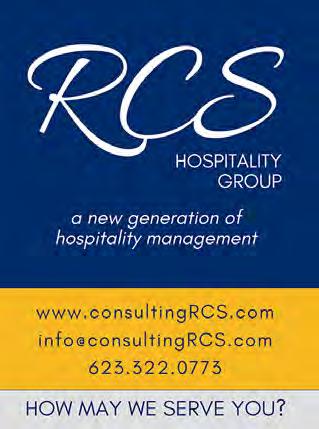










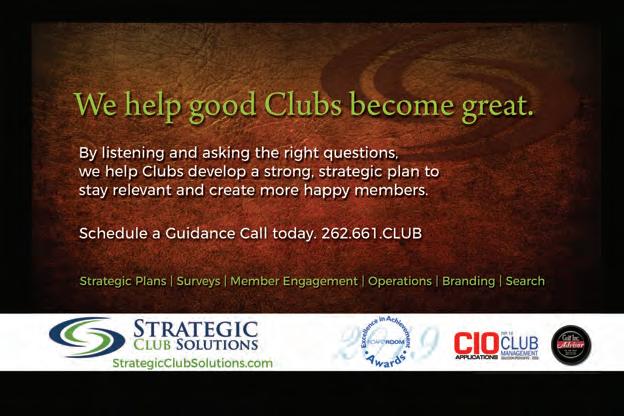


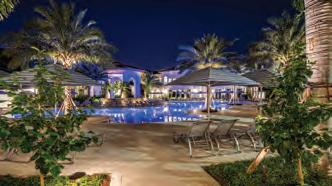
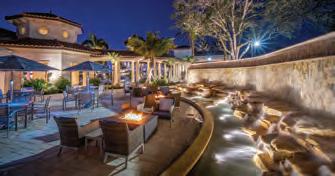

Patty Ashbrook, GM/COO, Forest Highlands Golf Club, Flagstaff, AZ
Todd Beals, GM, Midland Country Club, Midland, MI
Nancy Berkley, green committee and marketing committee, Frenchman’s Creek Beach & Country Club, Palm Beach Gardens, FL
Kris Butterfield, Bethesda Country Club, Bethesda, MD
Shelley Caiazzo, general manager, Anthem Country Club, Henderson, NV
Jarrett Chirico, USPTA,PTR, PPTA,PPR, director of racquets, Baltimore Country Club, Baltimore, MD
Nicole Coughlin, events coordinator, Superstition Mountain Golf and Country Club, a BoardRoom Distinguished Club, Gold Canyon, AZ Country Club of Roswell in Atlanta, GA
John Crean, GMr, Broken Sound Country Club, Boca Raton, FL
Thor Damerval, GM, Rogue Valley Country Club, Medford, OR
Boris Fetbroyt, USPTA, PTR, CTPS, director of tennis, Country Club of Fairfax, Fairfax, VA
Dr. Bonnie Knutson, the Country Club of Lansing and the Michigan Athletic Club
David Larrivee, green committee chair at the Manchester Country Club, Bedford NH
Nancy Levenburg, member, Spring Lake Country Club, Spring Lake, MI
Medinah Country Club, Medinah, IL
Lance Morris, superintendent, Silver Springs Golf and Country Club, Calgary, AB, Canada
Dave Moyer, USPTA Master Professional and the director of tennis, The Country Club at DC Ranch, Scottsdale, AZ
Karen Roberts, admin. assist., Silver Springs Golf and Country Club, Calgary, AB, Canada
Jim Schell, GM, Venice Golf and Country Club, Venice, FL
Jim Steinmeyer, president, Academy of Magical Arts, Hollywood, CA
Richard E. Straughn, president, Mountain Lake Country Club, Lake Wales, FL
Steven Sunshine, Shady Canyon Golf Club, Irvine, CA
Steve Berlin



